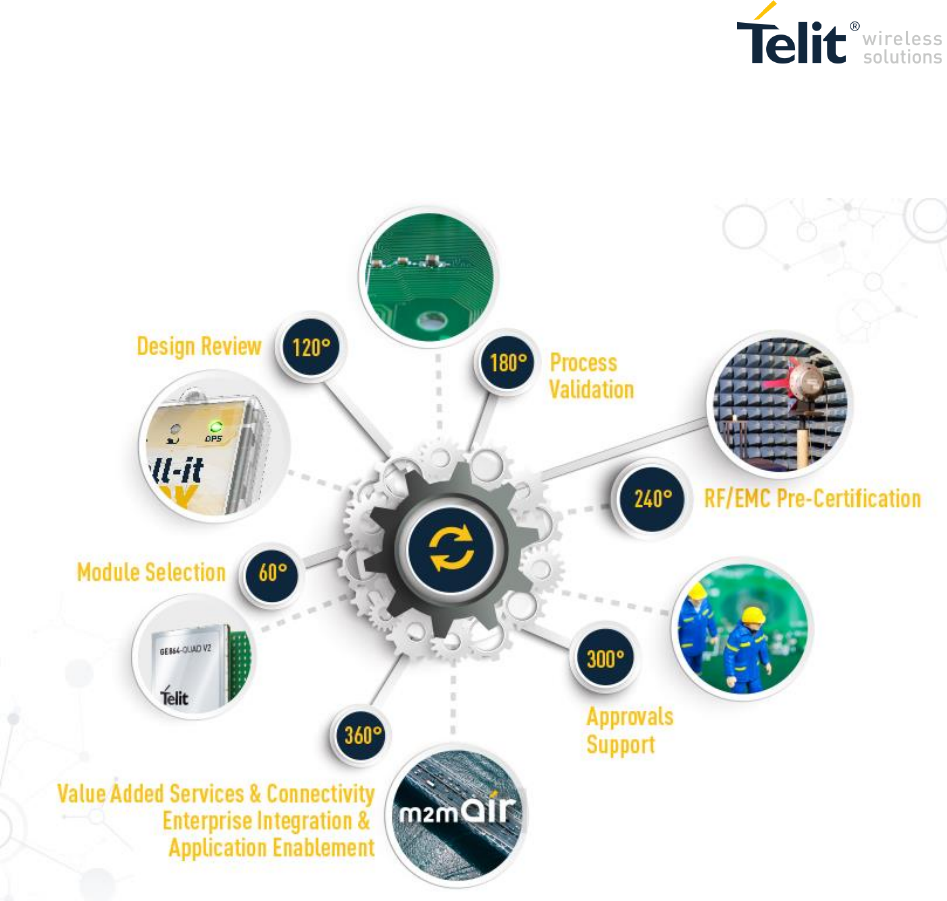Telit Communications S p A LE866SV1 LTE Module User Manual LE910 V2 Hardware User Guide
Telit Communications S.p.A. LTE Module LE910 V2 Hardware User Guide
HW user guide

1vv0301210 Rev.1 2015-09-02
LE866 HARDWARE USER GUIDE
PRELIMINARY

LE866 HARDWARE USER GUIDE 1vv0301210 Rev.0 – Preliminary • 2015-09-02 2 of 68
Reproduction forbidden without Telit Communications PLC written authorization – All Rights Reserved
APPLICABILITY TABLE
PRODUCTS
LE866-SV1

LE866 HARDWARE USER GUIDE 1vv0301210 Rev.0 – Preliminary • 2015-09-02 3 of 68
Reproduction forbidden without Telit Communications PLC written authorization – All Rights Reserved
DISCLAIMER
LEGAL NOTICE
These Specifications are general guidelines pertaining to product selection and application and may not
be appropriate for your particular project. Telit (which hereinafter shall include, its agents, licensors and
affiliated companies) makes no representation as to the particular products identified in this document
and makes no endorsement of any product. Telit disclaims any warranties, expressed or implied, relating
to these specifications, including without limitation, warranties or merchantability, fitness for a particular
purpose or satisfactory quality. Without limitation, Telit reserves the right to make changes to any
products described herein and to remove any product, without notice.
It is possible that this document may contain references to, or information about Telit products, services
and programs, that are not available in your region. Such references or information must not be
construed to mean that Telit intends to make available such products, services and programs in your
area.
USE AND INTELLECTUAL PROPERTY RIGHTS
These Specifications (and the products and services contained herein) are proprietary to Telit and its
licensors and constitute the intellectual property of Telit (and its licensors). All title and intellectual
property rights in and to the Specifications (and the products and services contained herein) is owned
exclusively by Telit and its licensors. Other than as expressly set forth herein, no license or other rights
in or to the Specifications and intellectual property rights related thereto are granted to you. Nothing in
these Specifications shall, or shall be deemed to, convey license or any other right under Telit’s patents,
copyright, mask work or other intellectual property rights or the rights of others.
You may not, without the express written permission of Telit: (i) copy, reproduce, create derivative works
of, reverse engineer, disassemble, decompile, distribute, merge or modify in any manner these
Specifications or the products and components described herein; (ii) separate any component part of
the products described herein, or separately use any component part thereof on any equipment,
machinery, hardware or system; (iii) remove or destroy any proprietary marking or legends placed upon
or contained within the products or their components or these Specifications; (iv) develop methods to
enable unauthorized parties to use the products or their components; and (v) attempt to reconstruct or
discover any source code, underlying ideas, algorithms, file formats or programming or interoperability
interfaces of the products or their components by any means whatsoever. No part of these
Specifications or any products or components described herein may be reproduced, transmitted,
transcribed, stored in a retrieval system, or translated into any language or computer language, in any
form or by any means, without the prior express written permission of Telit.

LE866 HARDWARE USER GUIDE 1vv0301210 Rev.0 – Preliminary • 2015-09-02 4 of 68
Reproduction forbidden without Telit Communications PLC written authorization – All Rights Reserved
HIGH RISK MATERIALS
Components, units, or third-party products contained or used with the products described herein are
NOT fault-tolerant and are NOT designed, manufactured, or intended for use as on-line control
equipment in the following hazardous environments requiring fail-safe controls: the operation of Nuclear
Facilities, Aircraft Navigation or Aircraft Communication Systems, Air Traffic Control, Life Support, or
Weapons Systems (“High Risk Activities"). Telit, its licensors and its supplier(s) specifically disclaim any
expressed or implied warranty of fitness for such High Risk Activities.
TRADEMARKS
You may not and may not allow others to use Telit or its third party licensors’ trademarks. To the extent
that any portion of the products, components and any accompanying documents contain proprietary and
confidential notices or legends, you will not remove such notices or legends.
THIRD PARTY RIGHTS
The software may include Third Party Right software. In this case you agree to comply with all terms
and conditions imposed on you in respect of such separate software. In addition to Third Party Terms,
the disclaimer of warranty and limitation of liability provisions in this License shall apply to the Third
Party Right software.
TELIT HEREBY DISCLAIMS ANY AND ALL WARRANTIES EXPRESS OR IMPLIED FROM ANY
THIRD PARTIES REGARDING ANY SEPARATE FILES, ANY THIRD PARTY MATERIALS INCLUDED
IN THE SOFTWARE, ANY THIRD PARTY MATERIALS FROM WHICH THE SOFTWARE IS DERIVED
(COLLECTIVELY “OTHER CODE”), AND THE USE OF ANY OR ALL THE OTHER CODE IN
CONNECTION WITH THE SOFTWARE, INCLUDING (WITHOUT LIMITATION) ANY WARRANTIES
OF SATISFACTORY QUALITY OR FITNESS FOR A PARTICULAR PURPOSE.
NO THIRD PARTY LICENSORS OF OTHER CODE SHALL HAVE ANY LIABILITY FOR ANY DIRECT,
INDIRECT, INCIDENTAL, SPECIAL, EXEMPLARY, OR CONSEQUENTIAL DAMAGES (INCLUDING
WITHOUT LIMITATION LOST PROFITS), HOWEVER CAUSED AND WHETHER MADE UNDER
CONTRACT, TORT OR OTHER LEGAL THEORY, ARISING IN ANY WAY OUT OF THE USE OR
DISTRIBUTION OF THE OTHER CODE OR THE EXERCISE OF ANY RIGHTS GRANTED UNDER
EITHER OR BOTH THIS LICENSE AND THE LEGAL TERMS APPLICABLE TO ANY SEPARATE
FILES, EVEN IF ADVISED OF THE POSSIBILITY OF SUCH DAMAGES.
Copyright © Telit Communications PLC.
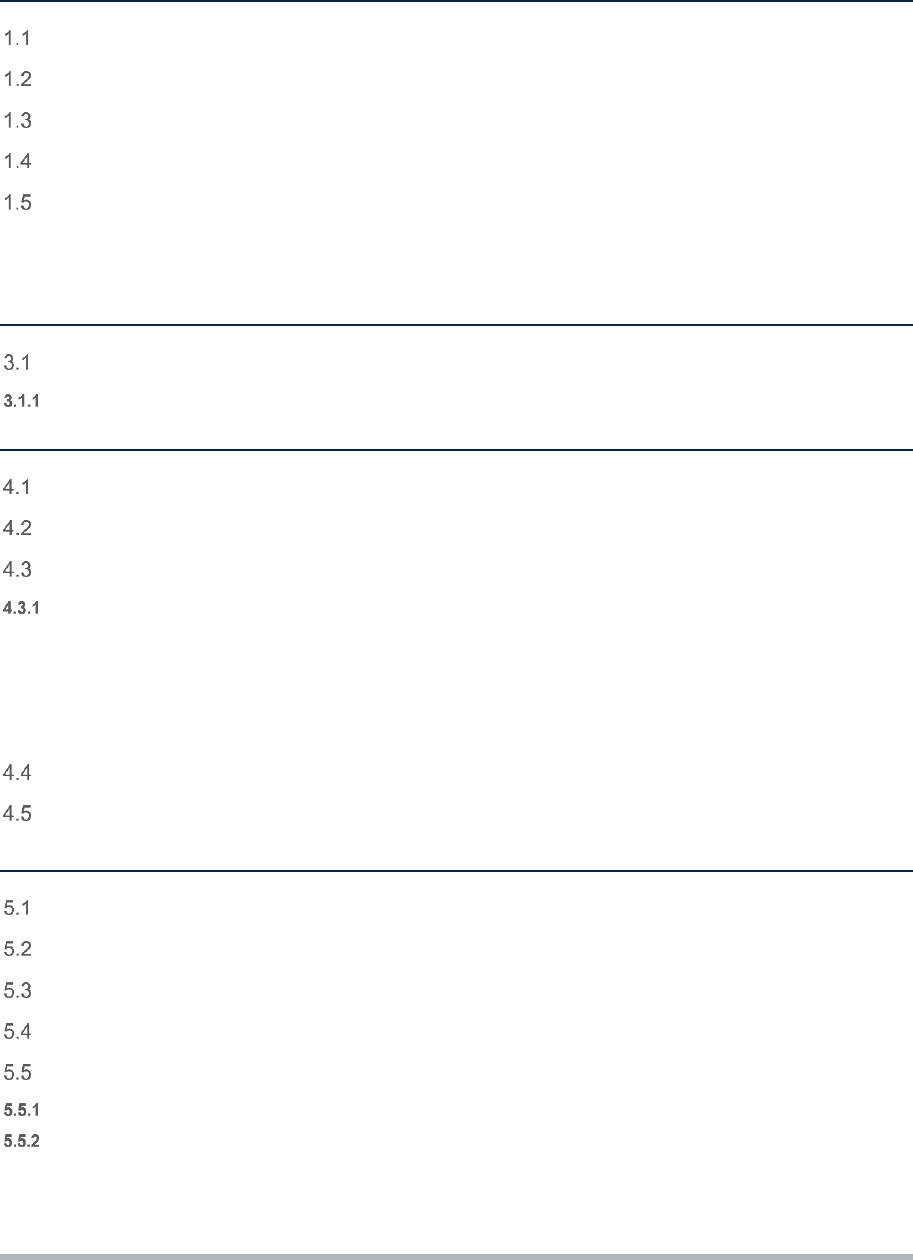
LE866 HARDWARE USER GUIDE 1vv0301210 Rev.0 – Preliminary • 2015-09-02 5 of 68
Reproduction forbidden without Telit Communications PLC written authorization – All Rights Reserved
CONTENTS
1 Introduction 8
Scope 8
Audience 8
Contact Information, Support 8
List of acronyms 9
Text Conventions 10
1.6. Related Documents 10
2 Overview 11
3 Pins Allocation 12
Pin-out 12
LGA Pads Layout 17
4 Power Supply 18
Power Supply Requirements 18
Power Consumption 19
General Design Rules 20
Electrical Design Guidelines 20
4.3.1.1 +5V Source Power Supply Design Guidelines 20
4.3.1.2 + 12V input Source Power Supply Design Guidelines 21
4.3.1.3 Battery Source Power Supply Design Guidelines 22
4.3.1.4 Thermal Design Guidelines 23
4.3.1.5 Power Supply PCB layout Guidelines 24
RTC 25
VAUX Power Output 25
5 Digital Section 26
Logic Levels Specification 26
Power on 27
Power off 29
Reset 30
Communication ports 33
USB 2.0 HS 33
Serial Ports 34
5.5.2.1 MODEM SERIAL PORT 1 (USIF0) 34
5.5.2.2 MODEM SERIAL PORT 2 (USIF1) 36
5.5.2.3 RS232 LEVEL TRANSLATION 36
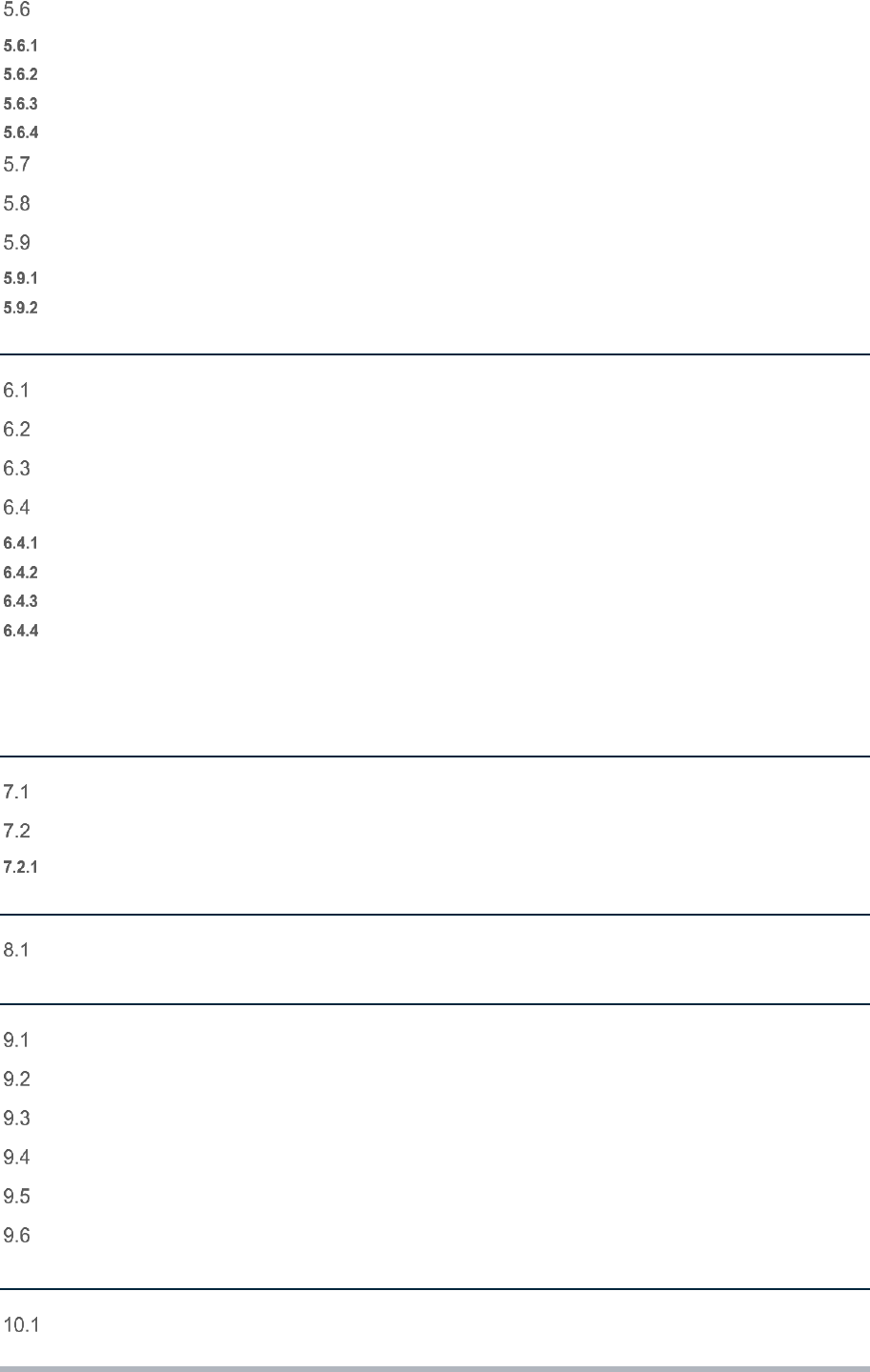
LE866 HARDWARE USER GUIDE 1vv0301210 Rev.0 – Preliminary • 2015-09-02 6 of 68
Reproduction forbidden without Telit Communications PLC written authorization – All Rights Reserved
General Purpose I/O 38
Using a GPIO as INPUT 39
Using a GPIO as OUTPUT 39
Indication of network service availability 39
SIMIN Detection 40
External SIM Holder 41
ADC Converter 42
DAC Converter 43
Enabling DAC 43
LOW Pass filter Example 44
6 RF Section 45
Bands Variants 45
TX Output Power 45
RX Sensitivity 45
Antenna Requirements 46
Main Antenna 46
RX Diversity Antenna 47
PCB design guidelines 47
PCB Guidelines in case of FCC Certification 49
6.4.4.1 Transmission line design 49
6.4.4.2 Transmission Line Measurements 50
6.4.4.3 Antenna Installation Guidelines 51
7 Audio Section 52
Overview 52
Digital Voice Interface 52
CODEC Examples 52
8 Mechanical Design 53
Drawing 53
9 Application Design 54
Footprint 54
PCB pad design 55
PCB pad dimensions 55
Stencil 57
Solder paste 57
Solder reflow 57
10 Packaging 59
Tray 59
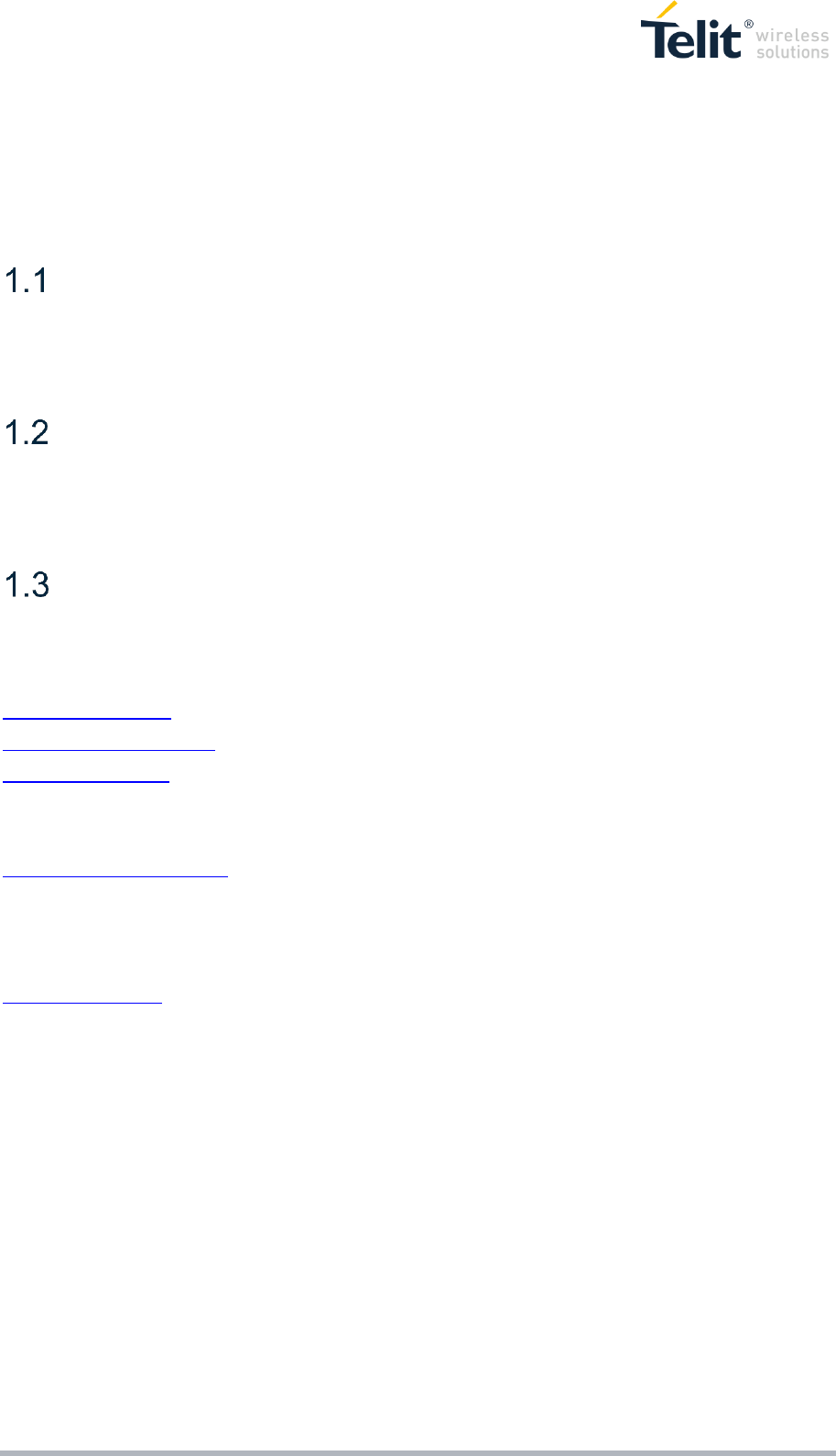
LE866 HARDWARE USER GUIDE 1vv0301210 Rev.0 – Preliminary • 2015-09-02 8 of 68
Reproduction forbidden without Telit Communications PLC written authorization – All Rights Reserved
1 INTRODUCTION
Scope
The aim of this document is the description of some hardware solutions useful for developing a product
with the Telit LE866 module.
Audience
This document is intended for Telit customers, who are integrators, about to implement their applications
using our LE866 modules.
Contact Information, Support
For general contact, technical support services, technical questions and report documentation errors
contact Telit Technical Support at:
TS-EMEA@telit.com
TS-AMERICAS@telit.com
TS-APAC@telit.com
Alternatively, use:
http://www.telit.com/support
For detailed information about where you can buy the Telit modules or for recommendations on
accessories and components visit:
http://www.telit.com
Our aim is to make this guide as helpful as possible. Keep us informed of your comments and
suggestions for improvements.
Telit appreciates feedback from the users of our information.
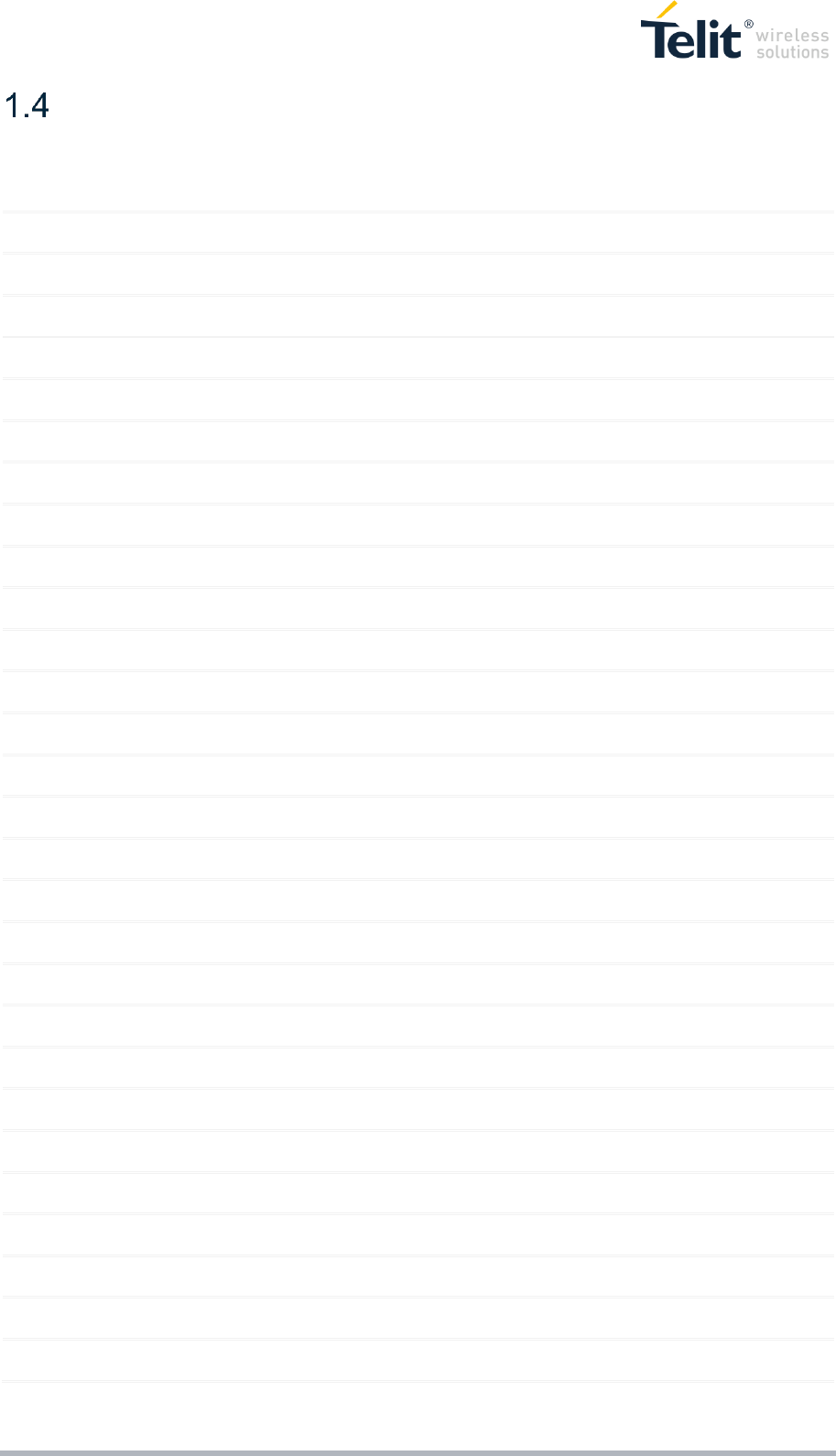
LE866 HARDWARE USER GUIDE 1vv0301210 Rev.0 – Preliminary • 2015-09-02 9 of 68
Reproduction forbidden without Telit Communications PLC written authorization – All Rights Reserved
List of acronyms
Acronym
Description
TTSC
Telit Technical Support Centre
USB
Universal Serial Bus
HS
High Speed
DTE
Data Terminal Equipment
LTE
Long Term Evolution
WCDMA
Wideband Code Division Multiple Access
HSDPA
High Speed Downlink Packet Access
HSUPA
High Speed Uplink Packet Access
UART
Universal Asynchronous Receiver Transmitter
HSIC
High Speed Inter Chip
SIM
Subscriber Identification Module
SPI
Serial Peripheral Interface
ADC
Analog – Digital Converter
DAC
Digital – Analog Converter
I/O
Input Output
GPIO
General Purpose Input Output
CMOS
Complementary Metal – Oxide Semiconductor
MOSI
Master Output – Slave Input
MISO
Master Input – Slave Output
CLK
Clock
MRDY
Master Ready
SRDY
Slave Ready
CS
Chip Select
RTC
Real Time Clock
PCB
Printed Circuit Board
ESR
Equivalent Series Resistance
VSWR
Voltage Standing Wave Radio
VNA
Vector Network Analyzer
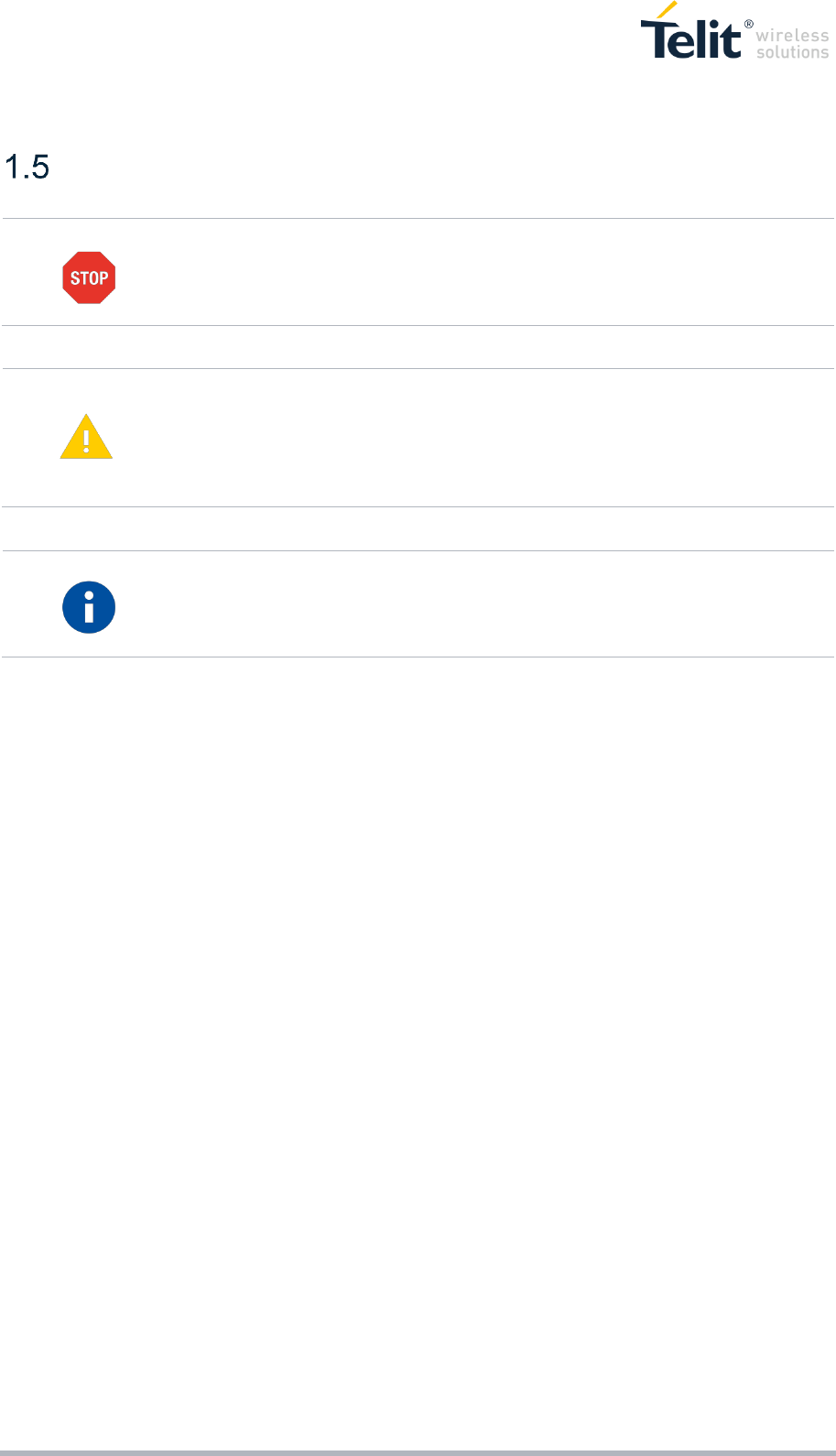
LE866 HARDWARE USER GUIDE 1vv0301210 Rev.0 – Preliminary • 2015-09-02 10 of 68
Reproduction forbidden without Telit Communications PLC written authorization – All Rights Reserved
Text Conventions
Danger – This information MUST be followed or catastrophic equipment failure
or bodily injury may occur.
Caution or Warning – Alerts the user to important points about integrating the
module, if these points are not followed, the module and end user equipment
may fail or malfunction.
Tip or Information – Provides advice and suggestions that may be useful when
integrating the module.
All dates are in ISO 8601 format, i.e. YYYY-MM-DD.
1.6. Related Documents
Digital Voice Interface Application Note 80000NT10050A
SPI Port Application Note 80000NT10053A
SIM Holder Design Guides 80000NT10001A
LE866 AT Commands Reference Guide 80471ST10691A
Telit EVK2 User Guide 1vv0300704
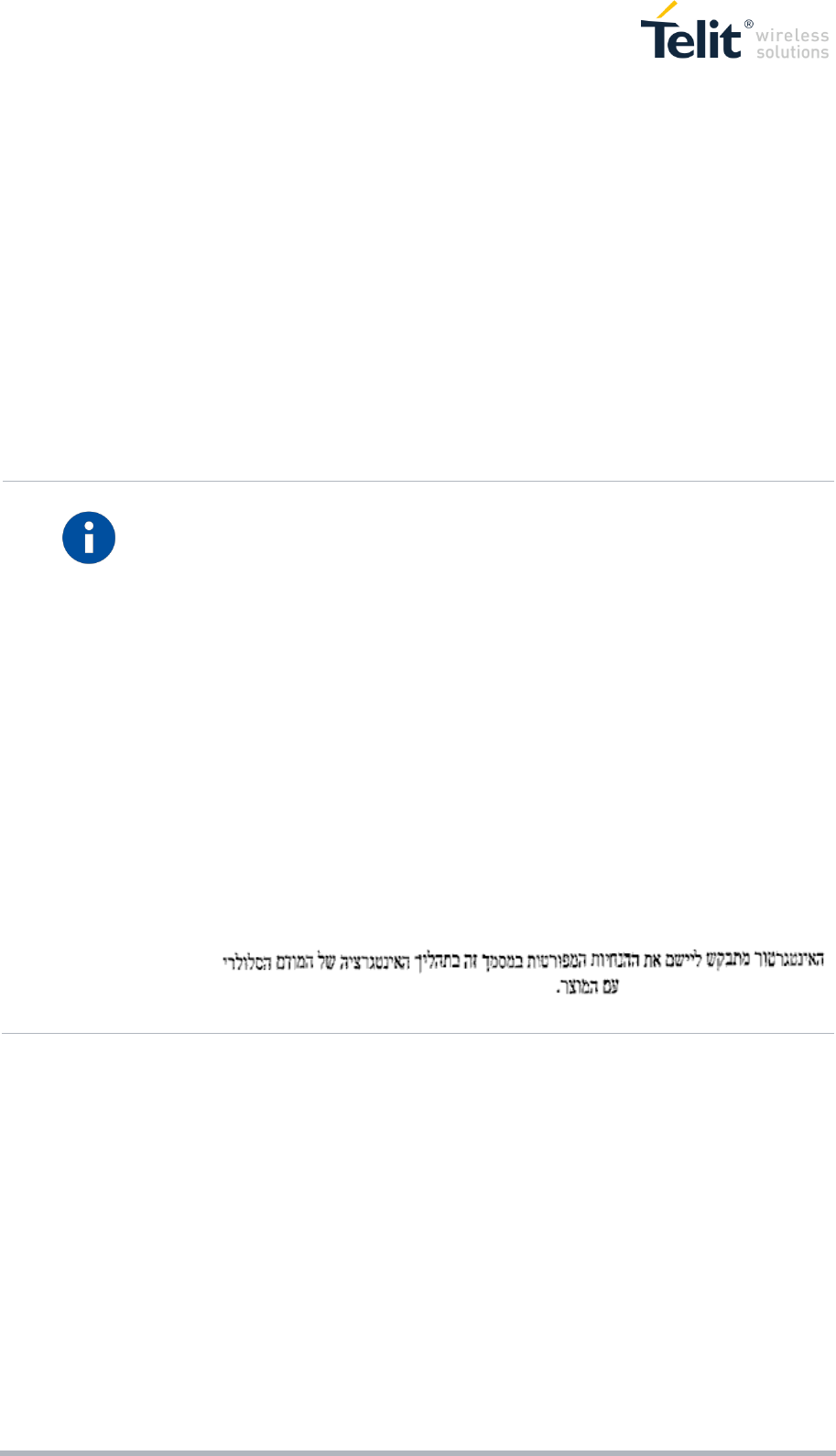
LE866 HARDWARE USER GUIDE 1vv0301210 Rev.0 – Preliminary • 2015-09-02 11 of 68
Reproduction forbidden without Telit Communications PLC written authorization – All Rights Reserved
2 OVERVIEW
The aim of this document is the description of some hardware solutions useful for developing a product
with the Telit LE866 module.
In this document all the basic functions of a mobile phone will be taken into account; for each one of
them a proper hardware solution will be suggested and eventually the wrong solutions and common
errors to be avoided will be evidenced. Obviously this document cannot embrace the whole hardware
solutions and products that may be designed. The wrong solutions to be avoided shall be considered
as mandatory, while the suggested hardware configurations shall not be considered mandatory, instead
the information given shall be used as a guide and a starting point for properly developing your product
with the Telit LE866 module. For further hardware details that may not be explained in this document
refer to the Telit LE866 Product Description document where all the hardware information is reported.
NOTICE:
(EN) The integration of the LTE LE866 cellular module within user application
shall be done according to the design rules described in this manual.
(IT) L’integrazione del modulo cellulare LTE LE866 all’interno dell’applicazione
dell’utente dovrà rispettare le indicazioni progettuali descritte in questo
manuale.
(DE) Die Integration des LE866 LTE Mobilfunk-Moduls in ein Gerät muß
gemäß der in diesem Dokument beschriebenen Kunstruktionsregeln erfolgen.
(SL) Integracija LTE LE866 modula v uporabniški aplikaciji bo morala
upoštevati projektna navodila, opisana v tem priročniku.
(SP) La utilización del modulo LTE LE866 debe ser conforme a los usos para
los cuales ha sido deseñado descritos en este manual del usuario.
(FR) L’intégration du module cellulaire LTE LE866 dans l’application de
l’utilisateur sera faite selon les règles de conception décrites dans ce manuel.
(HE)
The information presented in this document is believed to be accurate and reliable. However, no
responsibility is assumed by Telit Communications S.p.A. for its use, nor any infringement of patents or
other rights of third parties which may result from its use. No license is granted by implication or
otherwise under any patent rights of Telit Communications S.p.A. other than for circuitry embodied in
Telit products. This document is subject to change without notice.
LE866
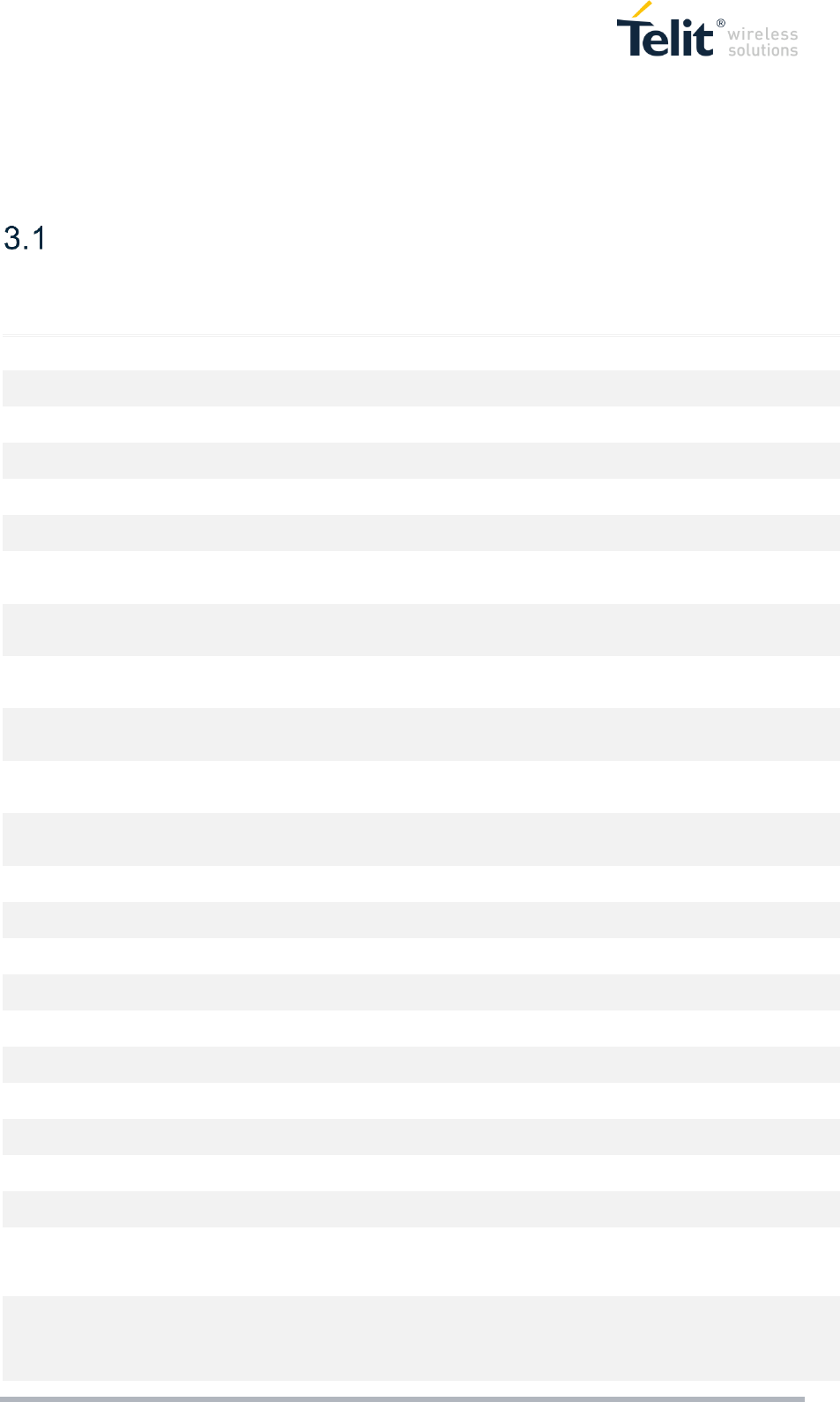
LE866 HARDWARE USER GUIDE 1vv0301210 Rev.0 – Preliminary • 2015-09-02 12 of 68
Reproduction forbidden without Telit Communications PLC written authorization – All Rights Reserved
3 PINS ALLOCATION
Pin-out
Pin
Signal
I/O
Function
Type
Comment
USB HS 2.0 COMMUNICATION PORT
E5
USB_D+
I/O
USB differential Data (+)
-
E6
USB_D-
I/O
USB differential Data (-)
-
Asynchronous Serial Port (USIF0) - Prog. / Data + HW Flow Control
A4
C103/TXD
I
Serial data input (TXD) from DTE
CMOS 1.8V
A5
C104/RXD
O
Serial data output to DTE
CMOS 1.8V
A2
C108/DTR
GPI_E
I
Input for (DTR) from DTE
Alternate Function: GPIO
CMOS 1.8V
A1
C105/RTS
GPI_F
I
Input for Request to send signal (RTS) from DTE
Alternate Function: GPIO
CMOS 1.8V
B1
C106/CTS
GPO_D
O
Output for Clear to send signal (CTS) to DTE
Alternate Function: GPIO
CMOS 1.8V
B2
C109/DCD
GPO_A
O
Output for (DCD) to DTE
Alternate function: GPIO
CMOS 1.8V
A3
C107/DSR
GPO_C
O
Output for (DSR) to DTE
Alternate function: GPIO
CMOS 1.8V
B3
C125/RING
GPO_B
O
Output for Ring (RI) to DTE
Alternate Function: GPIO
CMOS 1.8V
Asynchronous Auxiliary Serial Port (USIF1)
C1
TX_AUX
O
Auxiliary UART (TX Data to DTE)
CMOS 1.8V
C2
RX_AU
I
Auxiliary UART (RX Data from DTE)
CMOS 1.8V
SIM card interface
C7
SIMVCC
-
External SIM signal – Power supply for the SIM
1.8V Only
B7
SIMRST
O
External SIM signal – Reset
CMOS 1.8
A7
SIMCLK
O
External SIM signal – Clock
CMOS 1.8
A6
SIMIO
I/O
External SIM signal – Data I/O
CMOS 1.8
X
SIMIN
I
Presence SIM input
CMOS 1.8
See next chapters
DIGITAL IO
C5
GPIO_01
DVI_WA0
SIM_IN
I/O
INT
Main Function: GPIO01 Configurable GPIO
Alternate function 1: Digital Audio Interface (WA0)
Alternate Function 2: SIM_IN
CMOS 1.8V
C6
GPIO_02
DVI_RX
JDR
SIM_IN
I/O
INT
Main Function: GPIO02 Configurable GPIO
Alternate Function 1: Digital Audio Interface (RX)
Alternate Function 2: SIM_IN
CMOS 1.8V
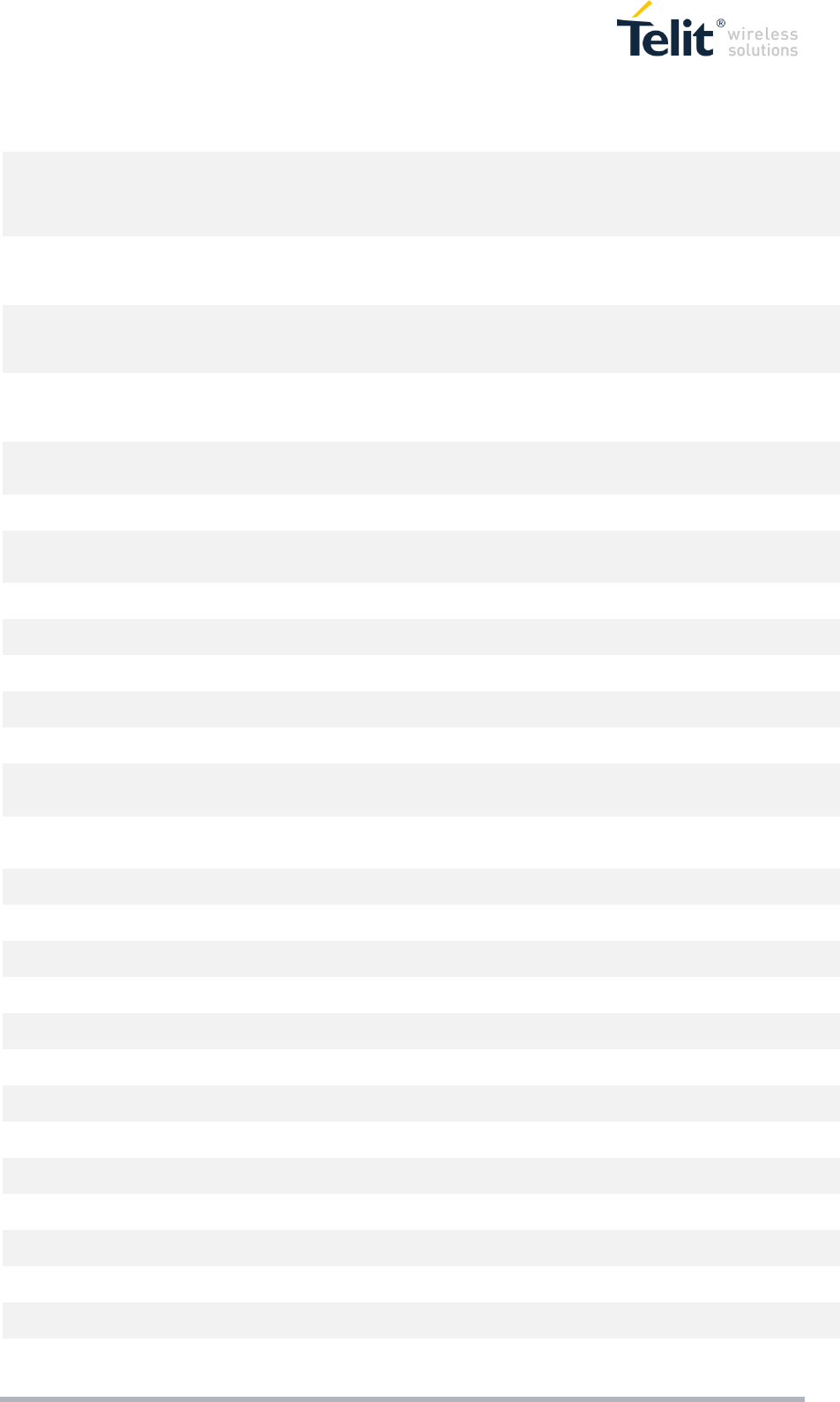
LE866 HARDWARE USER GUIDE 1vv0301210 Rev.0 – Preliminary • 2015-09-02 13 of 68
Reproduction forbidden without Telit Communications PLC written authorization – All Rights Reserved
D6
GPIO_03
DVI_TX
SIM_IN
I/O
INT
General Purpose IO
Alternate Function 1: Digital Audio Interface (TX)
Alternate Function 2: SIM_IN
CMOS 1.8V
D5
GPIO_04
DVI_CLK
TX_DISABLE
SIM_IN
I/O
INT
Main Function: GPIO04 Configurable GPIO
Alternate Function1: Digital Audio Interface (CLK)
Alternate Function 2: TX Disable input
Alternate Function 3: SIM_IN
CMOS 1.8V
B5
GPIO_05
RF_TX_MON
SIM_IN
I/O
INT
Main Function: GPIO05 Configurable GPIO
Alternate Function 1: RF_TX_MON
Alternate Function 2: SIM_IN
CMOS 1.8V
B4
GPIO_06
ALARM
SIM_IN
I/O
INT
Main Function: GPIO06 Configurable GPIO
Alternate Function 1: ALARM
Alternate Function 2: SIM_IN
CMOS 1.8V
C4
GPIO_07
STAT_LED
SIM_IN
I/O
INT
Main Function: GPIO07 Configurable GPIO
Alternate Function 1: STATLED
Alternate Function 2: SIM_IN
CMOS 1.8V
D8
VDDIO_IN
I
IO bus Supply input
Power
To be connected to
VAUX (pad G6)
ADC and DAC
F4
ADC_IN1
AI
Analog/Digital converter input
A/D
Accepted values 0 to
1.0V DC
E4
DAC_OUT
AO
Digital/Analog converter output
D/A
RF SECTION
G2
MAIN_ANT
I/O
LTE Main Antenna (50 ohm)
RF
C0
DIV_ANT
I
LTE RX Diversity Antenna (50 ohm)
RF
Miscellaneous Functions
G4
RESET*
I
Reset Input
VBATT
Pull up to VBATT
(10Kohm)
G6
VAUX
PWRMON
O
1.8V stabilized output
Power ON monitor
Power
Power Supply
E2
VBATT
-
Main power supply (Baseband)
Power
E0
VBATT_PA
-
Main power supply (Radio PA)
Power
E1
VBATT_PA
-
Main power supply (Radio PA)
Power
B0
GND
-
Ground
Power
D0
GND
-
Ground
Power
F0
GND
-
Ground
Power
G0
GND
-
Ground
Power
D1
GND
-
Ground
Power
F1
GND
-
Ground
Power
G1
GND
-
Ground
Power
D2
GND
-
Ground
Power
F2
GND
-
Ground
Power
C3
GND
-
Ground
Power
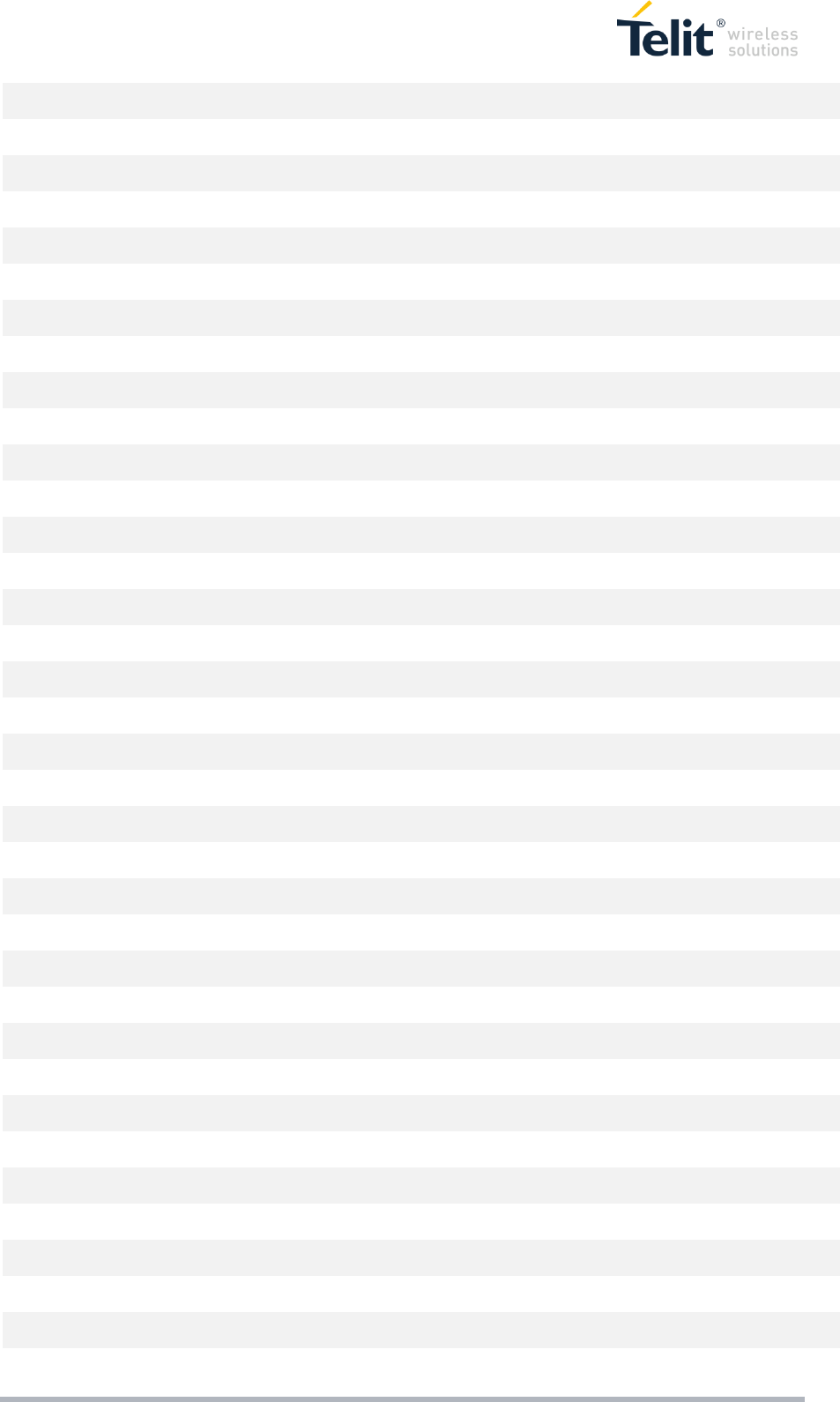
LE866 HARDWARE USER GUIDE 1vv0301210 Rev.0 – Preliminary • 2015-09-02 14 of 68
Reproduction forbidden without Telit Communications PLC written authorization – All Rights Reserved
E3
GND
-
Ground
Power
F3
GND
-
Ground
Power
G3
GND
-
Ground
Power
F6
GND
-
Ground
Power
A8
GND
-
Ground
Power
G8
GND
-
Ground
Power
A11
GND
-
Ground
Power
G11
GND
-
Ground
Power
RESERVED
A0
RESERVED
-
RESERVED
D3
RESERVED
-
RESERVED
G5
RESERVED
-
RESERVED
B6
RESERVED
-
RESERVED
D7
RESERVED
-
RESERVED
E7
RESERVED
-
RESERVED
F7
RESERVED
-
RESERVED
G7
RESERVED
-
RESERVED
B8
RESERVED
-
RESERVED
C8
RESERVED
-
RESERVED
E8
RESERVED
-
RESERVED
F8
RESERVED
-
RESERVED
A9
RESERVED
-
RESERVED
B9
RESERVED
-
RESERVED
C9
RESERVED
-
RESERVED
D9
RESERVED
-
RESERVED
E9
RESERVED
-
RESERVED
F9
RESERVED
-
RESERVED
G9
RESERVED
-
RESERVED
A10
RESERVED
-
RESERVED
B10
RESERVED
-
RESERVED
C10
RESERVED
-
RESERVED
D10
RESERVED
-
RESERVED
E10
RESERVED
-
RESERVED
F10
RESERVED
-
RESERVED
G10
RESERVED
-
RESERVED

LE866 HARDWARE USER GUIDE 1vv0301210 Rev.0 – Preliminary • 2015-09-02 15 of 68
Reproduction forbidden without Telit Communications PLC written authorization – All Rights Reserved
WARNING:
Reserved pins must not be connected
B11
RESERVED
-
RESERVED
C11
RESERVED
-
RESERVED
D4
RESERVED
-
RESERVED
F5
RESERVED
-
RESERVED
F11
RESERVED
-
RESERVED
E11
RESERVED
-
RESERVED
D11
RESERVED
-
RESERVED
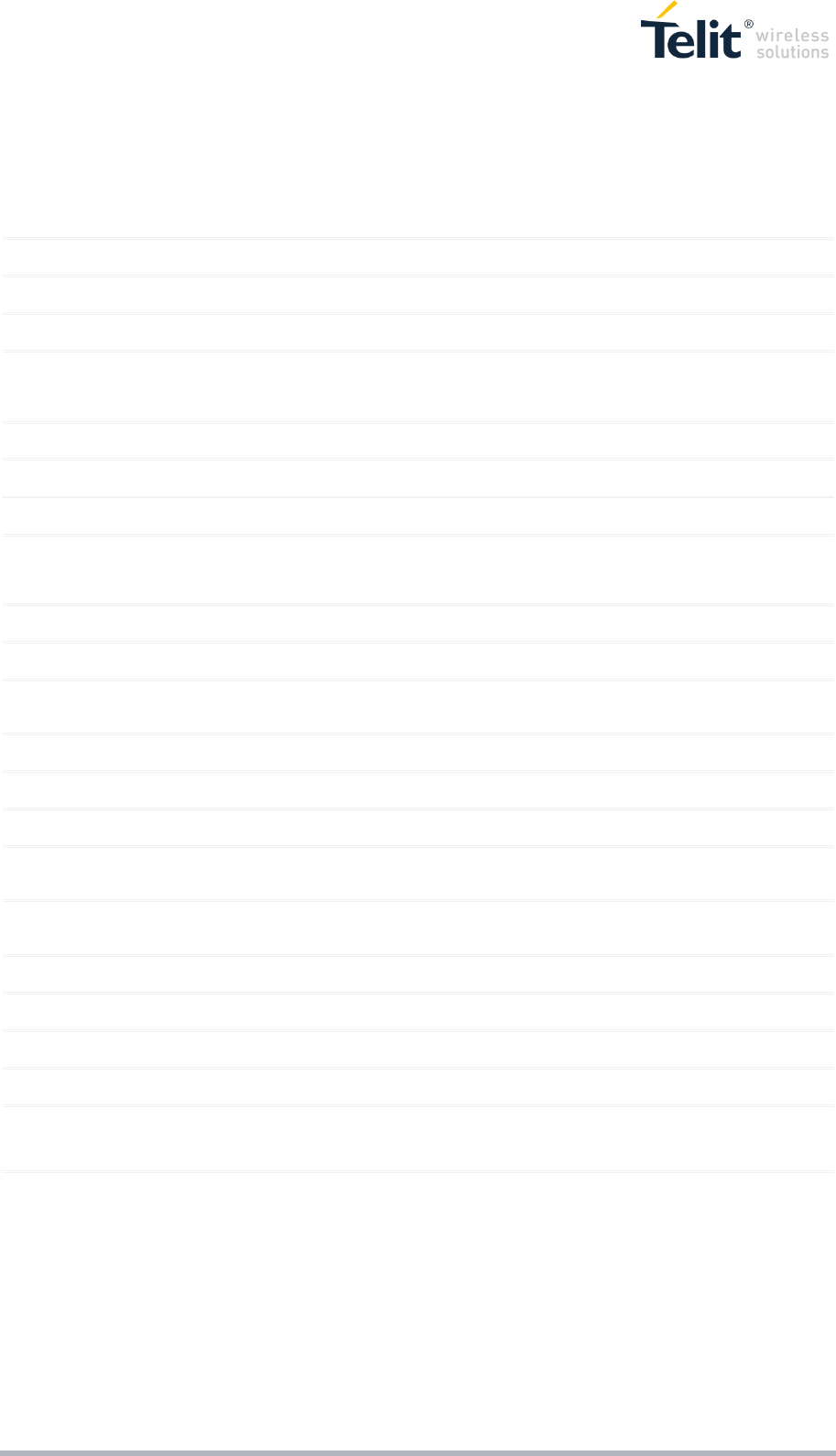
LE866 HARDWARE USER GUIDE 1vv0301210 Rev.0 – Preliminary • 2015-09-02 16 of 68
Reproduction forbidden without Telit Communications PLC written authorization – All Rights Reserved
If not used, almost all pins should be left disconnected. The only exceptions are the following pins:
PAD
Signal
Note
E2
VBATT
E0
VBATT_PA
E1
VBATT_PA
B0, D0, F0, G0, D1, F1, G1,
D2, F2, C3, E3, F3, G3, F6,
A8, G8, A11, G11
GND
G2
Main Antenna
C0
Diversity Antenna
A4
C103/TXD
If not used should be connected to a Test Point
A5
C104/RXD
If not used should be connected to a Test Point
A1
C105/RTS
If not used should be connected to a Test Point
B1
C106/CTS
If not used should be connected to a Test Point
G6
VAUX / PWRMON
G4
RESET*
C1
TXD_AUX
If not used should be connected to a Test Point
C2
RXD_AUX
If not used should be connected to a Test Point
E5
USB D+
If not used should be connected to a Test Point or an
USB connector
E6
USB D-
If not used should be connected to a Test Point or an
USB connector
C7
SIMVCC
B7
SIMRST
A7
SIMCLK
A6
SIMIO
D8
VDDIO_IN
To be connected to VAUX (R0 resistor in series for
debug purposes)
RTS pin should be connected to the GND (on the module side) if flow control is not used.
The above pins are also necessary to debug the application when the module is assembled on it so we
recommend connecting them also to dedicated test point.
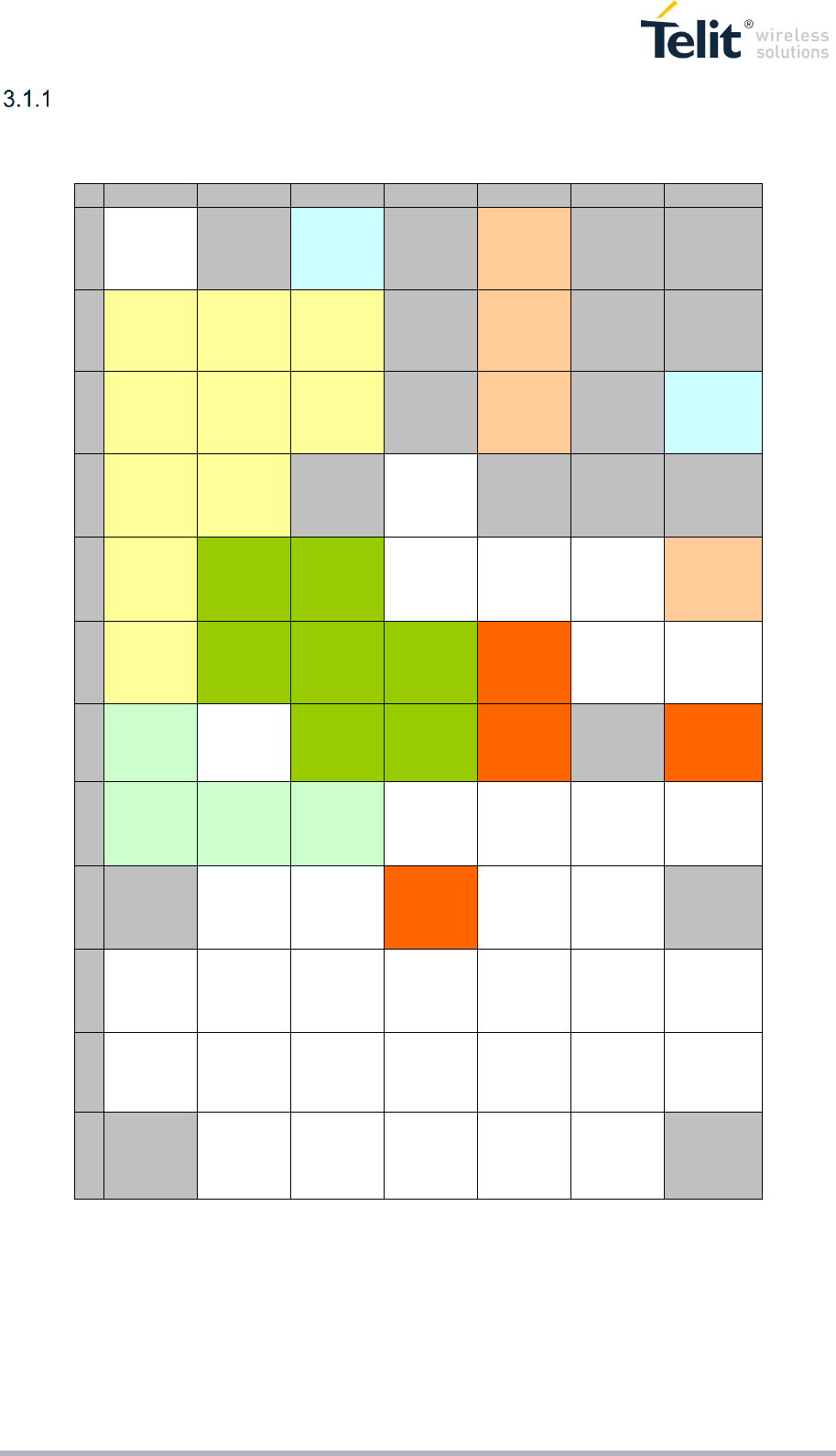
LE866 HARDWARE USER GUIDE 1vv0301210 Rev.0 – Preliminary • 2015-09-02 17 of 68
Reproduction forbidden without Telit Communications PLC written authorization – All Rights Reserved
LGA Pads Layout
TOP VIEW
A
B
C
D
E
F
G
0
RESERVED
GND
DIV
ANT
GND
VBATT_PA
GND
GND
1
C105/RTS
C106/CTS
TX AUX
GND
VBATT_PA
GND
GND
2
C108/DTR
C109/DCD
RX AUX
GND
VBATT
GND
MAIN
ANT
3
C107/DSR
C125/RING
GND
RESERVED
GND
GND
GND
4
C103/TXD
GPIO_06
GPIO_07
RESERVED
DAC_OUT
ADC_IN1
RESET*
5
C104/RXD
GPIO_05
GPIO_01
GPIO_04
USB_D+
RESERVED
RESERVED
6
SIMIO
RESERVED
GPIO_02
GPIO_03
USB_D-
GND
VAUX/PWR
MON
7
SIMCLK
SIMRST
SIMVCC
RESERVED
RESERVED
RESERVED
RESERVED
8
GND
RESERVED
RESERVED
VDDIO_IN
RESERVED
RESERVED
GND
9
RESERVED
RESERVED
RESERVED
RESERVED
RESERVED
RESERVED
RESERVED
10
RESERVED
RESERVED
RESERVED
RESERVED
RESERVED
RESERVED
RESERVED
11
GND
RESERVED
RESERVED
RESERVED
RESERVED
RESERVED
GND
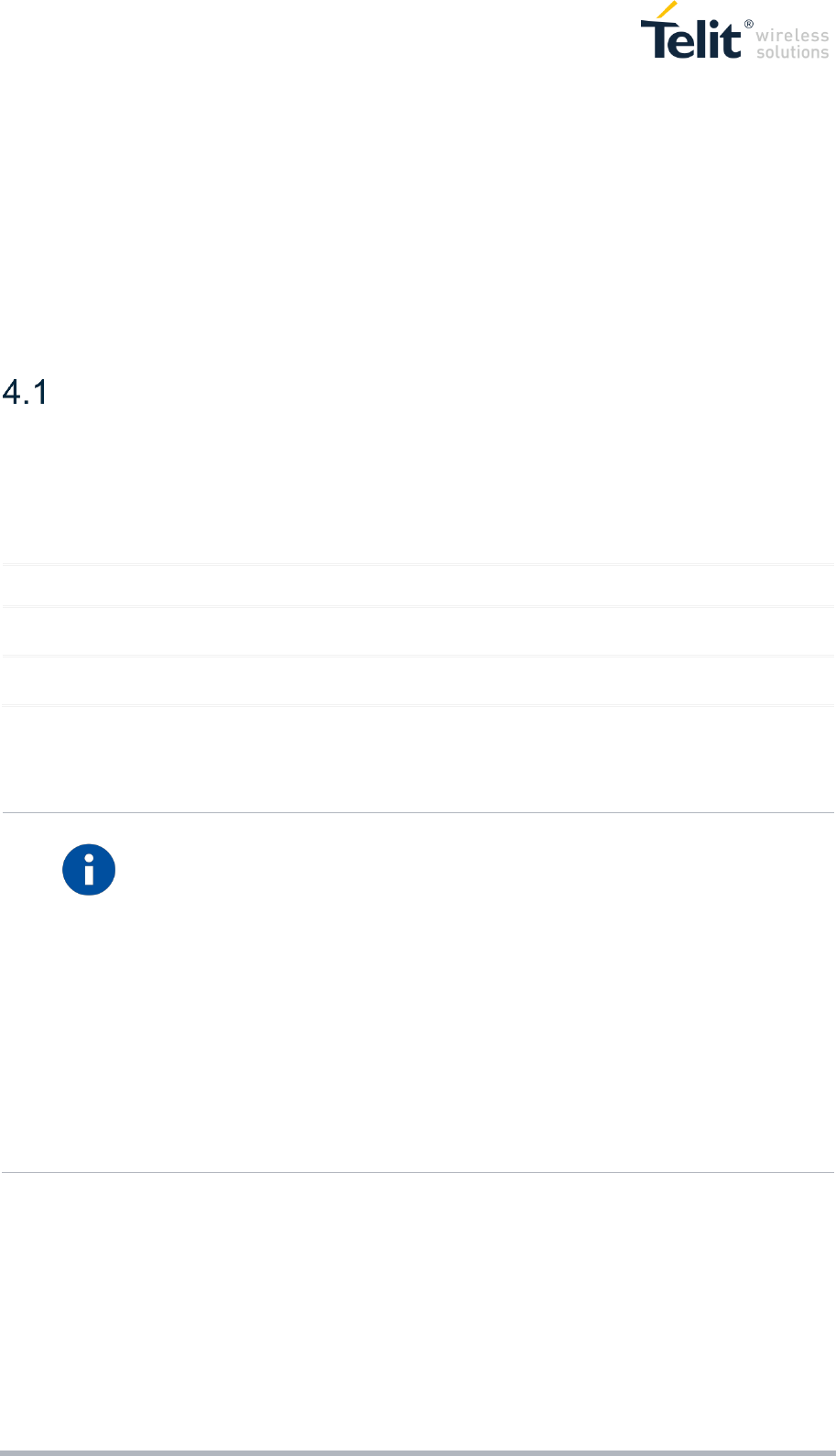
LE866 HARDWARE USER GUIDE 1vv0301210 Rev.0 – Preliminary • 2015-09-02 18 of 68
Reproduction forbidden without Telit Communications PLC written authorization – All Rights Reserved
4 POWER SUPPLY
The power supply circuitry and board layout are a very important part in the full product design and they
strongly reflect on the product overall performances, hence read carefully the requirements and the
guidelines that will follow for a proper design.
Power Supply Requirements
The external power supply must be connected to VBATT & VBATT_PA signals and must fulfil the
following requirements:
Power Supply
Value
Nominal Supply Voltage
3.8V
Normal Operating Voltage Range
3.40 V÷ 4.20 V
Extended Operating Voltage Range
3.10 V÷ 4.50 V
NOTE:
The Operating Voltage Range MUST never be exceeded; care must be taken
when designing the application’s power supply section to avoid having an
excessive voltage drop.
If the voltage drop is exceeding the limits it could cause a Power Off of the
module.
Overshoot voltage (regarding MAX Extended Operating Voltage) and drop in
voltage (regarding MIN Extended Operating Voltage) MUST never be exceeded;
The “Extended Operating Voltage Range” can be used only with completely
assumption and application of the HW User guide suggestions.
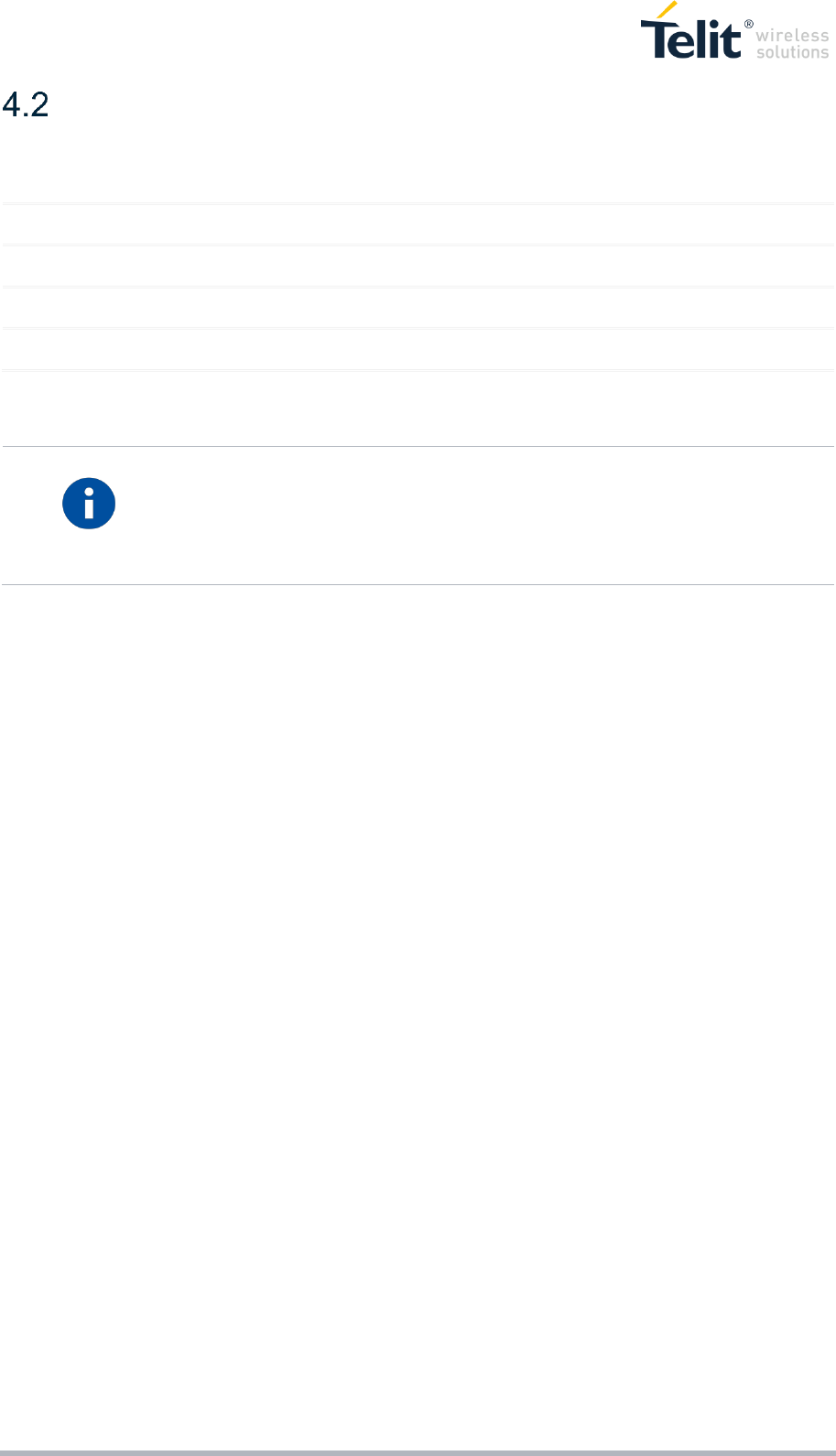
LE866 HARDWARE USER GUIDE 1vv0301210 Rev.0 – Preliminary • 2015-09-02 19 of 68
Reproduction forbidden without Telit Communications PLC written authorization – All Rights Reserved
Power Consumption
Mode
Average (mA)
Mode Description
AT+CFUN=5
TBD
Disabled TX and RX; DRX7
LTE Voice Call
TBD
Max Power
LTE Data Call (Max Power)
TBD
LTE data call
LTE Data Call (Min Power)
TBD
LTE data call
NOTE:
The electrical design for the Power supply should be made ensuring it will be
capable of a peak current output of at least 1 A.
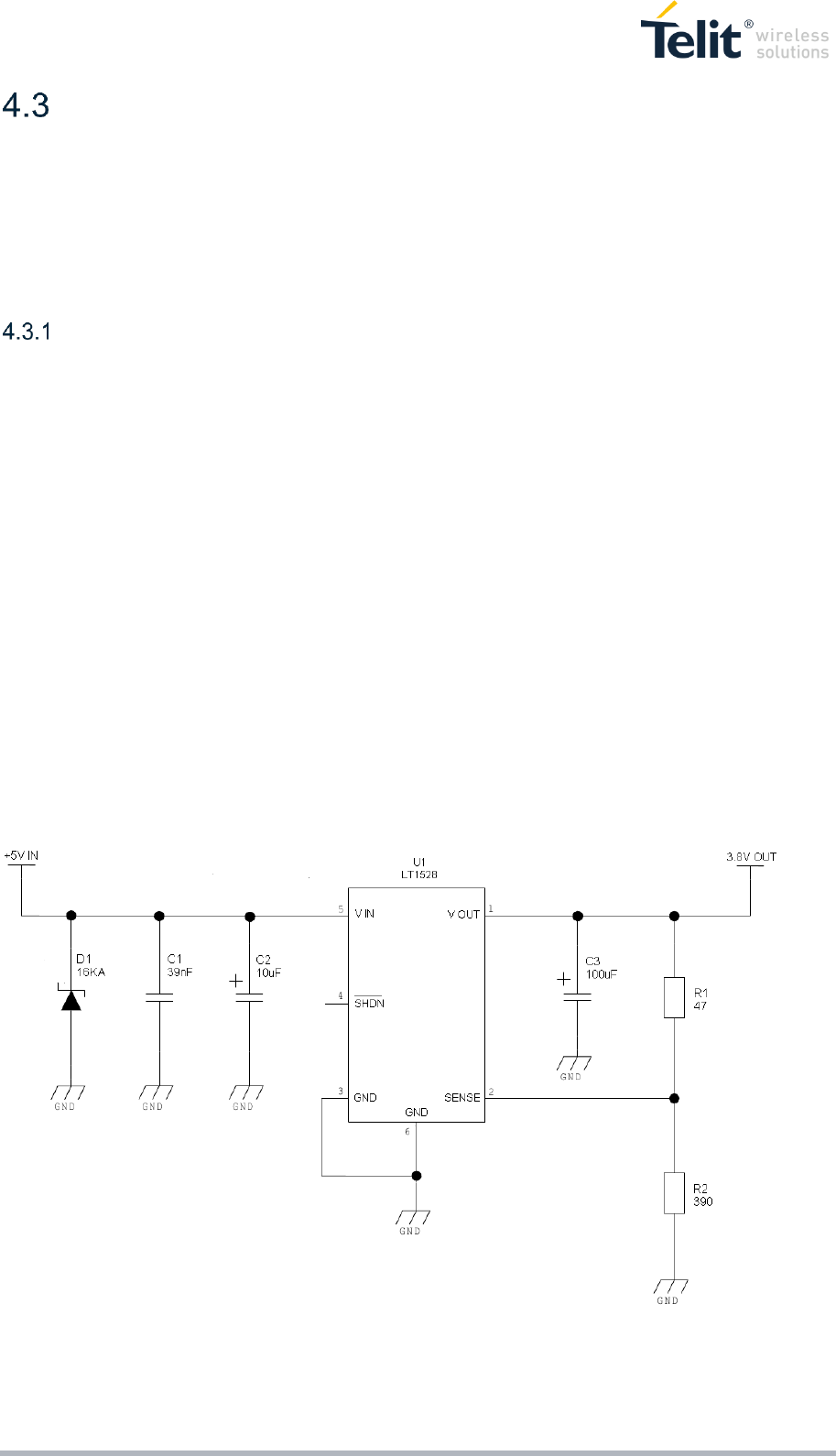
LE866 HARDWARE USER GUIDE 1vv0301210 Rev.0 – Preliminary • 2015-09-02 20 of 68
Reproduction forbidden without Telit Communications PLC written authorization – All Rights Reserved
General Design Rules
The principal guidelines for the Power Supply Design embrace three different design steps:
the electrical design
the thermal design
the PCB layout.
Electrical Design Guidelines
The electrical design of the power supply depends strongly from the power source where this power is
drained. We will distinguish them into three categories:
+5V input (typically PC internal regulator output)
+12V input (typically automotive)
Battery
4.3.1.1 +5V Source Power Supply Design Guidelines
The desired output for the power supply is 3.8V, hence there's not a big difference between the
input source and the desired output and a linear regulator can be used. A switching power
supply will not be suited because of the low drop out requirements.
When using a linear regulator, a proper heat sink shall be provided in order to dissipate the
power generated.
A Bypass low ESR capacitor of adequate capacity must be provided in order to cut the current
absorption peaks close to the Module, a 100μF capacitor is usually suited.
Make sure the low ESR capacitor on the power supply output rated at least 10V.
An example of linear regulator with 5V input is:
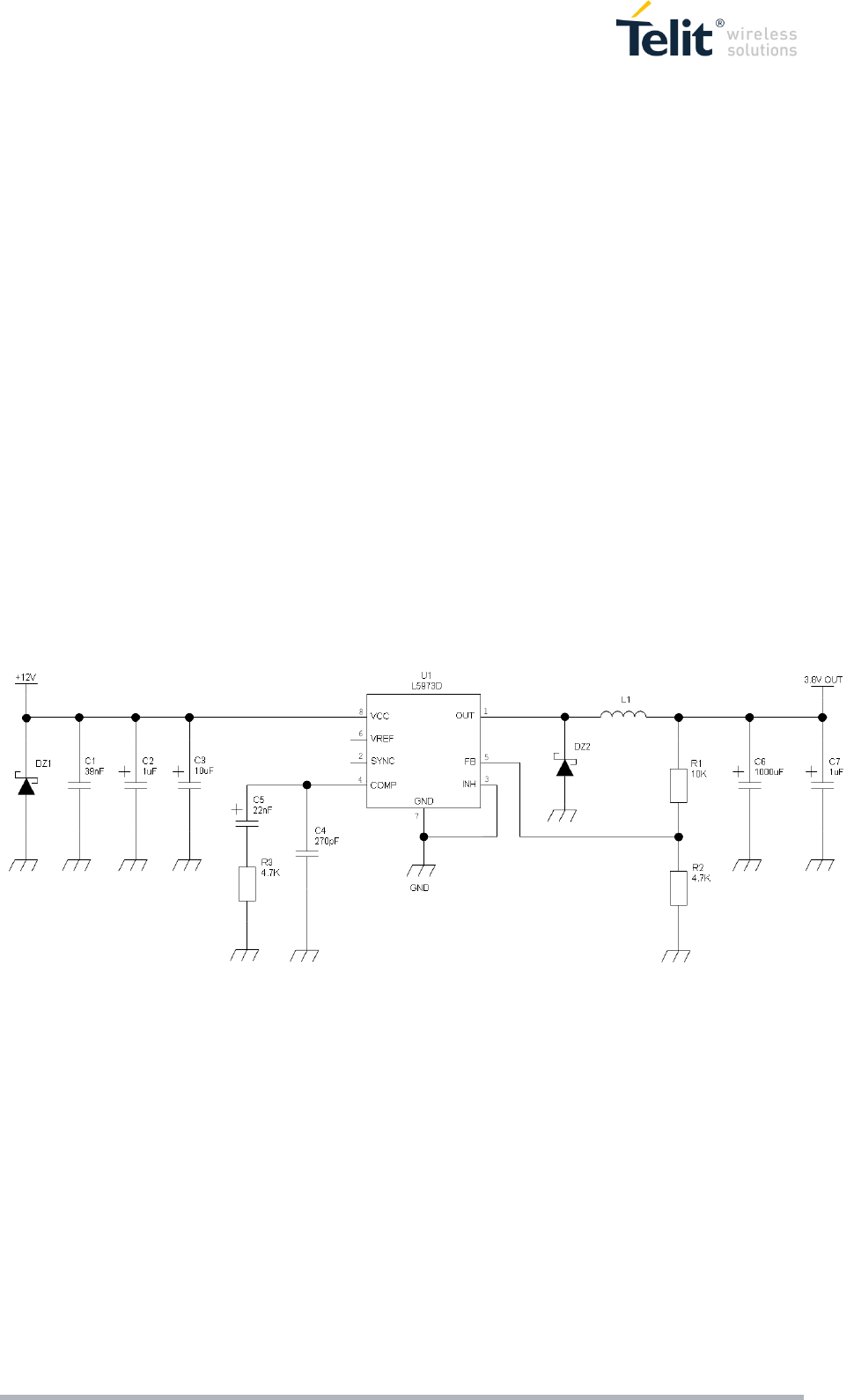
LE866 HARDWARE USER GUIDE 1vv0301210 Rev.0 – Preliminary • 2015-09-02 21 of 68
Reproduction forbidden without Telit Communications PLC written authorization – All Rights Reserved
4.3.1.2 + 12V input Source Power Supply Design Guidelines
The desired output for the power supply is 3.8V, hence due to the big difference between the
input source and the desired output, a linear regulator is not suited and shall not be used. A
switching power supply will be preferable because of its better efficiency.
When using a switching regulator, a 500kHz or more switching frequency regulator is preferable
because of its smaller inductor size and its faster transient response. This allows the regulator
to respond quickly to the current peaks absorption.
In any case the frequency and Switching design selection is related to the application to be
developed due to the fact the switching frequency could also generate EMC interferences.
For car PB battery the input voltage can rise up to 15,8V and this should be kept in mind when
choosing components: all components in the power supply must withstand this voltage.
A Bypass low ESR capacitor of adequate capacity must be provided in order to cut the current
absorption peaks, a 100μF capacitor is usually suited.
Make sure the low ESR capacitor on the power supply output is rated at least 10V.
For Car applications a spike protection diode should be inserted close to the power input, in
order to clean the supply from spikes.
An example of switching regulator with 12V input is in the below schematic:
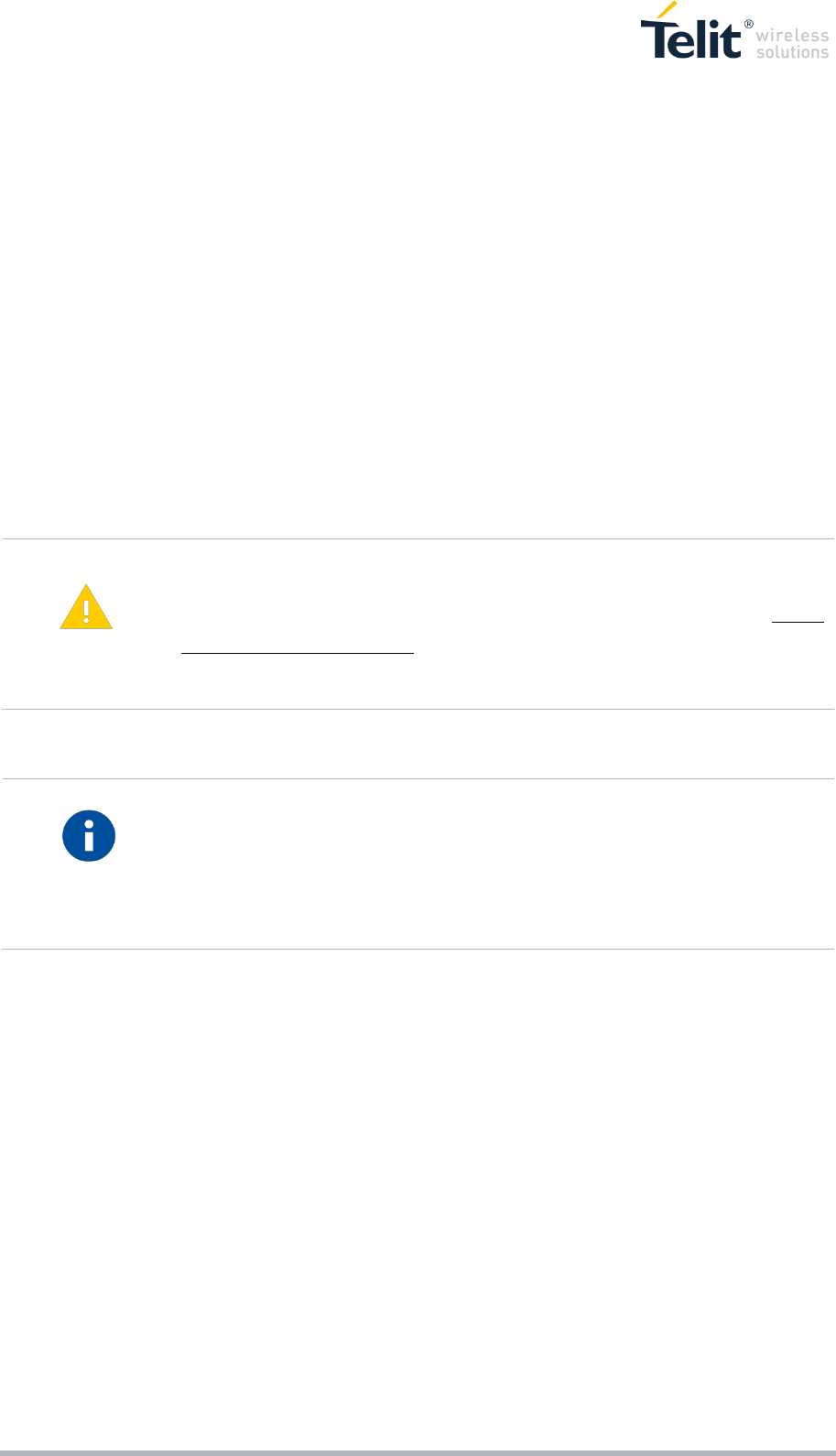
LE866 HARDWARE USER GUIDE 1vv0301210 Rev.0 – Preliminary • 2015-09-02 22 of 68
Reproduction forbidden without Telit Communications PLC written authorization – All Rights Reserved
4.3.1.3 Battery Source Power Supply Design Guidelines
The desired nominal output for the power supply is 3.8V and the maximum voltage allowed is 4.2V,
hence a single 3.7V Li-Ion cell battery type is suited for supplying the power to the Telit LE866 module.
A Bypass low ESR capacitor of adequate capacity must be provided in order to cut the current
absorption peaks, a 100μF tantalum capacitor is usually suited.
Make sure the low ESR capacitor (usually a tantalum one) is rated at least 10V.
A protection diode should be inserted close to the power input, in order to save the LE866 from
power polarity inversion. Otherwise the battery connector should be done in a way to avoid
polarity inversions when connecting the battery.
The battery capacity must be at least 500mAh in order to withstand the current peaks of 2A;
the suggested capacity is from 500mAh to 1000mAh.
WARNING:
The three cells Ni/Cd or Ni/MH 3,6 V Nom. battery types or 4V PB types MUST
NOT BE USED DIRECTLY since their maximum voltage can rise over the
absolute maximum voltage for the LE866 and damage it.
NOTE:
DON'T USE any Ni-Cd, Ni-MH, and Pb battery types directly connected with
LE866. Their use can lead to overvoltage on the LE866 and damage it. USE
ONLY Li-Ion battery types.
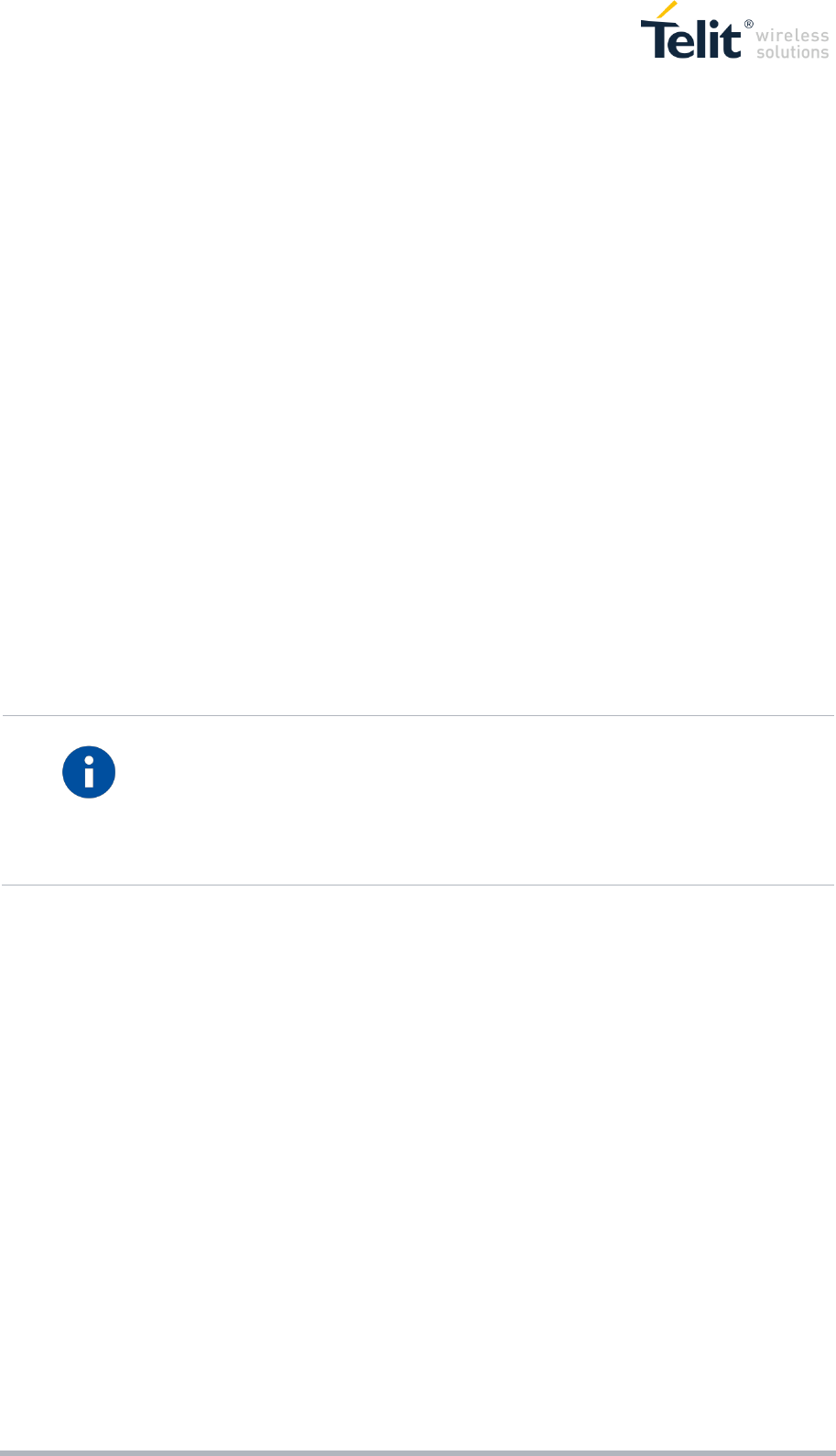
LE866 HARDWARE USER GUIDE 1vv0301210 Rev.0 – Preliminary • 2015-09-02 23 of 68
Reproduction forbidden without Telit Communications PLC written authorization – All Rights Reserved
4.3.1.4 Thermal Design Guidelines
The thermal design for the power supply heat sink should be done with the following specifications:
Average current consumption during LTE transmission @PWR level max : 600 mA
Average current during idle: 1.5 mA
Considering the very low current during idle, especially if Power Saving function is enabled, it is possible
to consider from the thermal point of view that the device absorbs current significantly only during calls.
If we assume that the device stays into transmission for short periods of time (let's say few minutes) and
then remains for a quite long time in idle (let's say one hour), then the power supply has always the time
to cool down between the calls and the heat sink could be smaller than the calculated one for 700mA
maximum RMS current, or even could be the simple chip package (no heat sink).
Moreover in the average network conditions the device is requested to transmit at a lower power level
than the maximum and hence the current consumption will be less than the 700mA, being usually around
150mA.
For these reasons the thermal design is rarely a concern and the simple ground plane where the power
supply chip is placed can be enough to ensure a good thermal condition and avoid overheating.
The generated heat will be mostly conducted to the ground plane under the LE866; you must ensure
that your application can dissipate it.
NOTE:
The average consumption during transmissions depends on the power level at
which the device is requested to transmit by the network. The average current
consumption hence varies significantly.
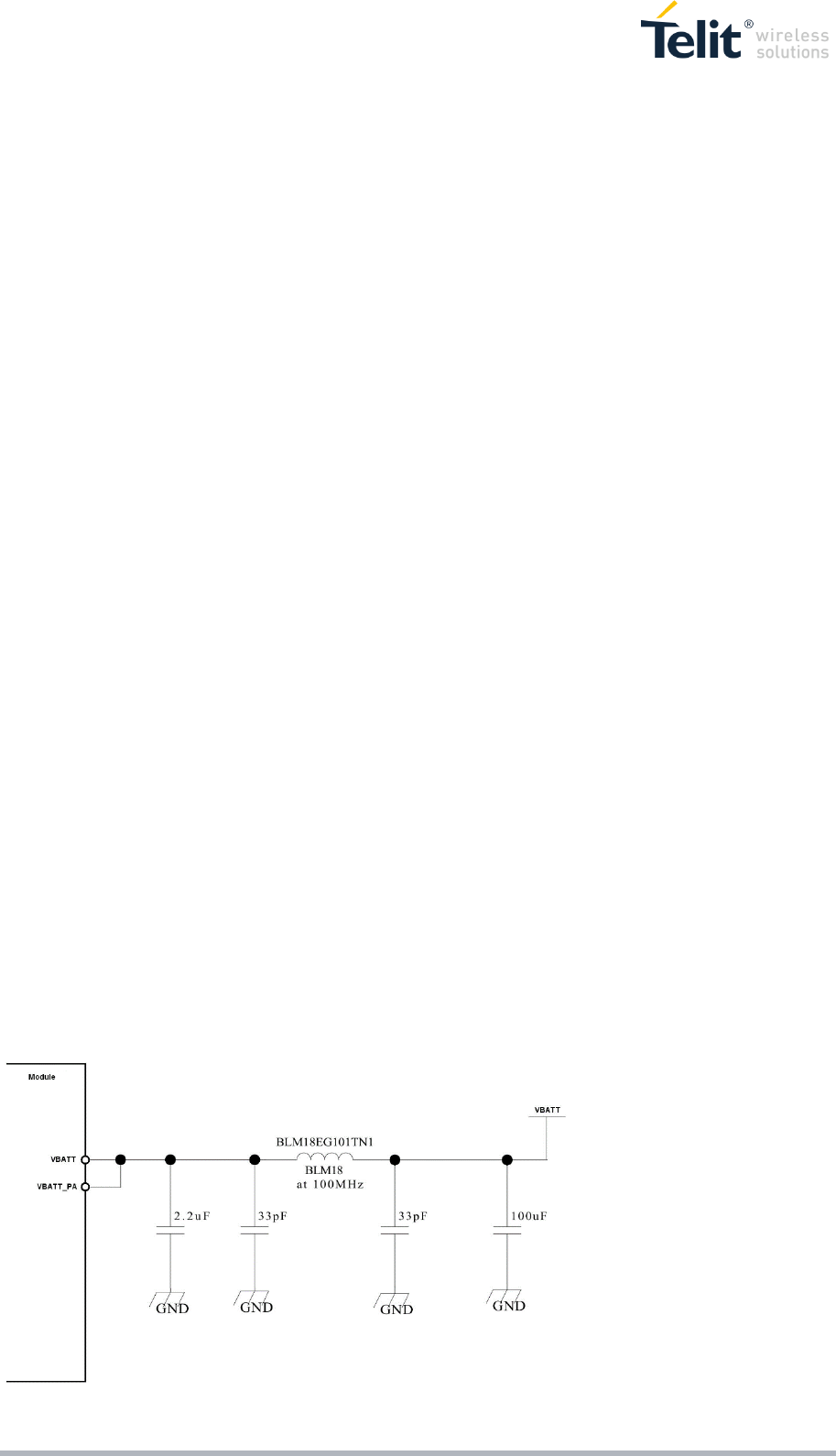
LE866 HARDWARE USER GUIDE 1vv0301210 Rev.0 – Preliminary • 2015-09-02 24 of 68
Reproduction forbidden without Telit Communications PLC written authorization – All Rights Reserved
4.3.1.5 Power Supply PCB layout Guidelines
As seen on the electrical design guidelines the power supply shall have a low ESR capacitor on the
output to cut the current peaks on the input to protect the supply from spikes The placement of this
component is crucial for the correct working of the circuitry. A misplaced component can be useless or
can even decrease the power supply performances.
The Bypass low ESR capacitor must be placed close to the Telit LE866 power input pads or in
the case the power supply is a switching type it can be placed close to the inductor to cut the
ripple provided the PCB trace from the capacitor to the LE866 is wide enough to ensure a
dropless connection even during an 1A current peak.
The protection diode must be placed close to the input connector where the power source is
drained.
The PCB traces from the input connector to the power regulator IC must be wide enough to
ensure no voltage drops occur when an 1A current peak is absorbed.
The PCB traces to the LE866 and the Bypass capacitor must be wide enough to ensure no
significant voltage drops occur. This is for the same reason as previous point. Try to keep this
trace as short as possible.
To reduce the EMI due to switching, it is important to keep very small the mesh involved; thus
the input capacitor, the output diode (if not embodied in the IC) and the regulator have to form
a very small loop.This is done in order to reduce the radiated field (noise) at the switching
frequency (100-500 kHz usually).
A dedicated ground for the Switching regulator separated by the common ground plane is
suggested.
The placement of the power supply on the board should be done in such a way to guarantee
that the high current return paths in the ground plane are not overlapped to any noise sensitive
circuitry as the microphone amplifier/buffer or earphone amplifier.
The power supply input cables should be kept separate from noise sensitive lines such as
microphone/earphone cables.
The insertion of EMI filter on VBATT pins is suggested in those designs where antenna is
placed close to battery or supply lines.
A ferrite bead like Murata BLM18EG101TN1 or Taiyo Yuden P/N FBMH1608HM101 can be
used for this purpose.
The below figure shows the recommended circuit:
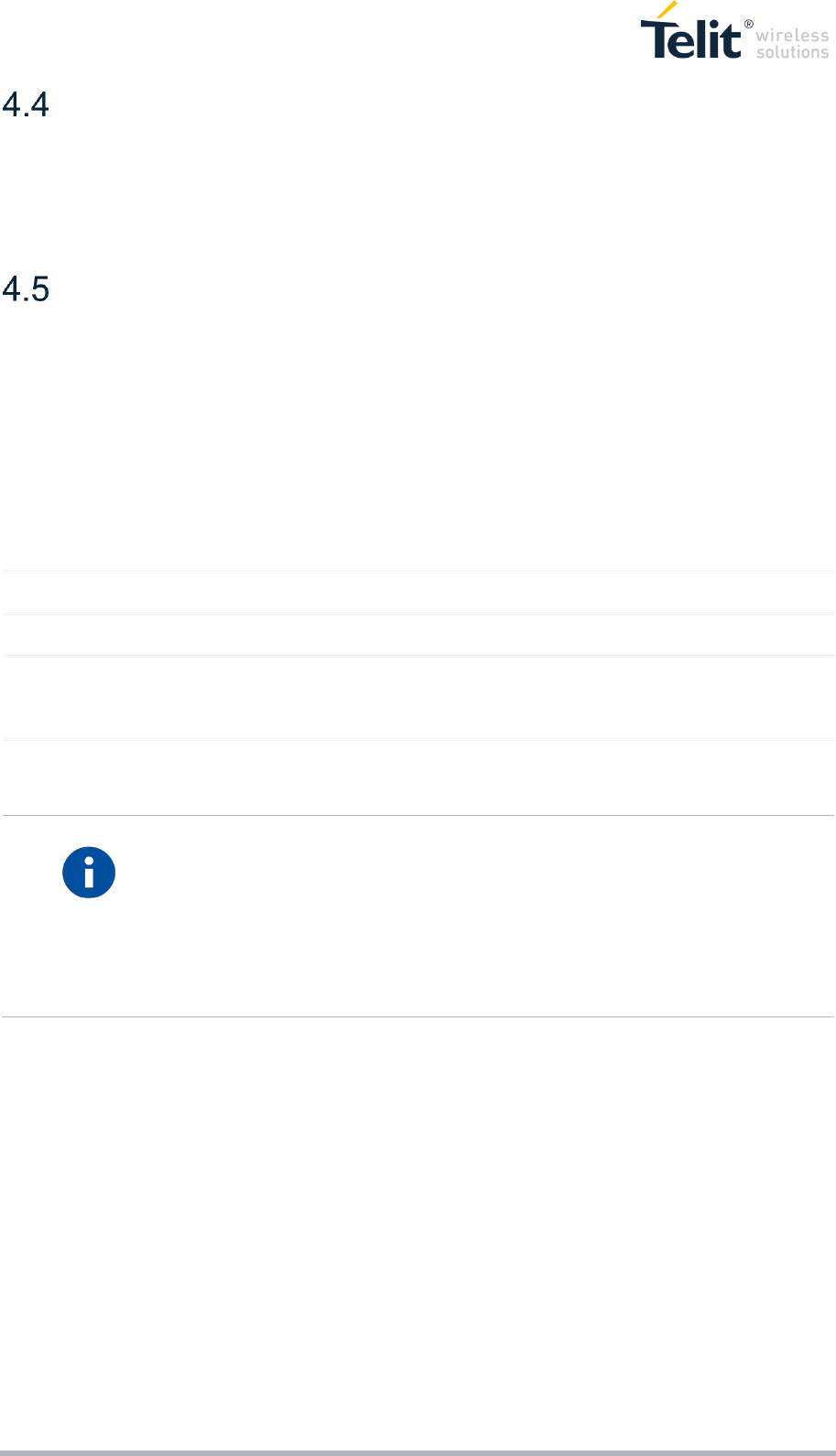
LE866 HARDWARE USER GUIDE 1vv0301210 Rev.0 – Preliminary • 2015-09-02 25 of 68
Reproduction forbidden without Telit Communications PLC written authorization – All Rights Reserved
RTC
The LE866 module is provided by an internal RTC section but its reference supply is VBATT.
So, in order to maintain active the RTC programming, VBATT should not be removed
VAUX Power Output
A regulated power supply output is provided in order to supply small devices from the module. The signal
is present on Pad G6 and it is in common with the PWRMON (module powered ON indication) function.
This output is always active when the module is powered ON.
The operating range characteristics of the supply are:
Item
Min
Typical
Max
Output voltage
1.7V
1.80V
1.9V
Output current
-
-
60mA
Output bypass
capacitor
(inside the module)
TBD
NOTE:
The Output Current MUST never be exceeded; care must be taken when
designing the application section to avoid having an excessive current
consumption.
If the Current is exceeding the limits it could cause a Power Off of the module.
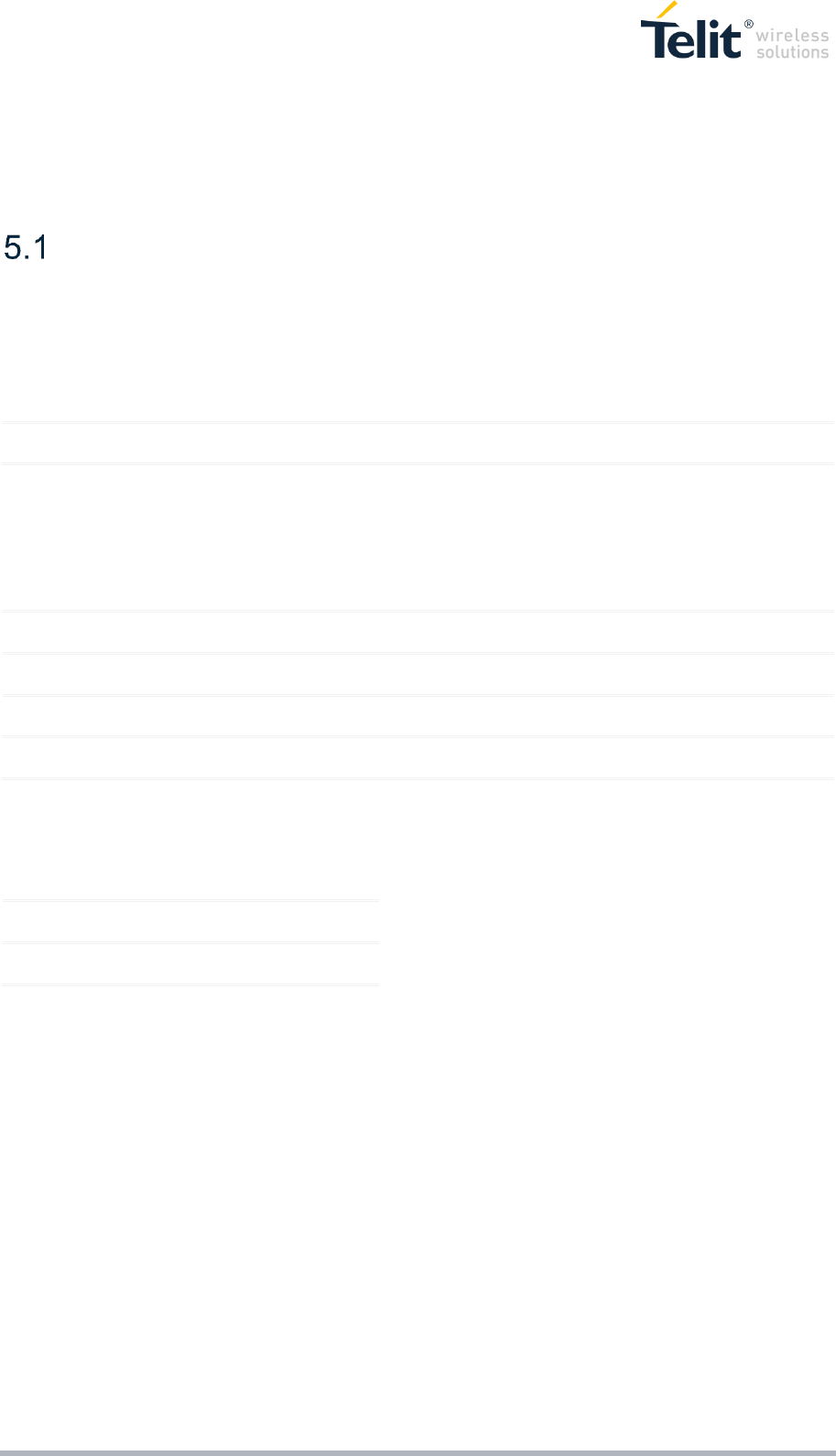
LE866 HARDWARE USER GUIDE 1vv0301210 Rev.0 – Preliminary • 2015-09-02 26 of 68
Reproduction forbidden without Telit Communications PLC written authorization – All Rights Reserved
5 DIGITAL SECTION
Logic Levels Specification
ABSOLUTE MAXIMUM RATINGS – NOT FUNCTIONAL:
OPERATING RANGE - INTERFACE LEVELS (1.8V CMOS):
Parameter
Min
Max
Input high level
1.55V
1.9V
Input low level
0V
0.35V
Output high level
1.35V
1.8V
Output low level
0V
0.8V
CURRENT CHARACTERISTICS:
Parameter
AVG
Output Current
TBD
Input Current
TBD
Parameter
Min
Max
Input level on any digital pin (CMOS 1.8) with respect to ground
-0.3V
2.1V
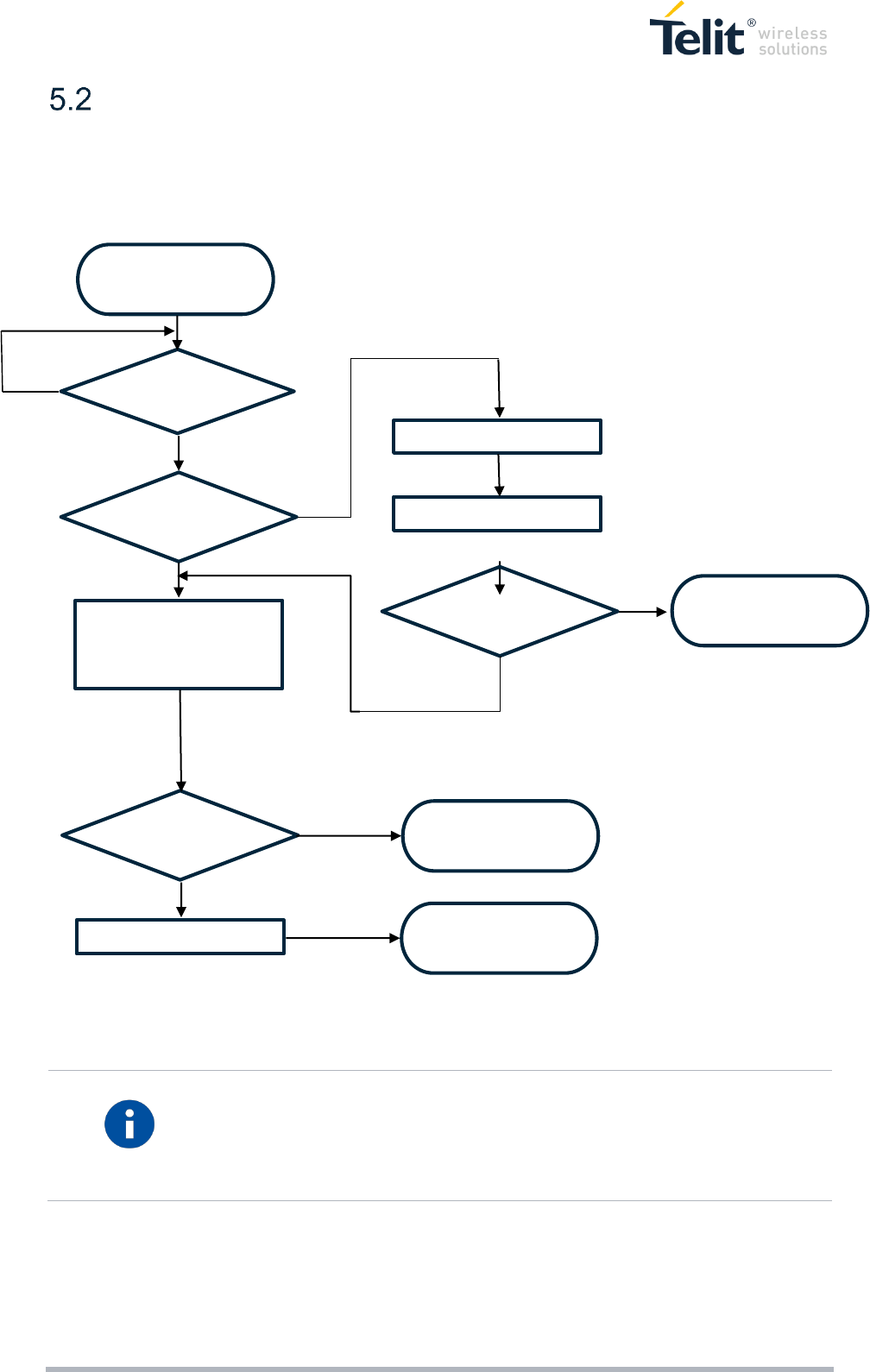
LE866 HARDWARE USER GUIDE 1vv0301210 Rev.0 – Preliminary • 2015-09-02 27 of 68
Reproduction forbidden without Telit Communications PLC written authorization – All Rights Reserved
Power on
The LE866 will automatically power on itself when VBATT & VBATT_PA are applied to the module.
VAUX / PWRMON pin will be at the high logic level and the module can be considered fully operating
after 5 seconds. The following flow chart shows the proper turn on procedure:
NOTE:
The power supply must be applied either at the same time on pins VBATT and
VBATT_PA.
PWRMON=ON
?
“Modem ON Proc”
START
PWR Supply ON
PWRMON=ON
?
Delay = 300 ms
AT Init Sequence
Enter AT<CR>
N
Delay 1s – 5s for Low Voltage
Operating
Y
Y
N
Y
Delay = 1 sec
N
Start AT CMD
AT Answer in
1sec?
Modem Reset Proc
N
Y
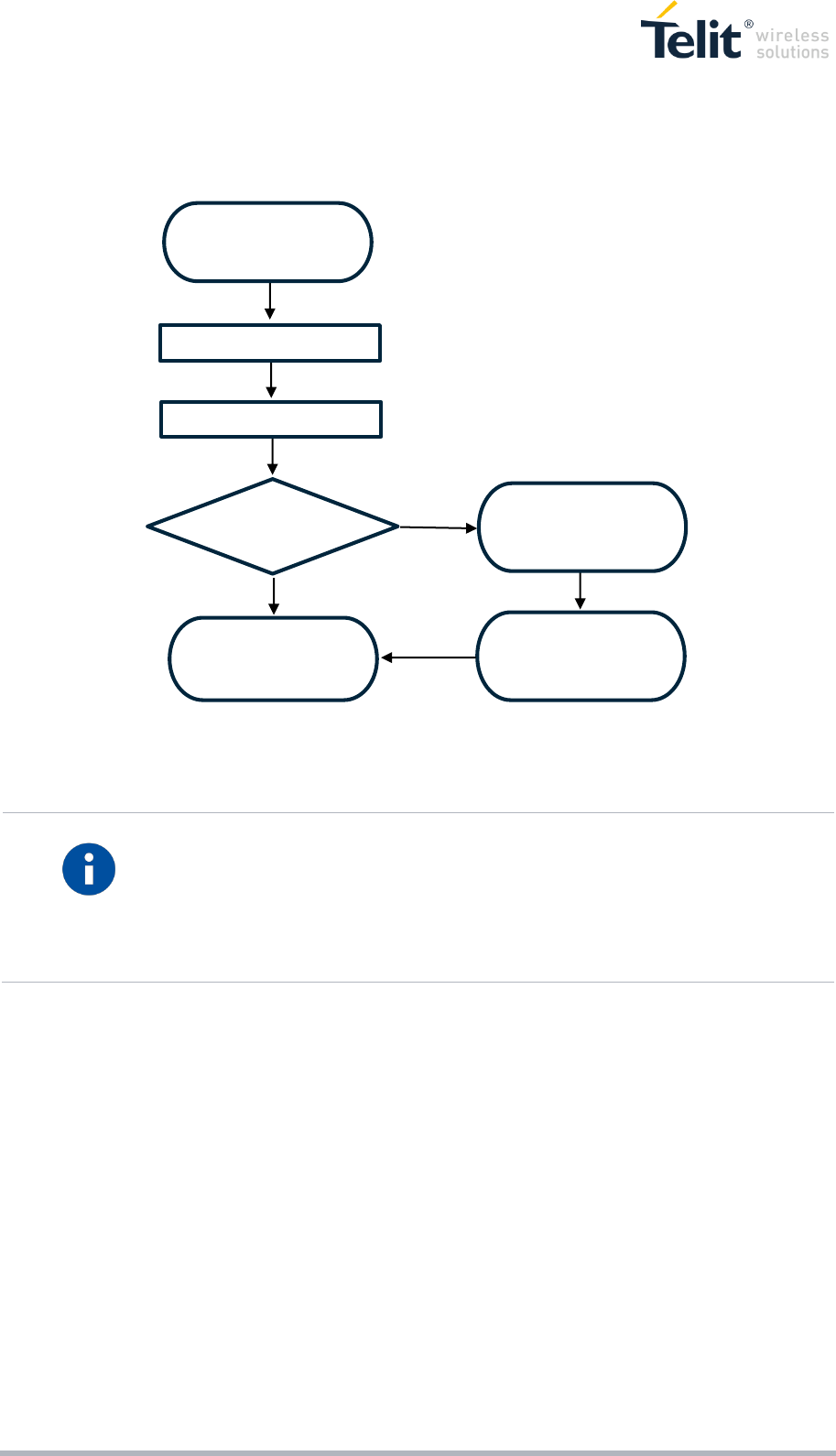
LE866 HARDWARE USER GUIDE 1vv0301210 Rev.0 – Preliminary • 2015-09-02 28 of 68
Reproduction forbidden without Telit Communications PLC written authorization – All Rights Reserved
A flow chart showing the AT commands managing procedure is displayed below:
NOTE:
In order to avoid a back powering effect it is recommended to avoid having any
HIGH logic level signal applied to the digital pins of the LE866 when the module
is powered off or during an ON/OFF transition.
“Start AT CMD”
START
Delay = 300 msec
Enter AT <CR>
Disconnect PWR Supply
AT answer in
1 sec ?
GO TO
“Modem ON Proc.”
“Start AT CMD”
END
Y
N
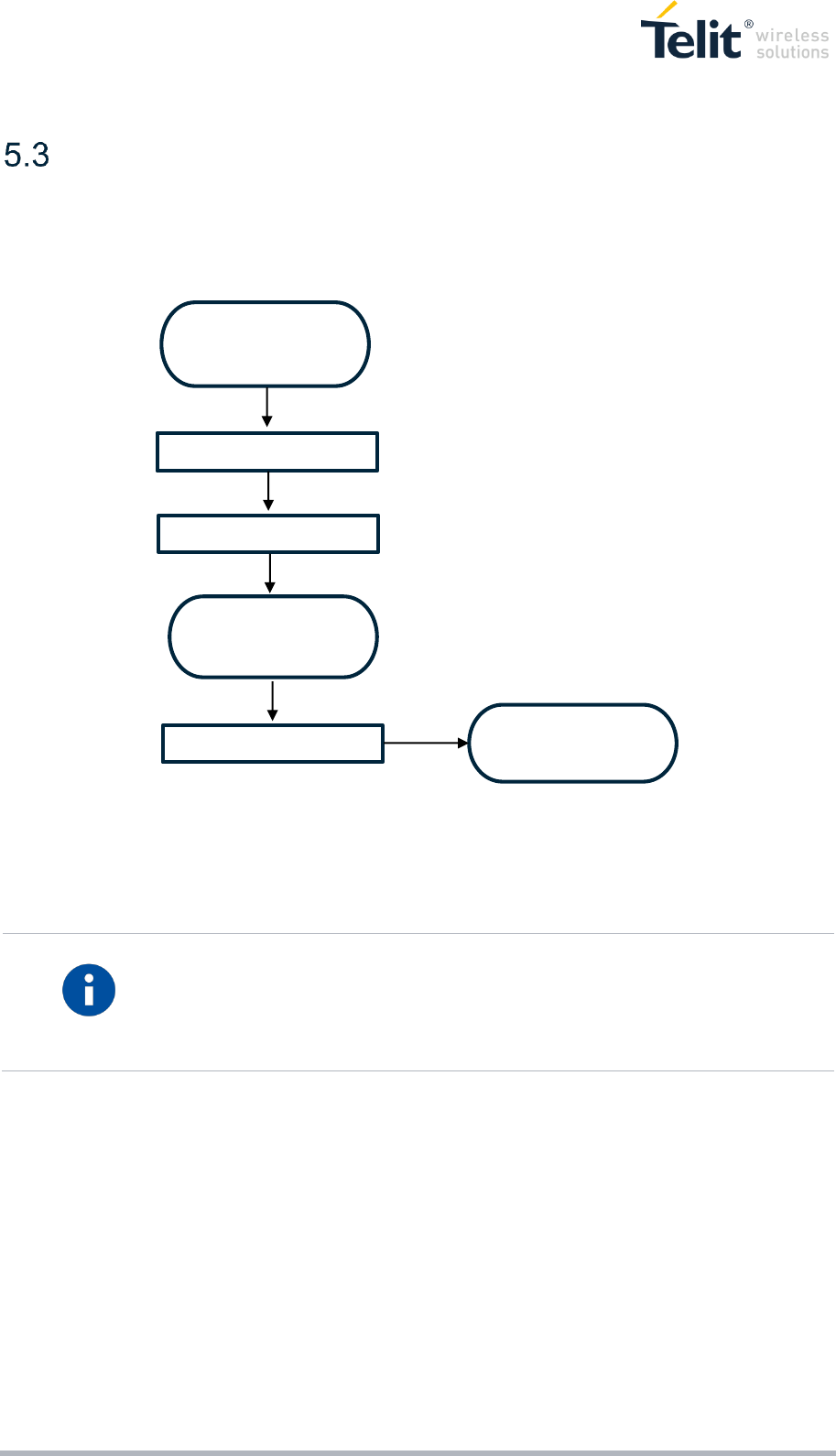
LE866 HARDWARE USER GUIDE 1vv0301210 Rev.0 – Preliminary • 2015-09-02 29 of 68
Reproduction forbidden without Telit Communications PLC written authorization – All Rights Reserved
Power off
The following flowchart shows the proper Turn-off procedure:
In order to avoid a back powering effect it is recommended to avoid having any
HIGH logic level signal applied to the digital pins of the LE866 when the module
is powered off or during an ON/OFF transition.
“Modem OFF Proc”
AT#SYSHALT
10s Timeout
Disconnect PWR Supply
“Modem ON Proc.”
Delay 1.5s
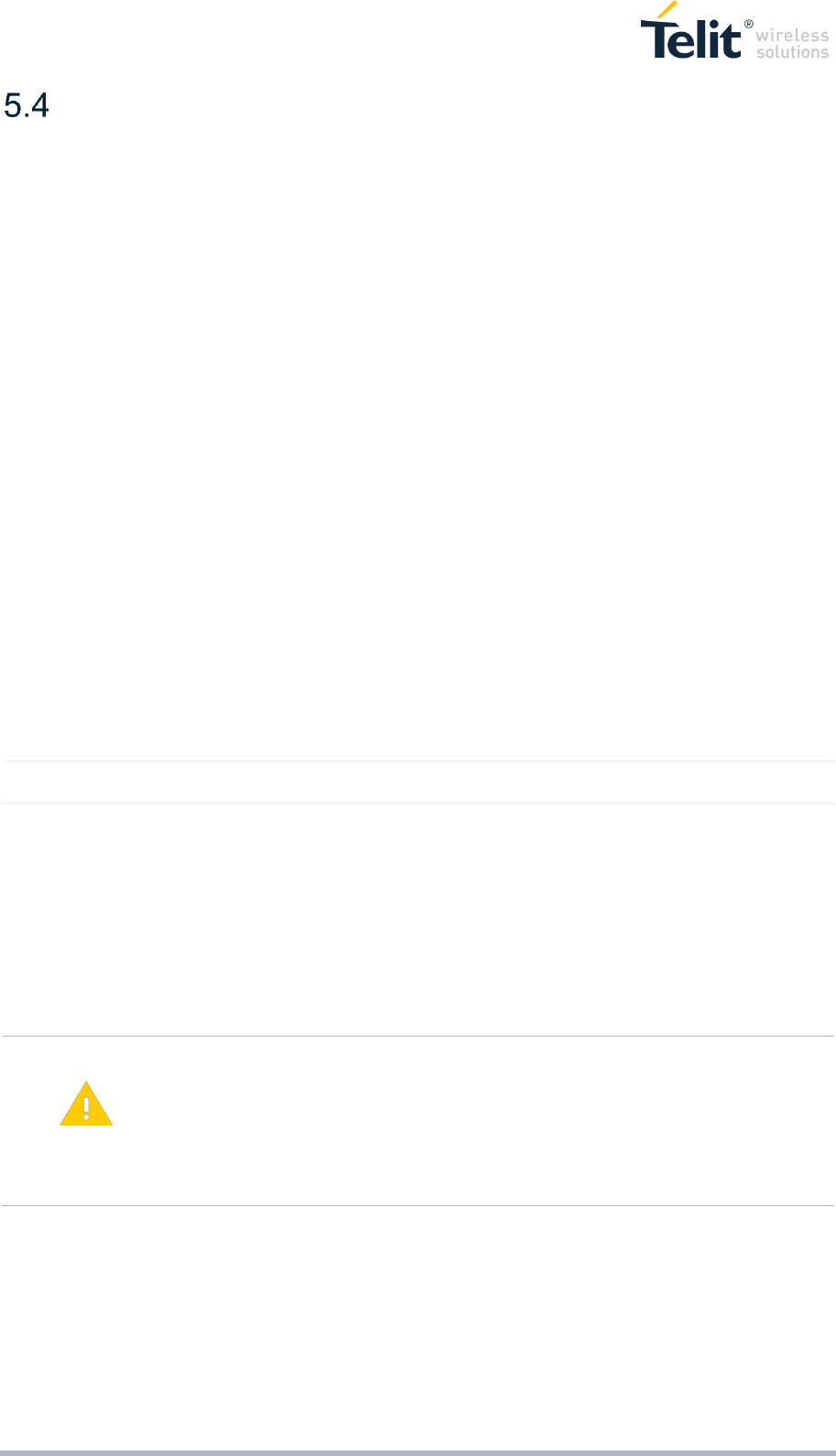
LE866 HARDWARE USER GUIDE 1vv0301210 Rev.0 – Preliminary • 2015-09-02 30 of 68
Reproduction forbidden without Telit Communications PLC written authorization – All Rights Reserved
Reset
To unconditionally reboot the LE866, the pad RESET* must be tied low for at least 200 milliseconds and
then released.
The maximum current that can be drained from the RESET* pad is 0,15 mA.
The hardware unconditional Restart must not be used during normal operation of the device since it
does not detach the device from the network. It shall be kept as an emergency exit procedure to be
done in the rare case that the device gets stuck waiting for some network or SIM responses.
Do not use any pull up resistor on the RESET* line nor any totem pole digital output. Using pull up
resistor may bring to latch up problems on the LE866 power regulator and improper functioning of the
module.
The line RESET* must be connected only in open collector configuration; the transistor must be
connected as close as possible to the RESET* pin.
The unconditional hardware restart must always be implemented on the boards and the software must
use it as an emergency exit procedure.
PIN DESCRIPTION
Signal
Function
I/O
PAD
RESET*
Unconditional Reset of the Module
I
G4
OPERATING LEVELS
The RESET* line is connected to VBATT with a Pull Up so the electrical levels are on this pin are aligned
to the main supply level.
WARNING:
The hardware unconditional Reset must not be used during normal operation of
the device since it does not detach the device from the network. It shall be kept
as an emergency exit procedure.
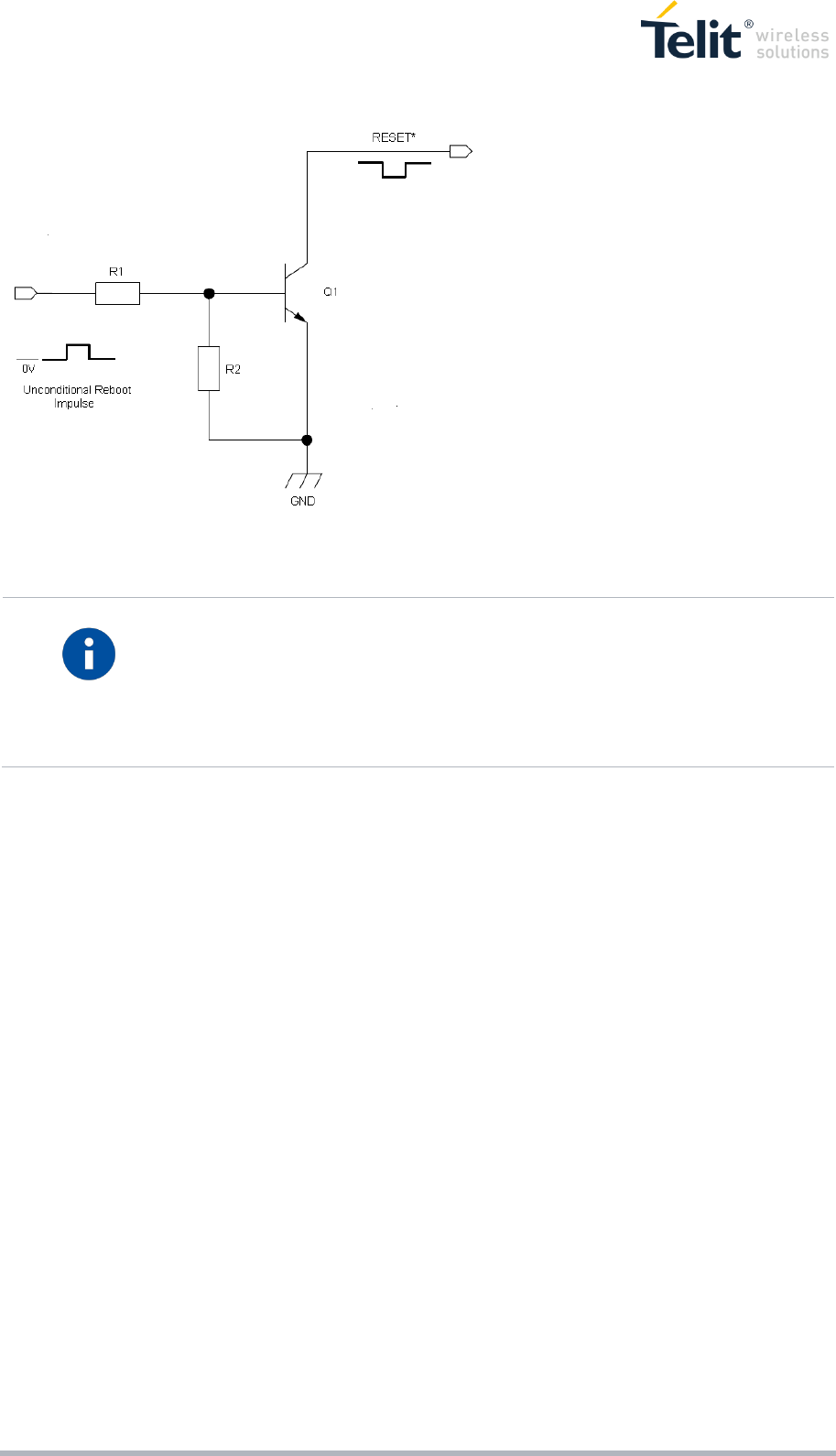
LE866 HARDWARE USER GUIDE 1vv0301210 Rev.0 – Preliminary • 2015-09-02 31 of 68
Reproduction forbidden without Telit Communications PLC written authorization – All Rights Reserved
A typical circuit is the following:
NOTE:
In order to avoid a back powering effect it is recommended to avoid having any
HIGH logic level signal applied to the digital pins of the LE866 when the module
is powered off or during an ON/OFF transition.
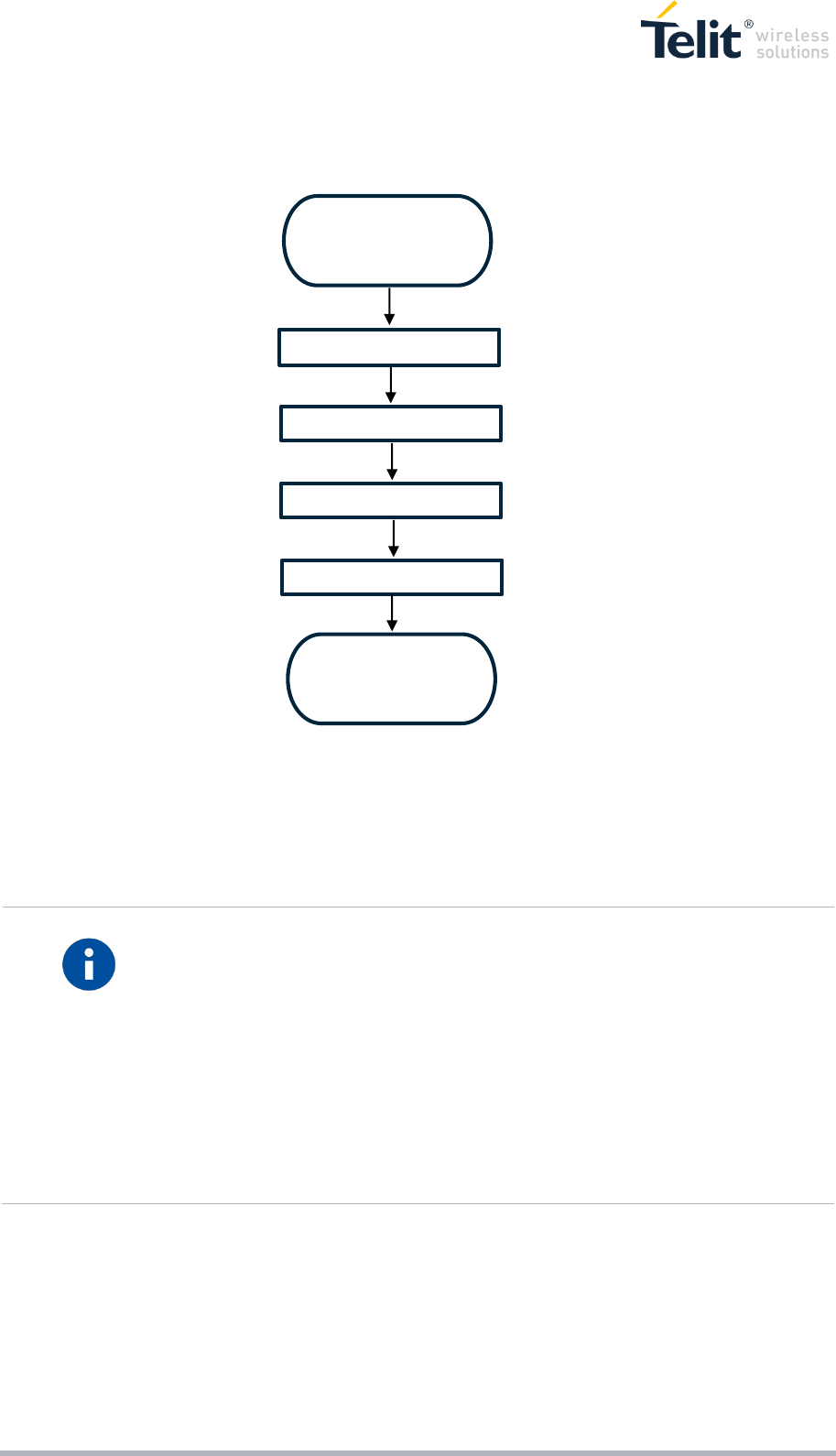
LE866 HARDWARE USER GUIDE 1vv0301210 Rev.0 – Preliminary • 2015-09-02 32 of 68
Reproduction forbidden without Telit Communications PLC written authorization – All Rights Reserved
In the following flow chart is detailed the proper restart procedure:
NOTE:
Do not use any pull up resistor on the RESET* line nor any totem pole digital
output. Using pull up resistor may bring to latch up problems on the LE866 power
regulator and improper functioning of the module.
To proper power on again the module please refer to the related paragraph
(“Power ON”)
The unconditional hardware shutdown must always be implemented on the
boards and should be used only as an emergency exit procedure.
Modem RESET
Proc.
RESET* = LOW
Delay = 200ms
Start At CMD
RESET* = HIGH
Delay = 1s
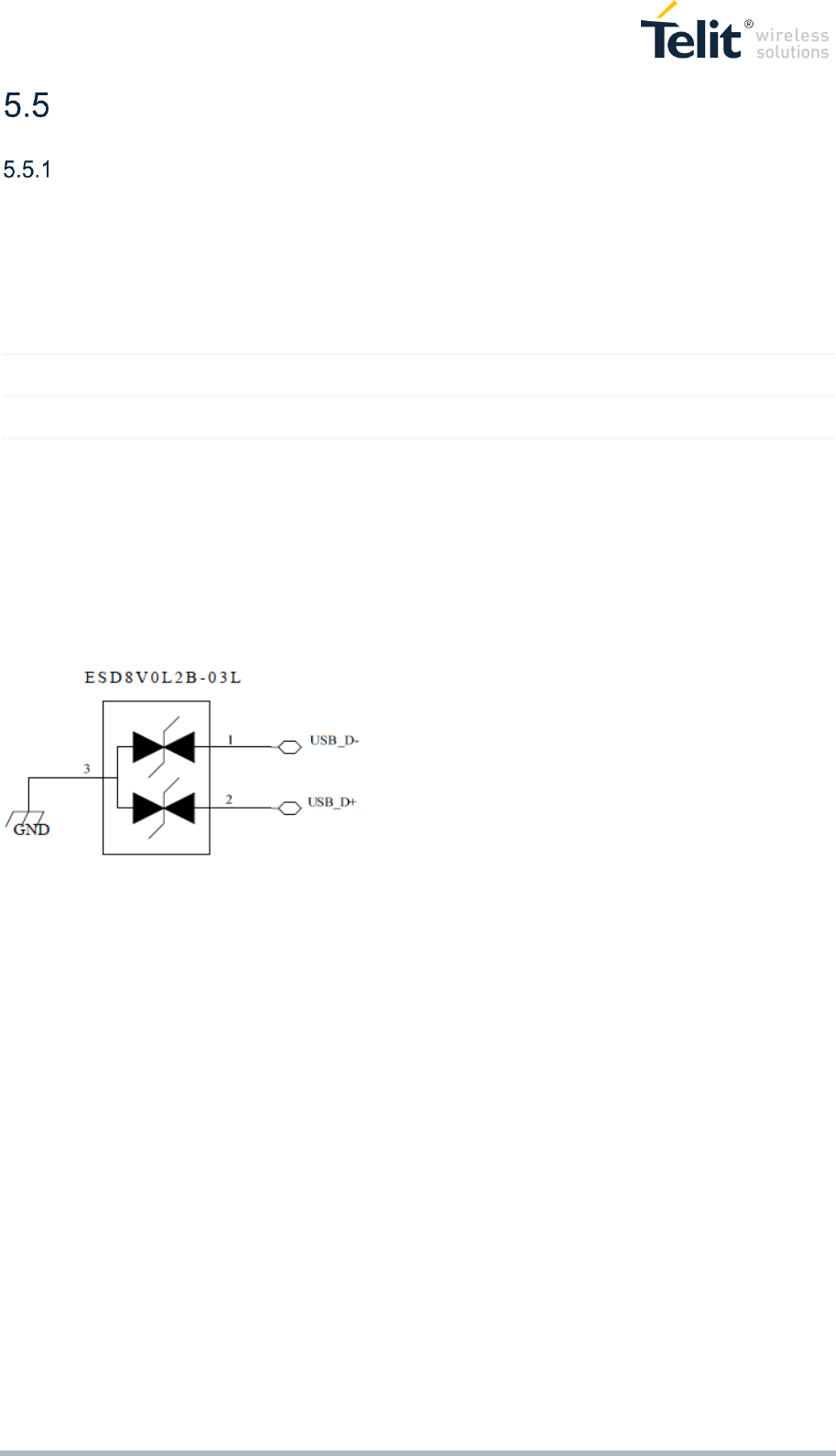
LE866 HARDWARE USER GUIDE 1vv0301210 Rev.0 – Preliminary • 2015-09-02 33 of 68
Reproduction forbidden without Telit Communications PLC written authorization – All Rights Reserved
Communication ports
USB 2.0 HS
The LE866 includes one integrated universal serial bus (USB 2.0 HS) transceiver.
The following table is listing the available signals:
PAD
Signal
I/O
Function
Type
NOTE
E5
USB_D+
I/O
USB differential Data (+)
3.3V
E6
USB_D-
I/O
USB differential Data (-)
3.3V
The USB_DPLUS and USB_DMINUS signals have a clock rate of 480 MHz.
The signal traces should be routed carefully. Trace lengths, number of vias and capacitive loading
should be minimized. The characteristic impedance value should be as close as possible to 90 Ohms
differential.
In case there is a need to add an ESD protection, the suggested connection is the following:
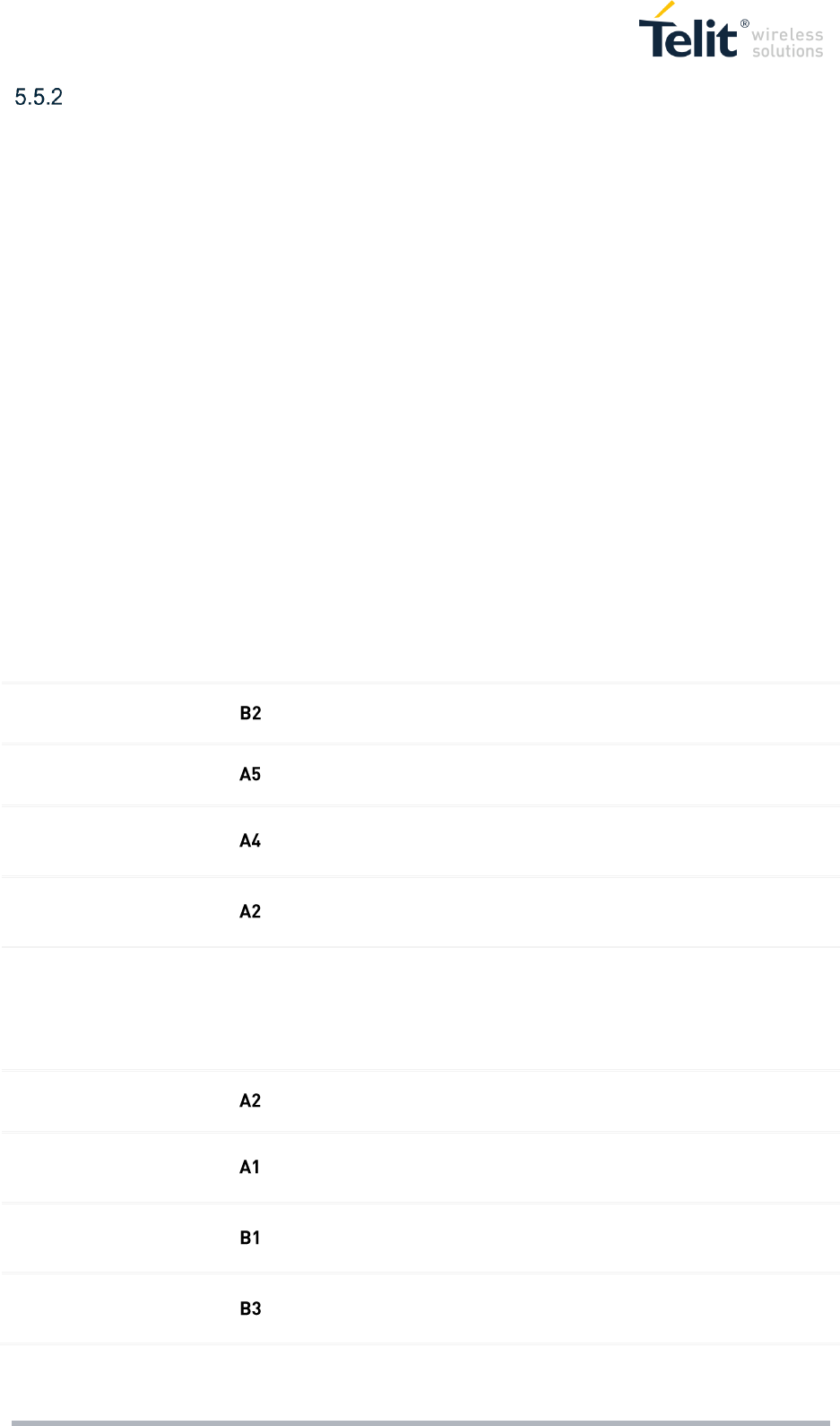
LE866 HARDWARE USER GUIDE 1vv0301210 Rev.0 – Preliminary • 2015-09-02 34 of 68
Reproduction forbidden without Telit Communications PLC written authorization – All Rights Reserved
Serial Ports
The LE866 module is provided with by 2 Asynchronous serial ports:
MODEM SERIAL PORT 1 (Main)
MODEM SERIAL PORT 2 (Auxiliary)
Several configurations can be designed for the serial port on the OEM hardware, but the most common
are:
RS232 PC com port
microcontroller UART @ 1.8V (Universal Asynchronous Receive Transmit)
microcontroller UART @ 5V or other voltages different from 1.8V
Depending from the type of serial port on the OEM hardware a level translator circuit may be needed to
make the system work.
On the LE866 the ports are CMOS 1.8.
5.5.2.1 MODEM SERIAL PORT 1 (USIF0)
The serial port 1 on the LE866 is a +1.8V UART with all the 7 RS232 signals.
It differs from the PC-RS232 in the signal polarity (RS232 is reversed) and levels.
The following table is listing the available signals:
RS232
Pin
Signal
Pad
Name
Usage
1
C109/DCD
Data Carrier Detect
Output from the LE866 that indicates the
carrier presence
2
C104/RXD
Transmit line *see
Note
Output transmit line of LE866 UART
3
C103/TXD
Receive line *see
Note
Input receive of the LE866 UART
4
C108/DTR
Data Terminal Ready
Input to the LE866 that controls the DTE
READY condition
5
GND
D1, F1, G1,
D2, F2, C3,
E3, F3, G3,
F6, A8, G8,
A11, G11
Ground
Ground
6
C107/DSR
Data Set Ready
Output from the LE866 that indicates the
module is ready
7
C106/CTS
Clear to Send
Output from the LE866 that controls the
Hardware flow control
8
C105/RTS
Request to Send
Input to the LE866 that controls the
Hardware flow control
9
C125/RING
Ring Indicator
Output from the LE866 that indicates the
incoming call condition

LE866 HARDWARE USER GUIDE 1vv0301210 Rev.0 – Preliminary • 2015-09-02 35 of 68
Reproduction forbidden without Telit Communications PLC written authorization – All Rights Reserved
NOTE:
According to V.24, some signal names are referred to the application side,
therefore on the LE866 side these signal are on the opposite direction:
TXD on the application side will be connected to the receive line (here named
C103/TXD)
RXD on the application side will be connected to the transmit line (here named
C104/RXD)
For a minimum implementation, only the TXD, RXD lines can be connected, the
other lines can be left open provided a software flow control is implemented.
In order to avoid a back powering effect it is recommended to avoid having any
HIGH logic level signal applied to the digital pins of the LE866 when the module
is powered off or during an ON/OFF transition.

LE866 HARDWARE USER GUIDE 1vv0301210 Rev.0 – Preliminary • 2015-09-02 36 of 68
Reproduction forbidden without Telit Communications PLC written authorization – All Rights Reserved
5.5.2.2 MODEM SERIAL PORT 2 (USIF1)
The secondary serial port on the LE866 is a CMOS1.8V with only the RX and TX signals.
The signals of the LE866 serial port are:
PAD
Signal
I/O
Function
Type
NOTE
C1
TX_AUX
O
Auxiliary UART (TX Data to
DTE)
CMOS 1.8V
Shared with SPI_MOSI
C2
RX_AUX
I
Auxiliary UART (RX Data
from DTE)
CMOS 1.8V
Shared with SPI_MISO
NOTE:
Due to the shared pins, when the Modem Serial port is used, it is not possible to
use the SPI functions.
In order to avoid a back powering effect it is recommended to avoid having any
HIGH logic level signal applied to the digital pins of the LE866 when the module
is powered off or during an ON/OFF transition.
5.5.2.3 RS232 LEVEL TRANSLATION
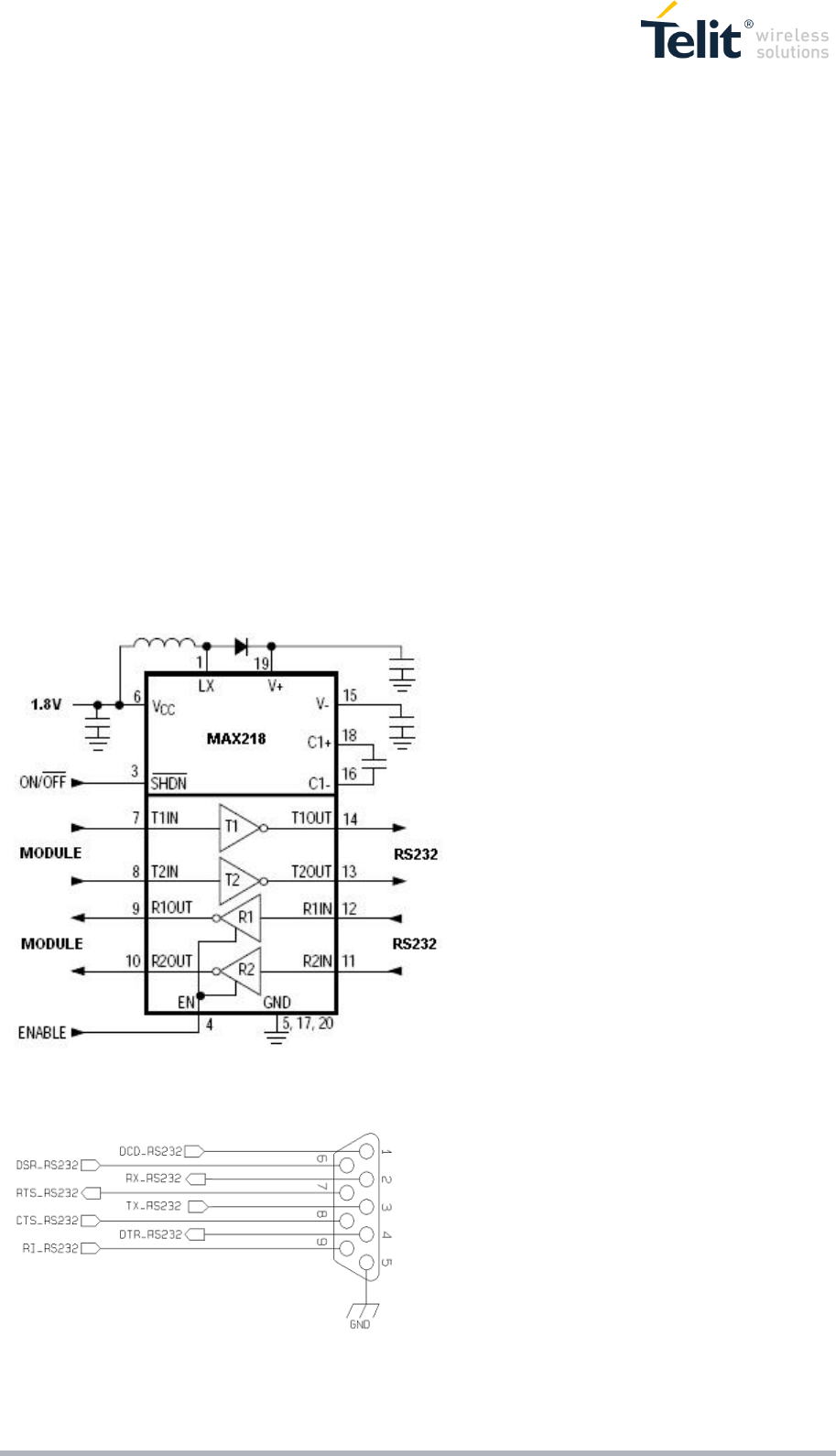
LE866 HARDWARE USER GUIDE 1vv0301210 Rev.0 – Preliminary • 2015-09-02 37 of 68
Reproduction forbidden without Telit Communications PLC written authorization – All Rights Reserved
In order to interface the LE866 with a PC com port or a RS232 (EIA/TIA-232)
application a level translator is required. This level translator must:
invert the electrical signal in both directions;
Change the level from 0/1.8V to +15/-15V.
Actually, the RS232 UART 16450, 16550, 16650 & 16750 chipsets accept signals with lower levels on
the RS232 side (EIA/TIA-562), allowing a lower voltage-multiplying ratio on the level translator. Note
that the negative signal voltage must be less than 0V and hence some sort of level translation is always
required.
The simplest way to translate the levels and invert the signal is by using a single chip level translator.
There are a multitude of them, differing in the number of drivers and receivers and in the levels (be sure
to get a true RS232 level translator not a RS485 or other standards).
By convention the driver is the level translator from the 0-1.8V UART to the RS232 level. The receiver
is the translator from the RS232 level to 0-1.8V UART.
In order to translate the whole set of control lines of the UART you will need:
5 drivers
3 receivers
An example of RS232 level adaptation circuitry could be done using a MAXIM transceiver (MAX218)
In this case the chipset is capable to translate directly from 1.8V to the RS232 levels (Example done on
4 signals only).
The RS232 serial port lines are usually connected to a DB9 connector with the following layout:
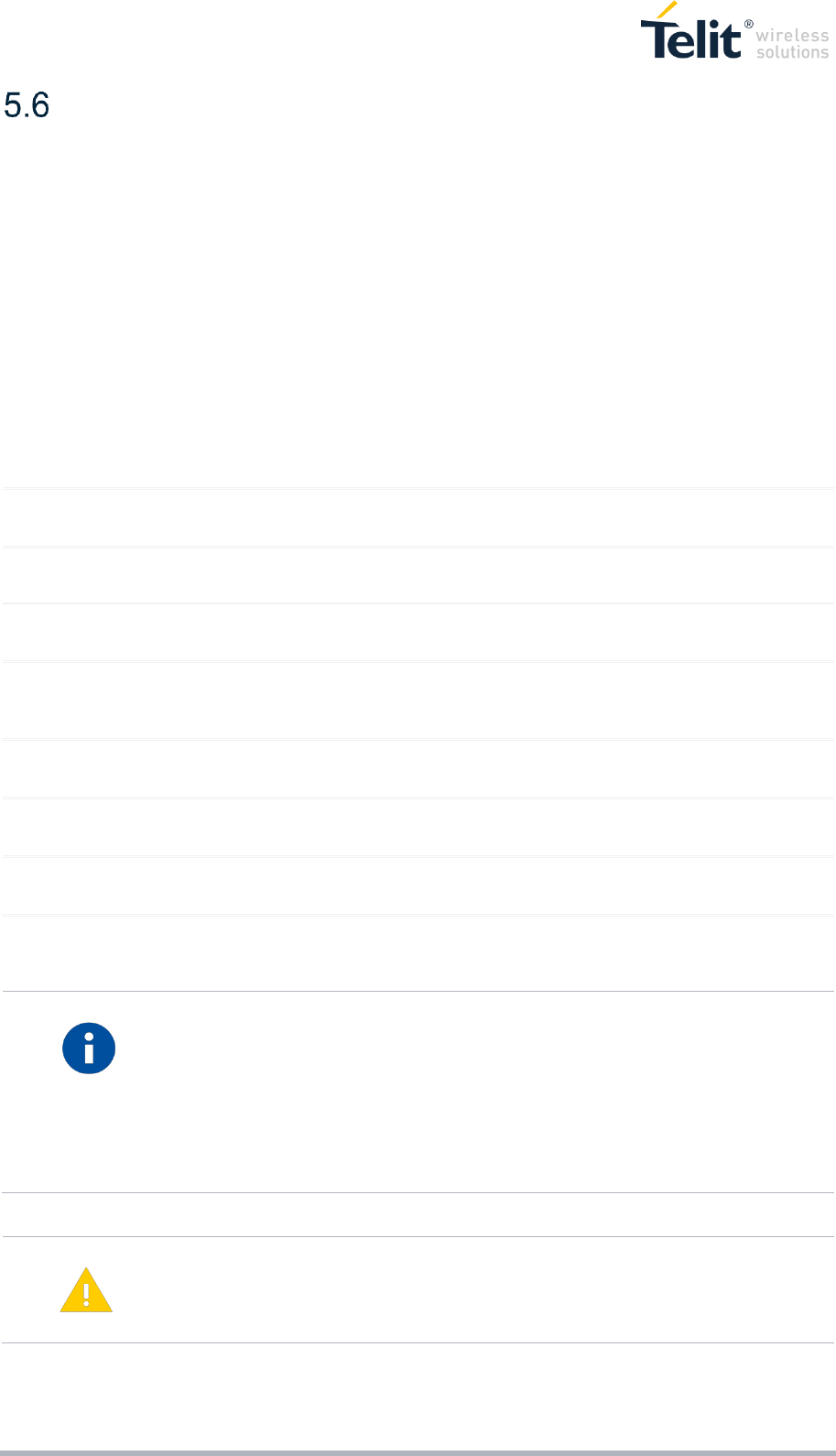
LE866 HARDWARE USER GUIDE 1vv0301210 Rev.0 – Preliminary • 2015-09-02 38 of 68
Reproduction forbidden without Telit Communications PLC written authorization – All Rights Reserved
General Purpose I/O
The LE866 module is provided by a set of Configurable Digital Input / Output pins (CMOS 1.8V)
Input pads can only be read; they report the digital value (high or low) present on the pad at the read
time.
Output pads can only be written or queried and set the value of the pad output.
An alternate function pad is internally controlled by the LE866 firmware and acts depending on the
function implemented.
The following table shows the available GPIO on the LE866:
PAD
Signal
I/O
Drive
Strength
Default
State
NOTE
C5
GPIO_01
I/O
TBD mA
INPUT
Alternate functions:
Digital Audio Interface (WA0
C6
GPIO_02
I/O
TBD mA
INPUT
Alternate functions:
Digital Audio Interface (RX)
D6
GPIO_03
I/O
TBD mA
INPUT
Alternate functions:
Digital Audio Interface (TX)
D5
GPIO_04
I/O
TBD mA
INPUT
Alternate functions:
TX Disable
Digital Audio Interface (CLK)
B5
GPIO_05
I/O
TBD mA
INPUT
Alternate functions:
TX_Monitor
B4
GPIO_06
I/O
TBD mA
INPUT
Alternate functions:
ALARM
C4
GPIO_07
I/O
TBD mA
INPUT
Alternate functions:
STAT LED
NOTE:
The internal GPIO’s pull up/pull down could be set to the preferred status for the
application using the AT#GPIO command.
Please refer for the AT Commands User Guide for the detailed command
Syntax.
WARNING:
During power up the GPIOs may be subject to transient glitches.
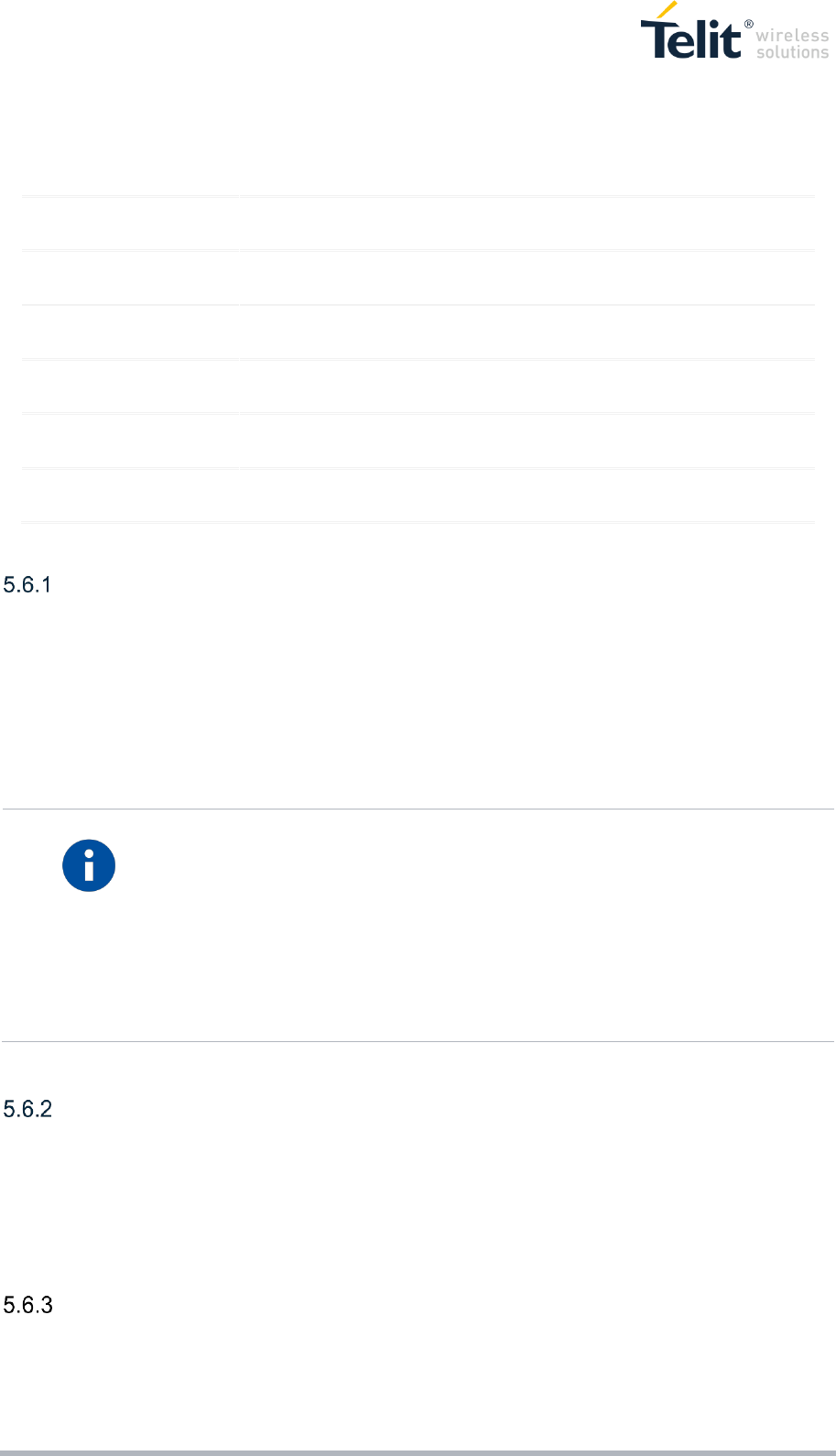
LE866 HARDWARE USER GUIDE 1vv0301210 Rev.0 – Preliminary • 2015-09-02 39 of 68
Reproduction forbidden without Telit Communications PLC written authorization – All Rights Reserved
Also the UART’s control flow pins can be usable as GPIO:
PAD
Signal
I/O
Input/output
current
Default
State
ON_OFF
state
Reset
State
NOTE
B2
GPO_A
O
TBD
INPUT
0
0
Alternate function
C109/DCD
B3
GPO_B
O
TBD
INPUT
0
0
Alternate function
C125/RING
A3
GPO_C
O
TBD
INPUT
0
0
Alternate function
C107/DSR
A2
GPI_E
I
TBD
INPUT
0
0
Alternate function
C108/DTR
A1
GPI_F
I
TBD
INPUT
0
0
Alternate function
C105/RTS
B1
GPO_D
O
TBD
INPUT
0
0
Alternate function
C106/CTS
Using a GPIO as INPUT
The GPIO pads, when used as inputs, can be connected to a digital output of another device and report
its status, provided this device has interface levels compatible with the 1.8V CMOS levels of the GPIO.
If the digital output of the device to be connected with the GPIO input pad has interface levels different
from the 1.8V CMOS, then it can be buffered with an open collector transistor with a 47K pull up to
VAUX.
NOTE:
In order to avoid a back powering effect it is recommended to avoid having any
HIGH logic level signal applied to the digital pins of the LE866 when the module
is powered off or during an ON/OFF transition.
The V_AUX / PWRMON pin can be used for input pull up reference or/and for
ON monitoring.
Using a GPIO as OUTPUT
The GPIO pads, when used as outputs, can drive 1.8V CMOS digital devices or compatible hardware.
When set as outputs, the pads have a push-pull output and therefore the pull-up resistor may be omitted.
Indication of network service availability
The STAT_LED pin status shows information on the network service availability and Call status.
The function is available as alternate function of GPIO_07 (to be enabled using the AT#GPIO=7,0,2
command).
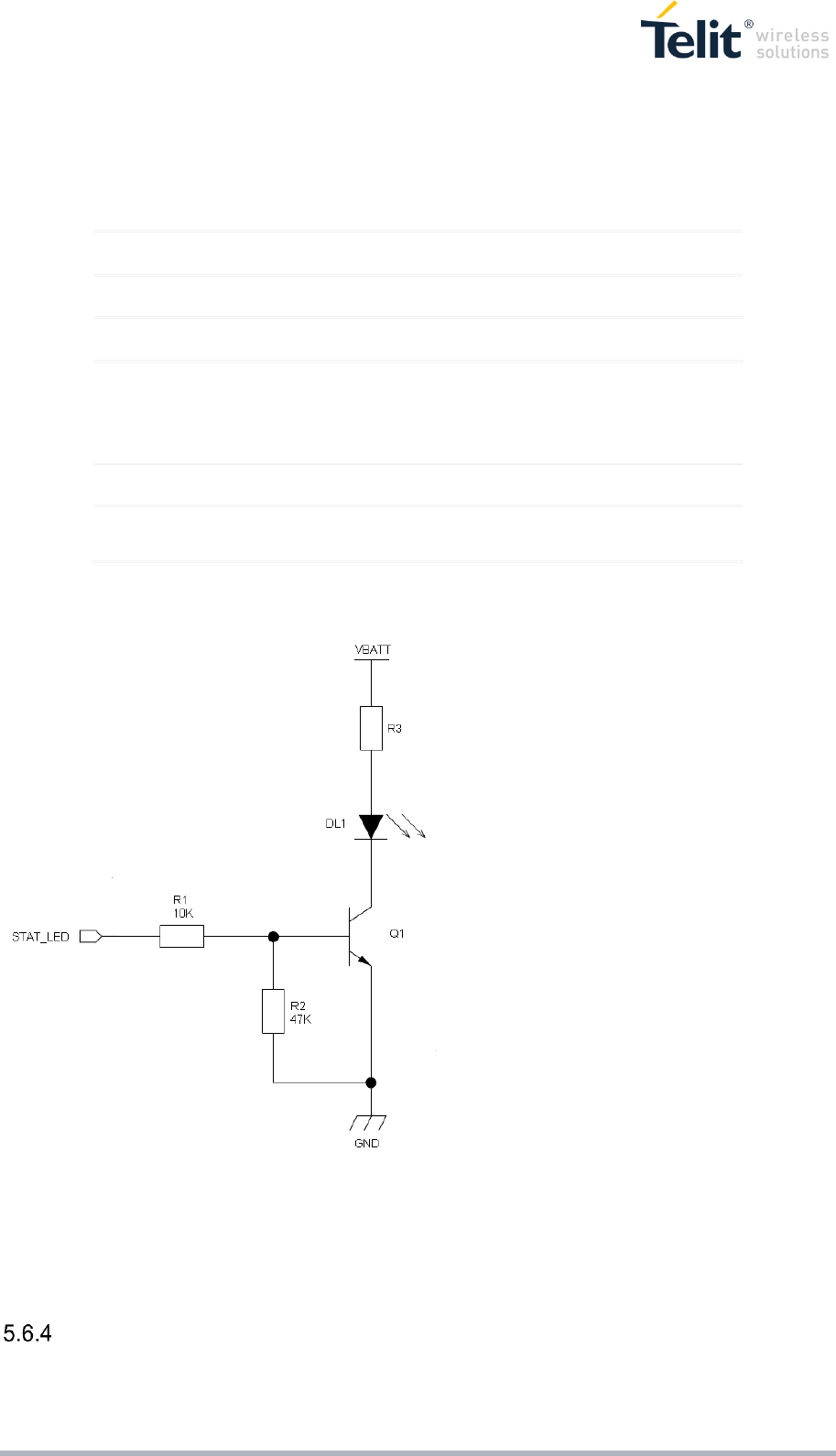
LE866 HARDWARE USER GUIDE 1vv0301210 Rev.0 – Preliminary • 2015-09-02 40 of 68
Reproduction forbidden without Telit Communications PLC written authorization – All Rights Reserved
In the LE866 modules, the STAT_LED needs an external transistor to drive
an external LED.
Therefore, the status indicated in the following table is reversed with respect to the pin status.
Device Status
Led Status
Device off
Permanently off
Not Registered
Permanently on
Registered in idle
Blinking 1sec on + 2 sec off
Registered in idle + power saving
It depends on the event that
triggers the wakeup (In sync with
network paging)
Voice Call Active
Permanently on
Dial-Up
Blinking 1 sec on + 2 sec off
A schematic example could be:
SIMIN Detection
All the GPIO pins can be used as SIM DETECT input. The AT Command used to enable the function
is:

LE866 HARDWARE USER GUIDE 1vv0301210 Rev.0 – Preliminary • 2015-09-02 41 of 68
Reproduction forbidden without Telit Communications PLC written authorization – All Rights Reserved
AT#SIMINCFG
Use the AT command AT#SIMDET=2 to enable the SIMIN detection
Use the AT command AT&W0 and AT&P0 to store the SIMIN detection in the common profile.
NOTE:
Don’t use the SIM IN function on the same pin where the GPIO function is
enabled and vice versa!
External SIM Holder
Please refer to the related User Guide (SIM Holder Design Guides, 80000NT10001a).

LE866 HARDWARE USER GUIDE 1vv0301210 Rev.0 – Preliminary • 2015-09-02 42 of 68
Reproduction forbidden without Telit Communications PLC written authorization – All Rights Reserved
ADC Converter
The LE866 is provided by one AD converter. It is able to read a voltage level in the range of 0÷1.2 volts
applied on the ADC pin input, store and convert it into 10 bit word.
The input line is named as ADC_IN1 and it is available on Pad F4
The following table is showing the ADC characteristics:
Item
Min
Typical
Max
Unit
Input Voltage range
0
-
1.0
Volt
AD conversion
-
-
10
bits
Input Resistance
TBD
-
-
Mohm
Input Capacitance
-
TBD
-
pF
The ADC could be controlled using an AT command.
The command is AT#ADC=1,2
The read value is expressed in mV
Refer to SW User Guide or AT Commands Reference Guide for the full description of this function.
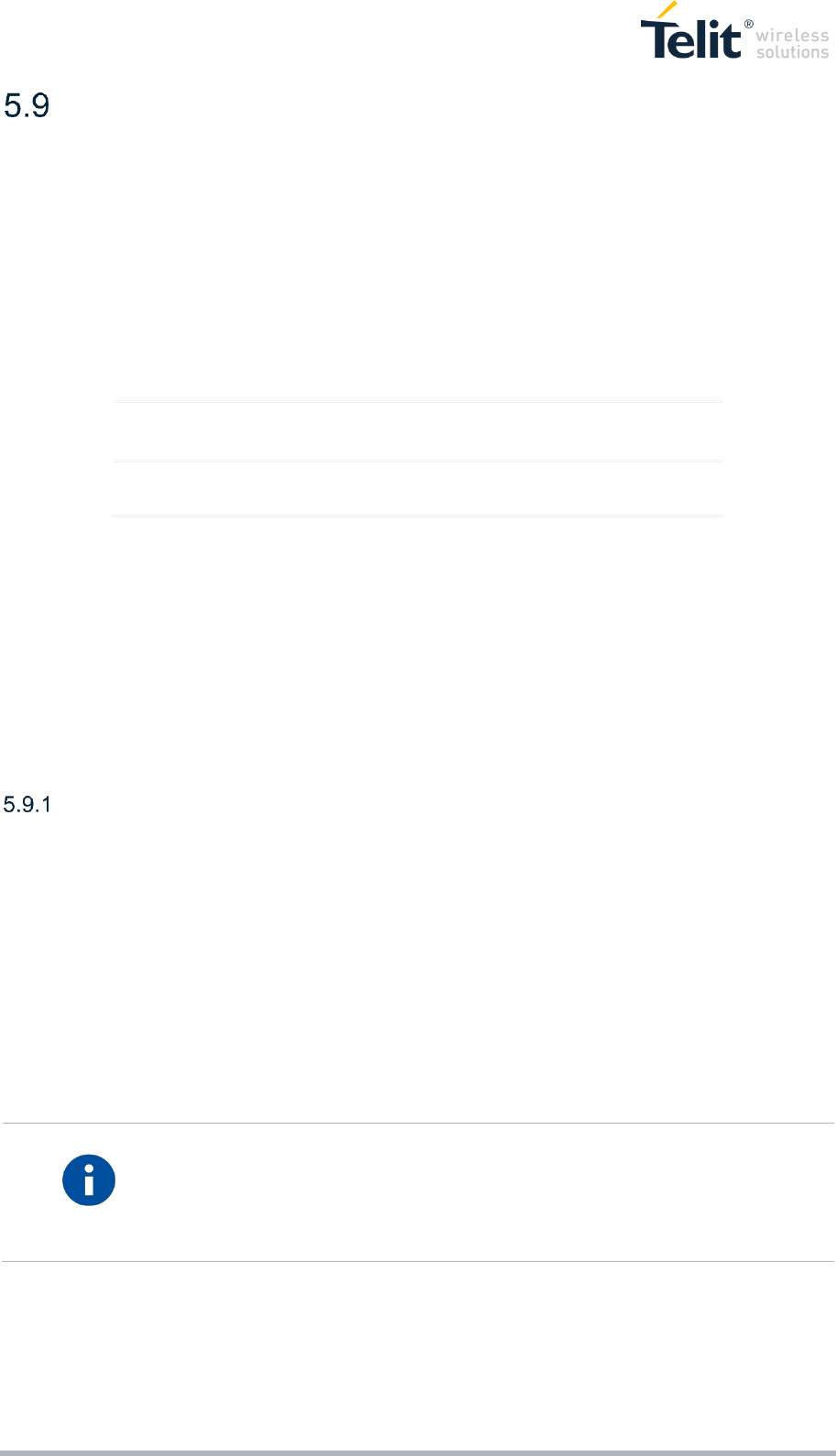
LE866 HARDWARE USER GUIDE 1vv0301210 Rev.0 – Preliminary • 2015-09-02 43 of 68
Reproduction forbidden without Telit Communications PLC written authorization – All Rights Reserved
DAC Converter
The LE866 provides a Digital to Analog Converter. The signal (named DAC_OUT) is available on pin
E4 of the LE866.
The on board DAC is a 10 bit converter, able to generate an analogue value based on a specific input
in the range from 0 up to 1023. However, an external low-pass filter is necessary
The following table is showing the ADC characteristics:
Item
Min
Max
Unit
Voltage range (filtered)
0
1.8
Volt
Range
0
1023
Steps
The precision is 10 bits so, if we consider that the maximum voltage is 2V, the integrated voltage could
be calculated with the following formula:
Integrated output voltage = (2 *value) / 1023
DAC_OUT line must be integrated (for example with a low band pass filter) in order to obtain an
analog voltage.
Enabling DAC
An AT command is available to use the DAC function.
The command is: AT#DAC= [<enable> [, <value>]]
<value> - scale factor of the integrated output voltage (0..1023 - 10 bit precision)
it must be present if <enable>=1
Refer to SW User Guide or AT Commands Reference Guide for the full description of this function.
NOTE:
The DAC frequency is selected internally. D/A converter must not be used during
POWERSAVING.
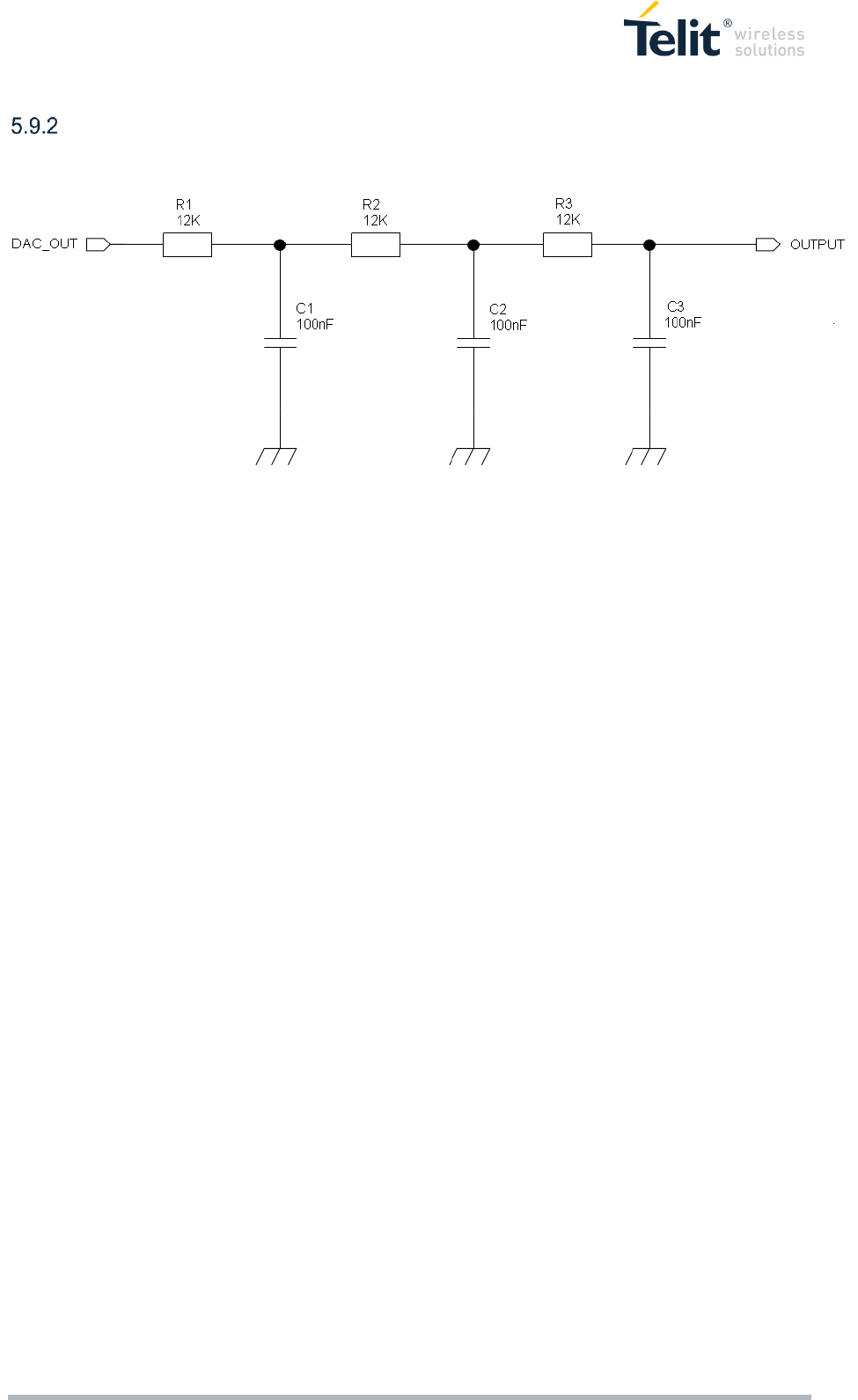
LE866 HARDWARE USER GUIDE 1vv0301210 Rev.0 – Preliminary • 2015-09-02 44 of 68
Reproduction forbidden without Telit Communications PLC written authorization – All Rights Reserved
LOW Pass filter Example
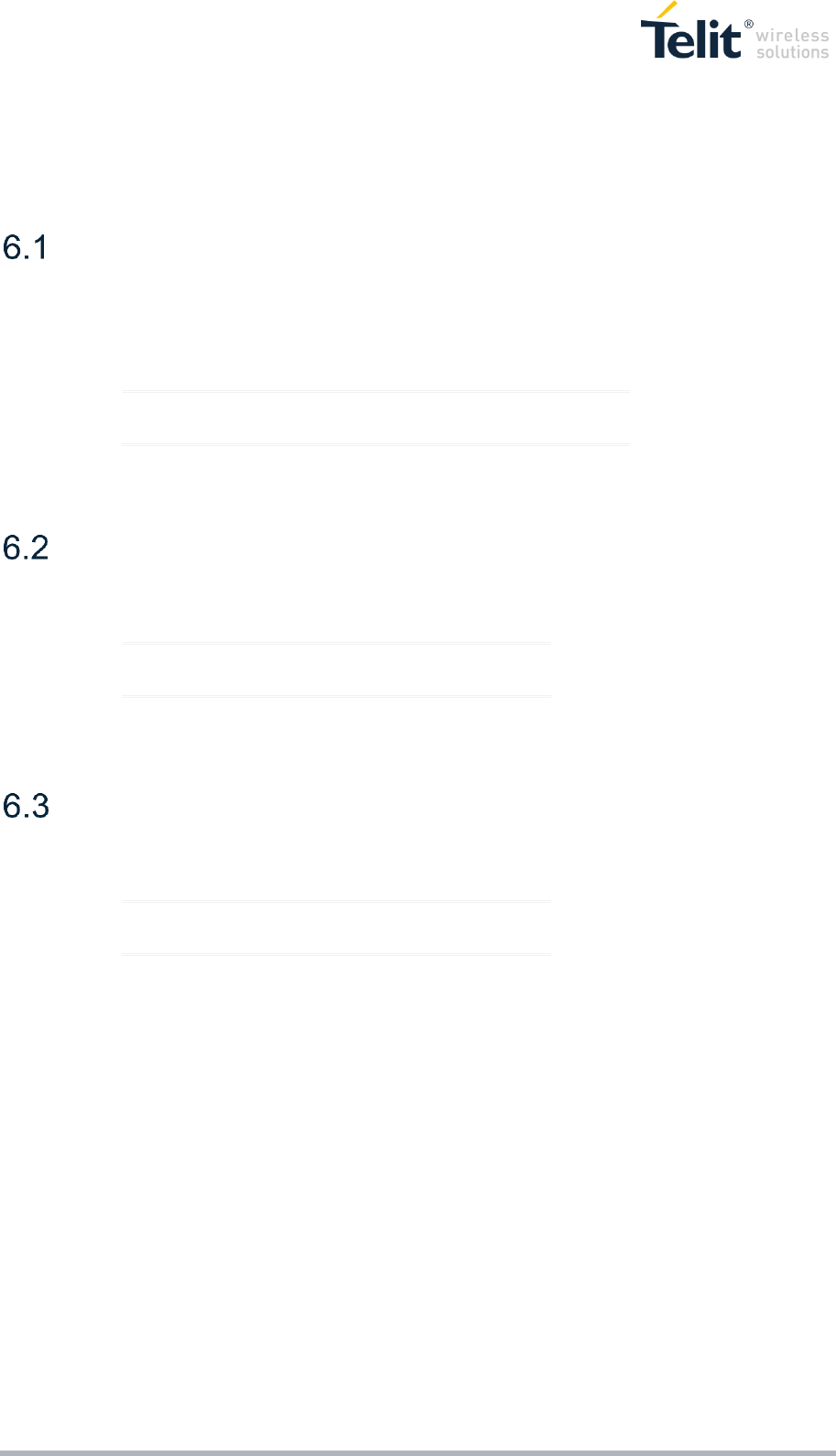
LE866 HARDWARE USER GUIDE 1vv0301210 Rev.0 – Preliminary • 2015-09-02 45 of 68
Reproduction forbidden without Telit Communications PLC written authorization – All Rights Reserved
6 RF SECTION
Bands Variants
The following table is listing the supported Bands:
TX Output Power
RX Sensitivity
Product
Supported 3G bands
LE866-SV1
FDD B4, B13
Band
Power Class
FDD B4, B13
Class 3 (0.2W)
Band
Sensitivity
FDD B4, B13
-102dBm
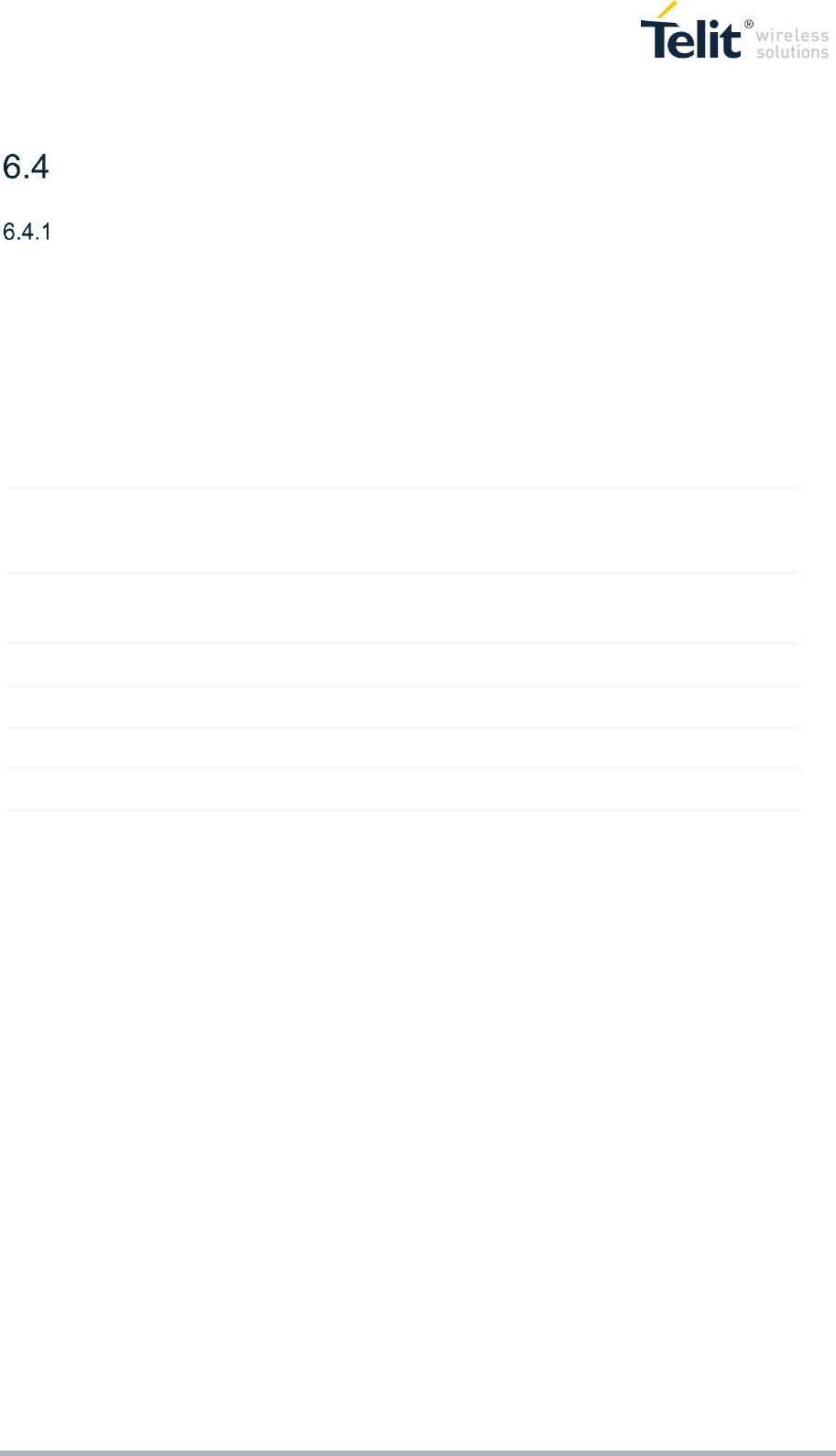
LE866 HARDWARE USER GUIDE 1vv0301210 Rev.0 – Preliminary • 2015-09-02 46 of 68
Reproduction forbidden without Telit Communications PLC written authorization – All Rights Reserved
Antenna Requirements
Main Antenna
The antenna connection and board layout design are the most important aspect in the full product design
as they strongly affect the product overall performances, hence read carefully and follow the
requirements and the guidelines for a proper design.
The antenna and antenna transmission line on PCB for a Telit LE866 device shall fulfil the following
requirements:
Item
Value
Frequency range
Depending by frequency band(s) provided by the network
operator, the customer shall use the most suitable antenna for
that/those band(s)
Bandwidth
LTE Band IV(1700) : 445 MHz
LTE Band XIII(700) : 41 MHz
Impedance
50 ohm
Input power
> 24dBm Average power
VSWR absolute max
≤ 10:1 (limit to avoid permanent damage)
VSWR recommended
≤ 2:1 (limit to fulfill all regulatory requirements)
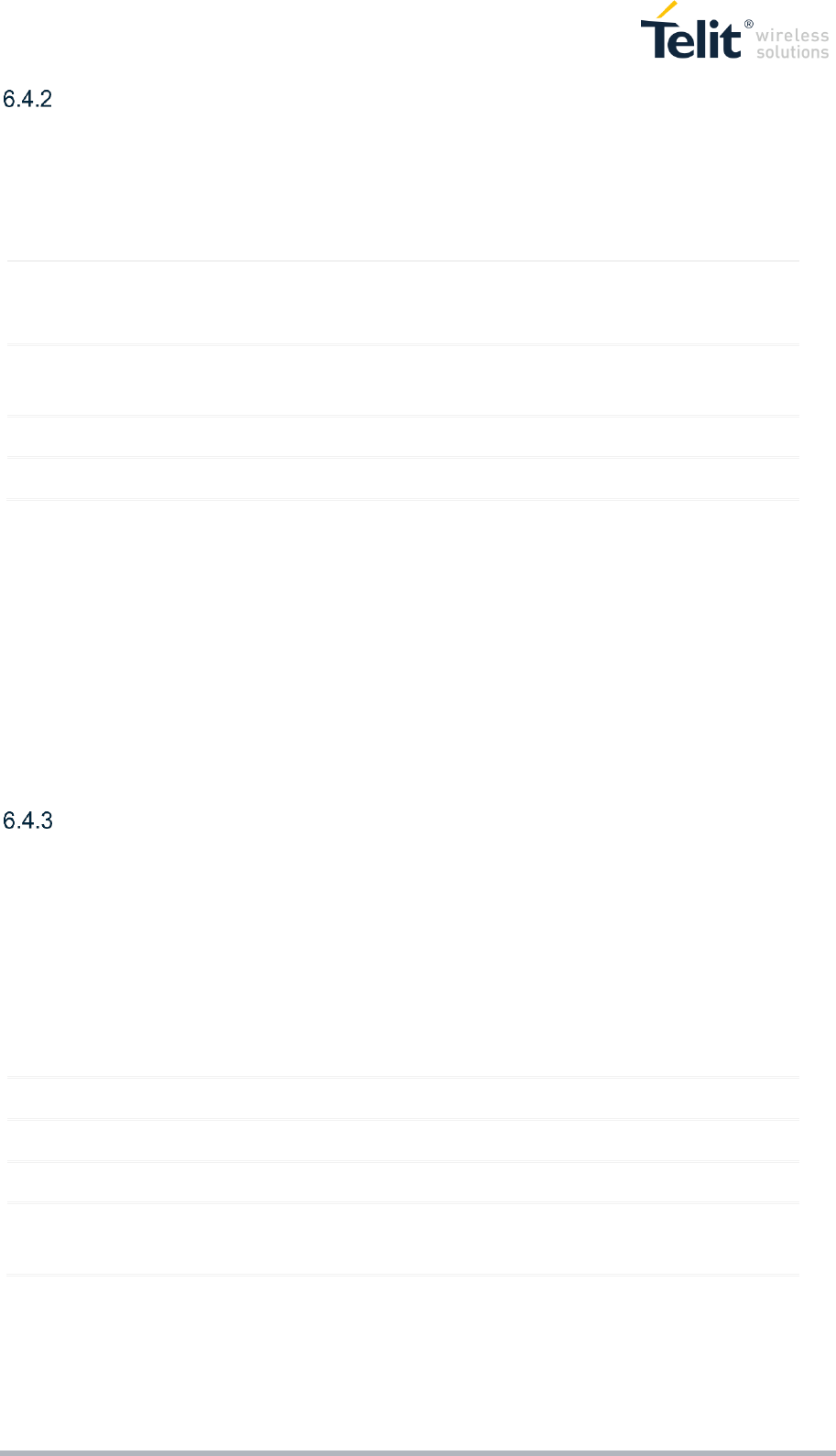
LE866 HARDWARE USER GUIDE 1vv0301210 Rev.0 – Preliminary • 2015-09-02 47 of 68
Reproduction forbidden without Telit Communications PLC written authorization – All Rights Reserved
RX Diversity Antenna
This product is including an input for a second RX antenna to improve the data throughput.
The function is called Antenna Diversity (downlink MIMO) in LTE.
The second Rx antenna should not be located in the close vicinity of main antenna. In order to improve
Diversity Gain, Isolation and reduce mutual interaction, the two antennas should be located at the
maximum reciprocal distance possible, taking into consideration the available space into the application.
For the same reason, the Rx antenna should also be cross-polarized with respect to the main antenna.
Isolation between main antenna and Rx antenna must be at least 10 dB in all uplink frequency bands.
Envelope Correlation Coefficient (ECC) value should be as close as possible to zero, for best diversity
performance. ECC values below 0.5 on all frequency bands are recommended.
PCB design guidelines
When using the LE866, since there's no antenna connector on the module, the antenna must be
connected to the LE866 antenna pad by means of a transmission line implemented on the PCB.
In the case the antenna is not directly connected at the antenna pad of the LE866, then a PCB line is
needed in order to connect with it or with its connector.
This transmission line shall fulfil the following requirements:
The transmission line should be designed according to the following guidelines:
Item
Value
Frequency range
Depending by frequency band(s) provided by the network
operator, the customer shall use the most suitable antenna for
that/those band(s)
Bandwidth
LTE Band IV(1700) : 45 MHz
LTE Band XIII(700) : 10 MHz
Impedance
50 ohm
VSWR recommended
≤ 2:1 (recommended for the best sensitivity performance)
Item
Value
Characteristic Impedance
50 ohm
Max Attenuation
0,3 dB
Coupling
Coupling with other signals shall be avoided
Ground Plane
Cold End (Ground Plane) of antenna shall be equipotential to
the LE866 ground pins
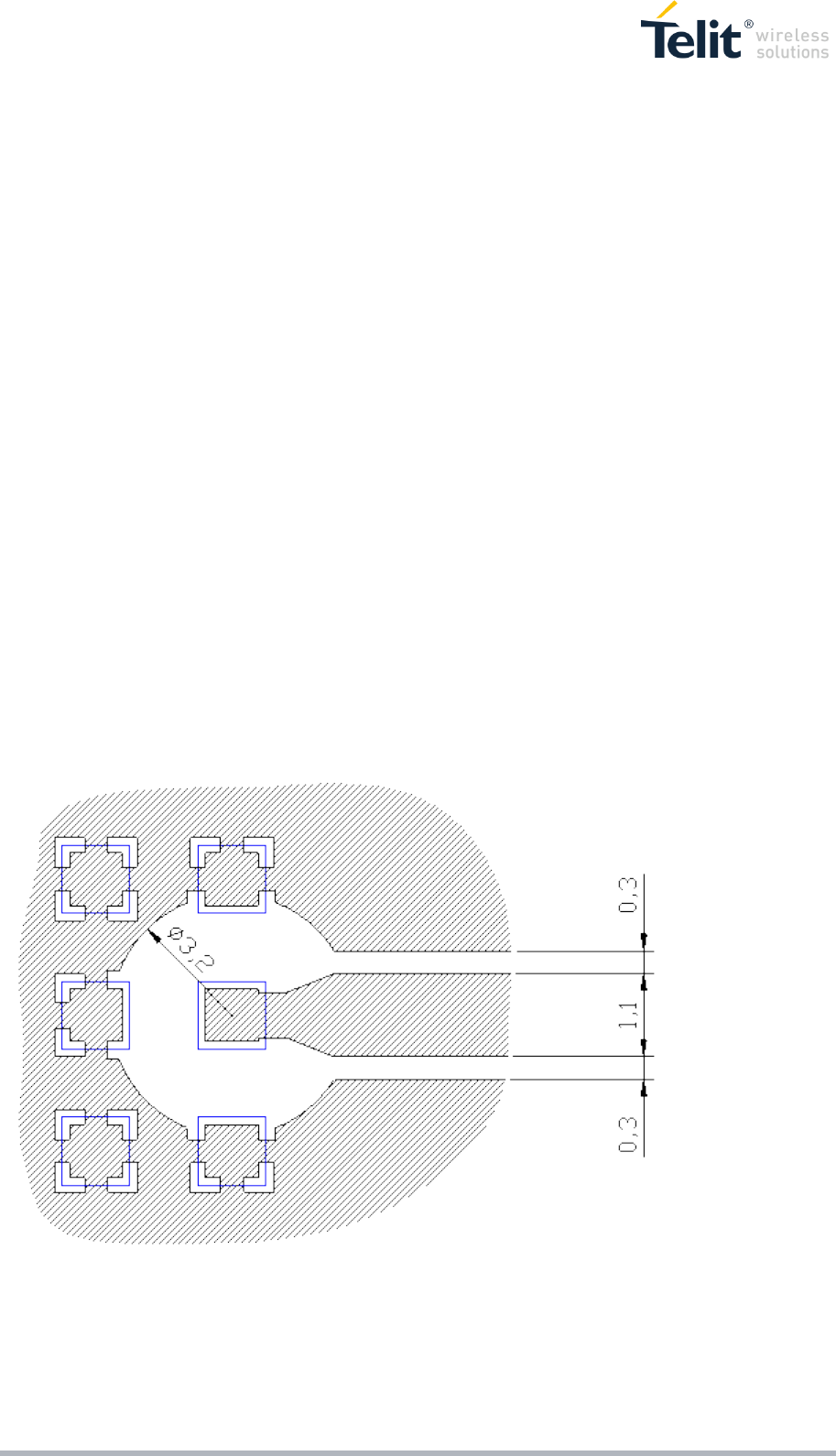
LE866 HARDWARE USER GUIDE 1vv0301210 Rev.0 – Preliminary • 2015-09-02 48 of 68
Reproduction forbidden without Telit Communications PLC written authorization – All Rights Reserved
Ensure that the antenna line impedance is 50 ohm;
Keep the antenna line on the PCB as short as possible, since the antenna line loss shall be
less than 0,3 dB;
Antenna line must have uniform characteristics, constant cross section; avoid meanders and
abrupt curves;
Keep, if possible, one layer of the PCB used only for the Ground plane;
Surround (on the sides, over and under) the antenna line on PCB with Ground, avoid having
other signal tracks facing directly the antenna line track;
The ground around the antenna line on PCB has to be strictly connected to the Ground Plane
by placing vias every 2mm at least;
Place EM noisy devices as far as possible from LE866 antenna line;
Keep the antenna line far away from the LE866 power supply lines;
If you have EM noisy devices around the PCB hosting the LE866, such as fast switching ICs,
take care of the shielding of the antenna line by burying it inside the layers of PCB and
surround it with Ground planes, or shield it with a metal frame cover.
If you don't have EM noisy devices around the PCB of LE866, by using a micro strip on the
superficial copper layer for the antenna line, the line attenuation will be lower than a buried
one;
The following image is showing the suggested layout for the Antenna pad connection:
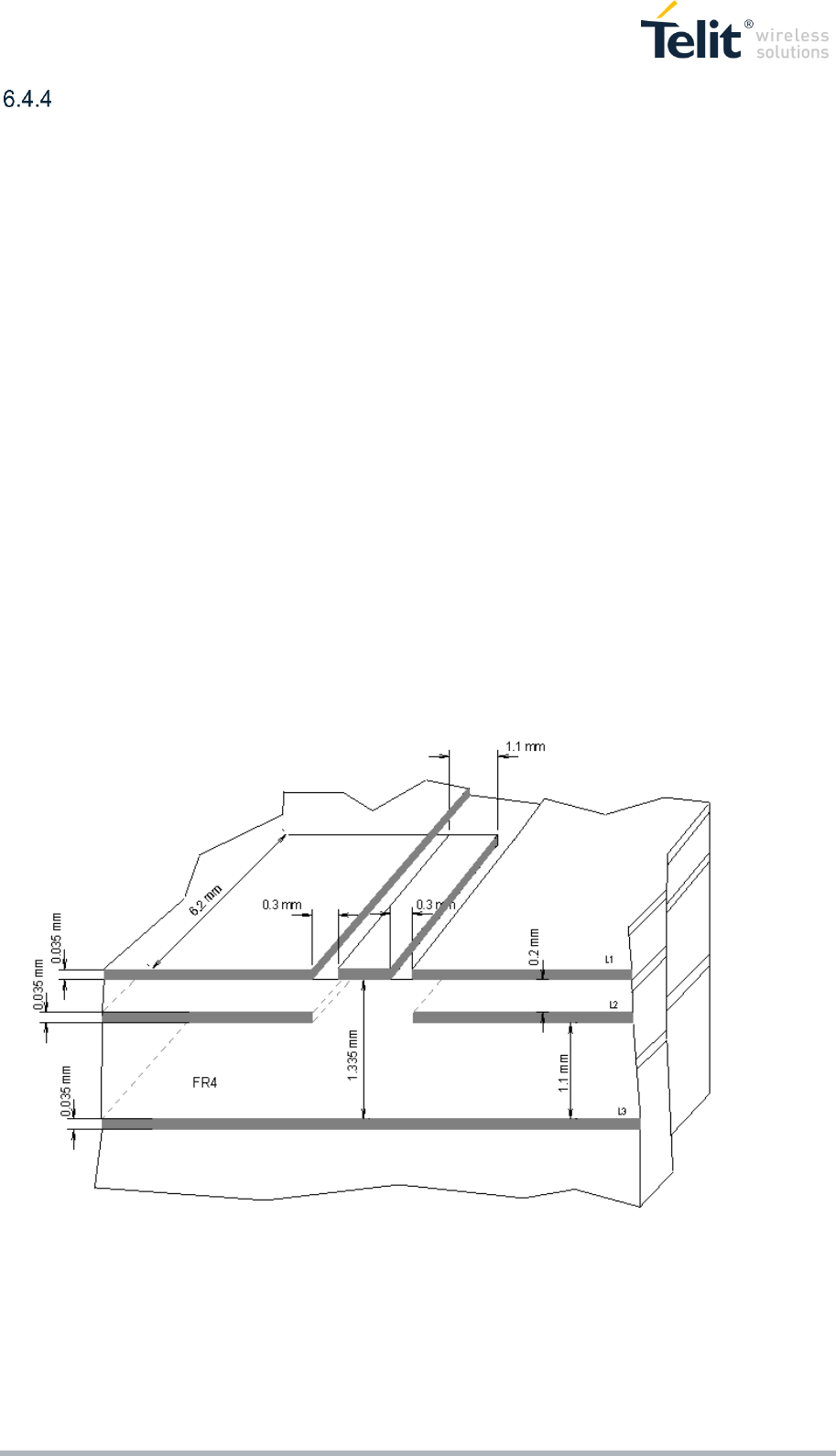
LE866 HARDWARE USER GUIDE 1vv0301210 Rev.0 – Preliminary • 2015-09-02 49 of 68
Reproduction forbidden without Telit Communications PLC written authorization – All Rights Reserved
PCB Guidelines in case of FCC Certification
In the case FCC certification is required for an application using LE866-N3G, according to FCC KDB
996369 for modular approval requirements, the transmission line has to be similar to that implemented
on LE866 interface board and described in the following chapter.
6.4.4.1 Transmission line design
During the design of the LE866 interface board, the placement of components has been chosen
properly, in order to keep the line length as short as possible, thus leading to lowest power losses
possible. A Grounded Coplanar Waveguide (G-CPW) line has been chosen, since this kind of
transmission line ensures good impedance control and can be implemented in an outer PCB layer as
needed in this case. A SMA female connector has been used to feed the line.
The interface board is realized on a FR4, 4-layers PCB. Substrate material is characterized by relative
permittivity εr = 4.6 ± 0.4 @ 1 GHz, TanD= 0.019 ÷ 0.026 @ 1 GHz.
A characteristic impedance of nearly 50 Ω is achieved using trace width = 1.1 mm, clearance from
coplanar ground plane = 0.3 mm each side. The line uses reference ground plane on layer 3, while
copper is removed from layer 2 underneath the line. Height of trace above ground plane is 1.335 mm.
Calculated characteristic impedance is 51.6 Ω, estimated line loss is less than 0.1 dB. The line geometry
is shown below:
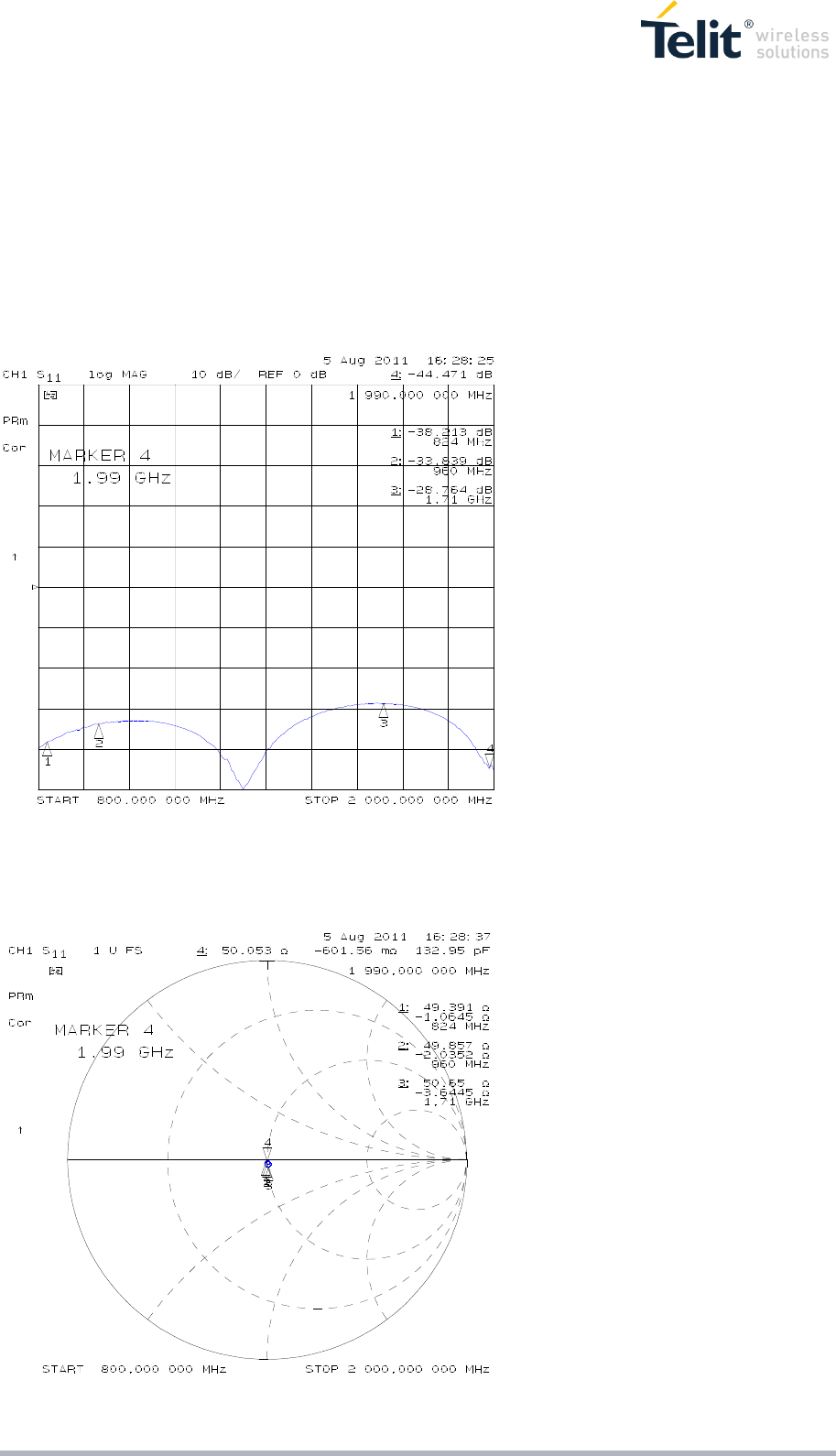
LE866 HARDWARE USER GUIDE 1vv0301210 Rev.0 – Preliminary • 2015-09-02 50 of 68
Reproduction forbidden without Telit Communications PLC written authorization – All Rights Reserved
6.4.4.2 Transmission Line Measurements
An HP8753E VNA (Full-2-port calibration) has been used in this measurement session.
A calibrated coaxial cable has been soldered at the pad corresponding to RF output; a SMA connector
has been soldered to the board in order to characterize the losses of the transmission line including the
connector itself. During Return Loss / impedance measurements, the transmission line has been
terminated to 50 Ω load.
Return Loss plot of line under test is shown below:
Line input impedance (in Smith Chart format, once the line has been terminated to 50 Ω load) is shown
in the following figure:
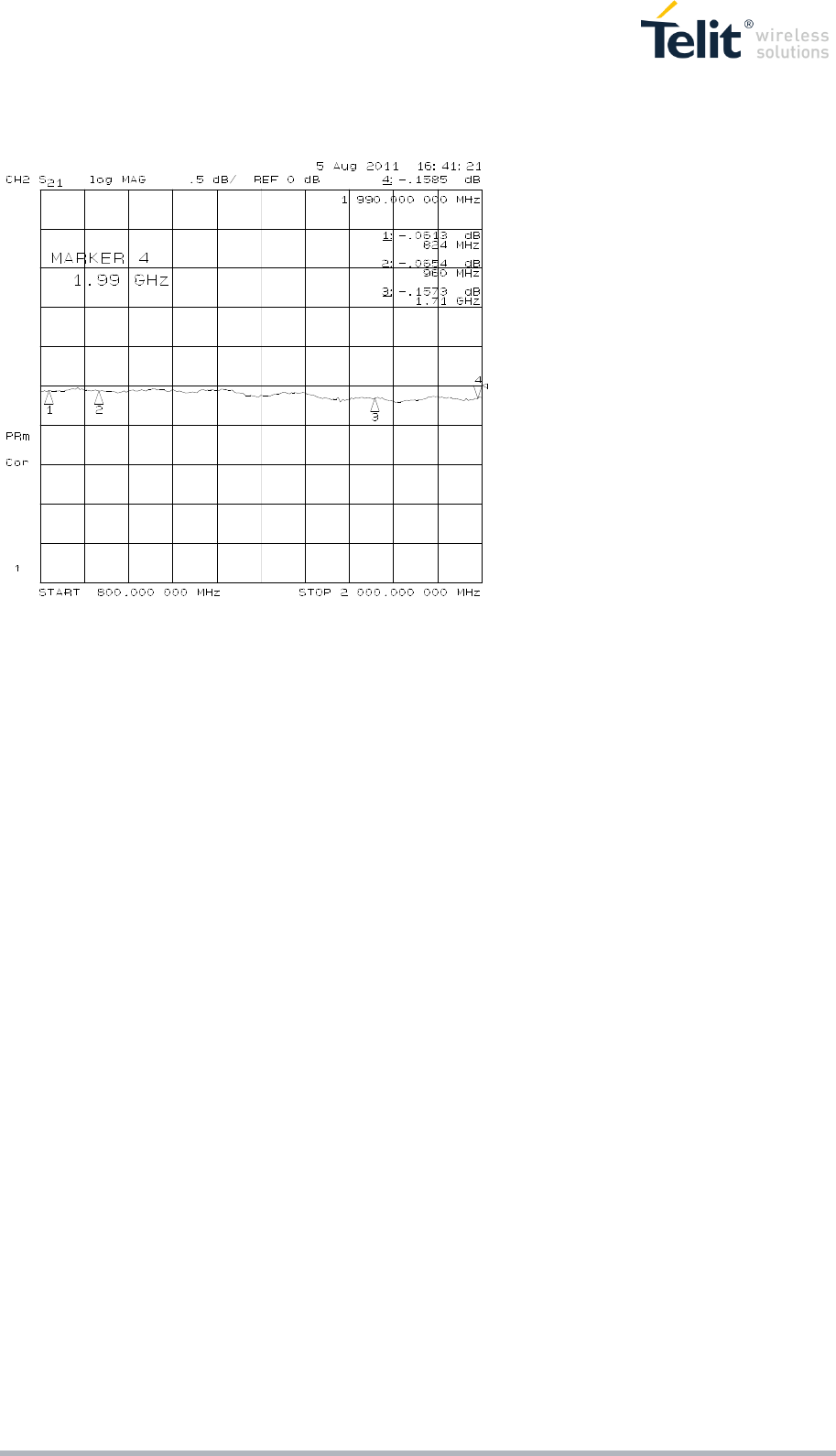
LE866 HARDWARE USER GUIDE 1vv0301210 Rev.0 – Preliminary • 2015-09-02 51 of 68
Reproduction forbidden without Telit Communications PLC written authorization – All Rights Reserved
Insertion Loss of G-CPW line plus SMA connector is shown below:
6.4.4.3 Antenna Installation Guidelines
Install the antenna in a place covered by the LTE signal.
If the device antenna is located farther than 20cm from the human body and there are no co-located
transmitter then the Telit FCC/IC approvals can be re-used by the end product.
If the device antenna is located closer than 20cm from the human body or there are co-located
transmitter then the additional FCC/IC testing may be required for the end product (Telit FCC/IC
approvals cannot be reused).
Antenna shall not be installed inside metal cases.
Antenna shall be installed also according to antenna manufacturer instructions.
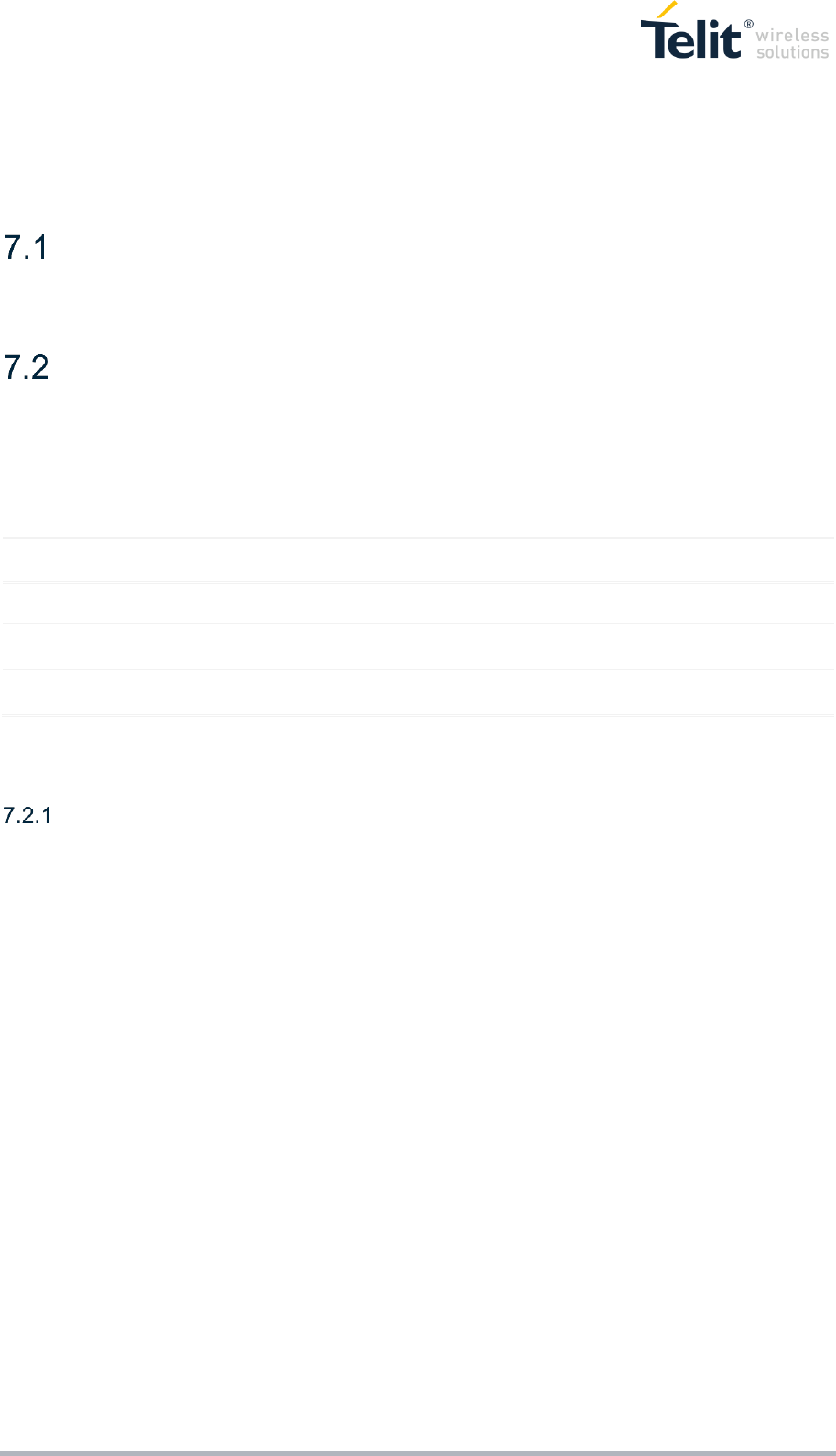
LE866 HARDWARE USER GUIDE 1vv0301210 Rev.0 – Preliminary • 2015-09-02 52 of 68
Reproduction forbidden without Telit Communications PLC written authorization – All Rights Reserved
7 AUDIO SECTION
Overview
The LE866 is provided by one Digital Audio Interface.
Digital Voice Interface
The LE866 Module is provided by one DVI digital voice interface.
The Signals are available on the following Pads and alternate function of the GPIOs:
PAD
Signal
I/O
Function
C5
DVI_WA0
I/O
Digital Voice Interface (Word Alignment / LRCLK)
C6
DVI_RX
I
Digital Voice Interface (RX)
D6
DVI_TX
O
Digital Voice Interface (TX)
D5
DVI_CLK
I/O
Digital Voice Interface (BCLK)
CODEC Examples
Please refer to the Digital Audio Application note.
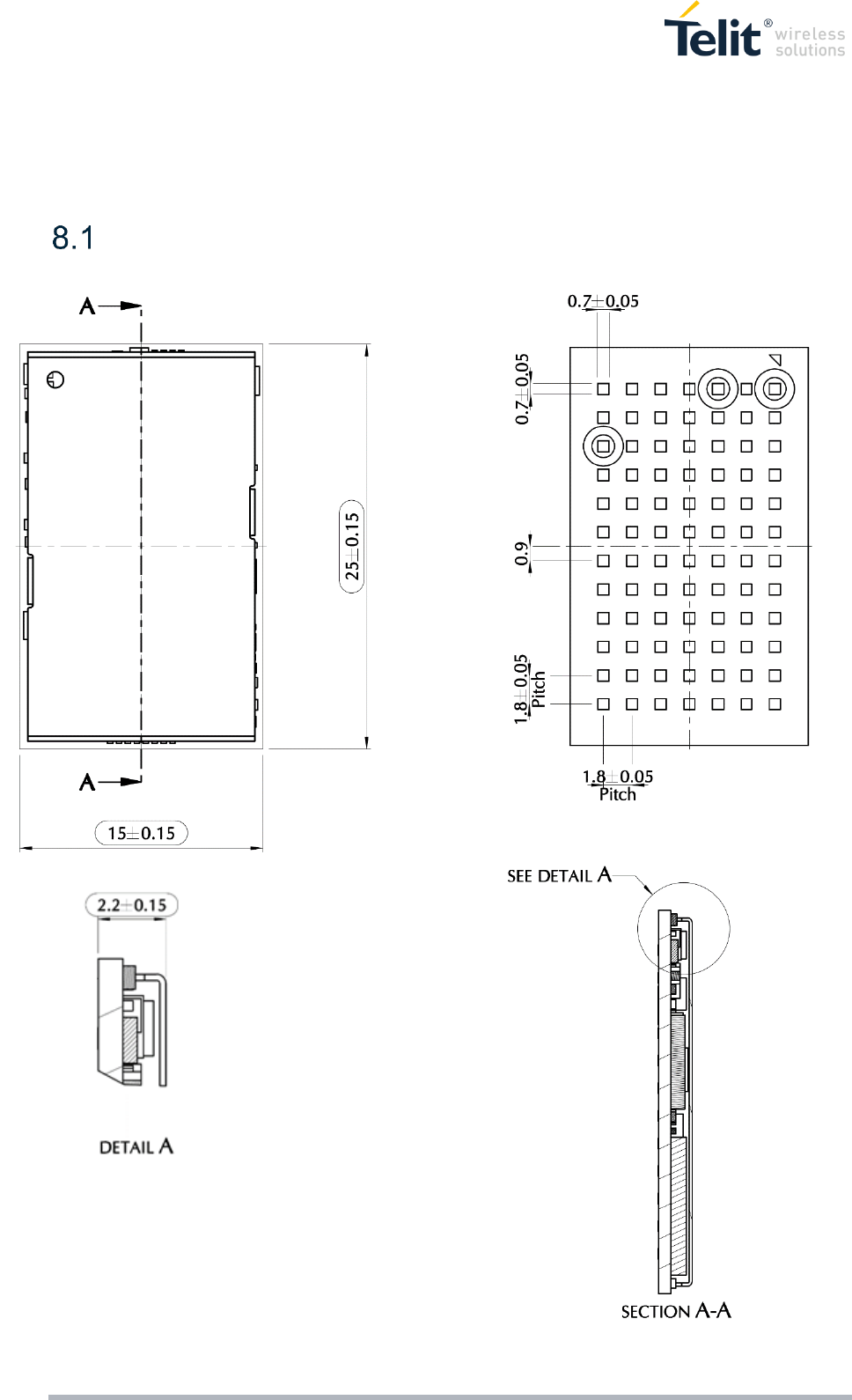
LE866 HARDWARE USER GUIDE 1vv0301210 Rev.0 – Preliminary • 2015-09-02 53 of 68
Reproduction forbidden without Telit Communications PLC written authorization – All Rights Reserved
8 MECHANICAL DESIGN
Drawing
The Dimensions are in mm
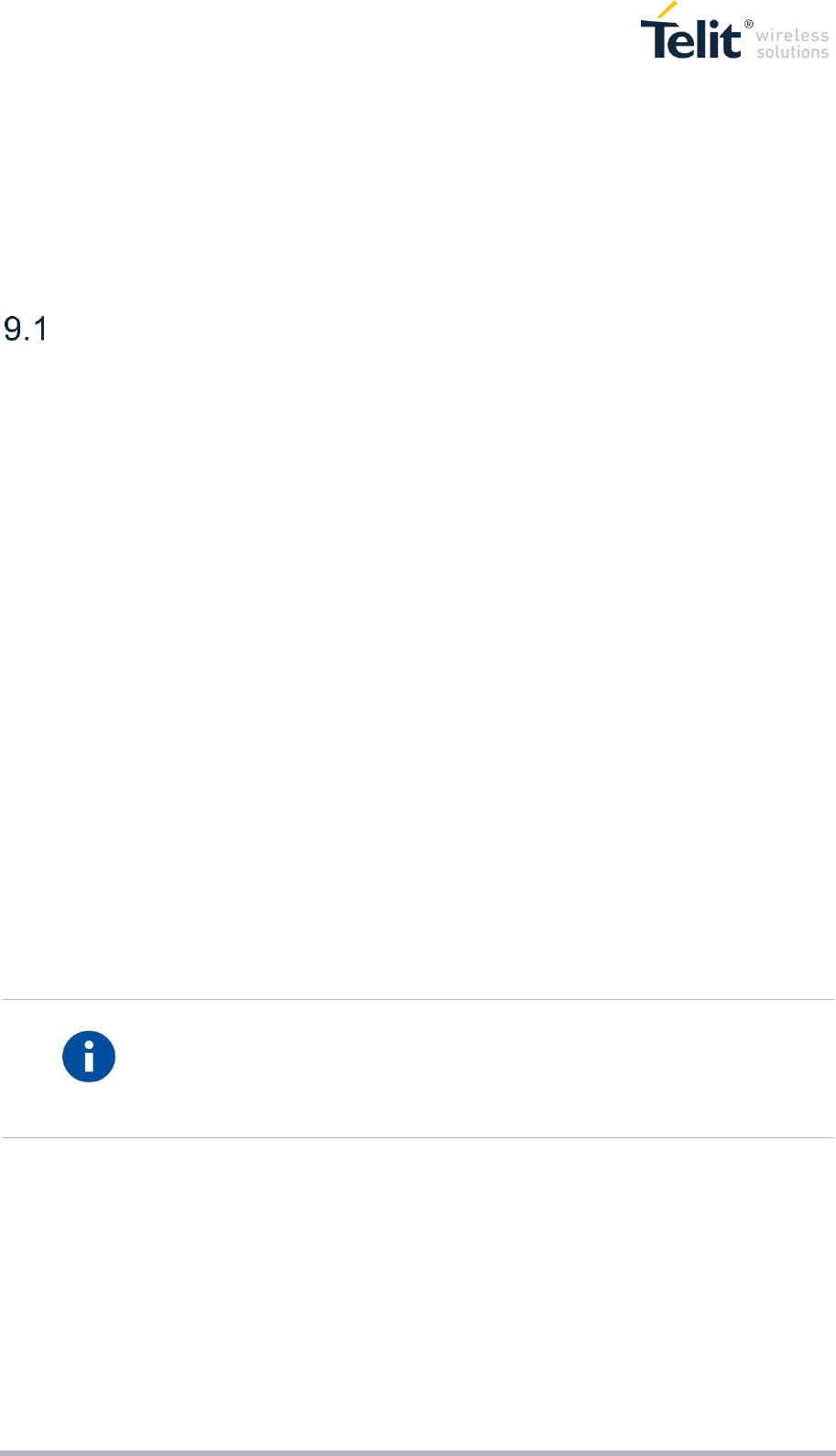
LE866 HARDWARE USER GUIDE 1vv0301210 Rev.0 – Preliminary • 2015-09-02 54 of 68
Reproduction forbidden without Telit Communications PLC written authorization – All Rights Reserved
9 APPLICATION DESIGN
The LE866 modules have been designed in order to be compliant with a standard lead-free SMT
process.
Footprint
TBD
In order to easily rework the LE866 is suggested to consider on the application a 1.5 mm placement
inhibit area around the module.
It is also suggested, as common rule for an SMT component, to avoid having a mechanical part of the
application in direct contact with the module.
NOTE:
In the customer application, the region under WIRING INHIBIT (see figure
above) must be clear from signal or ground paths.
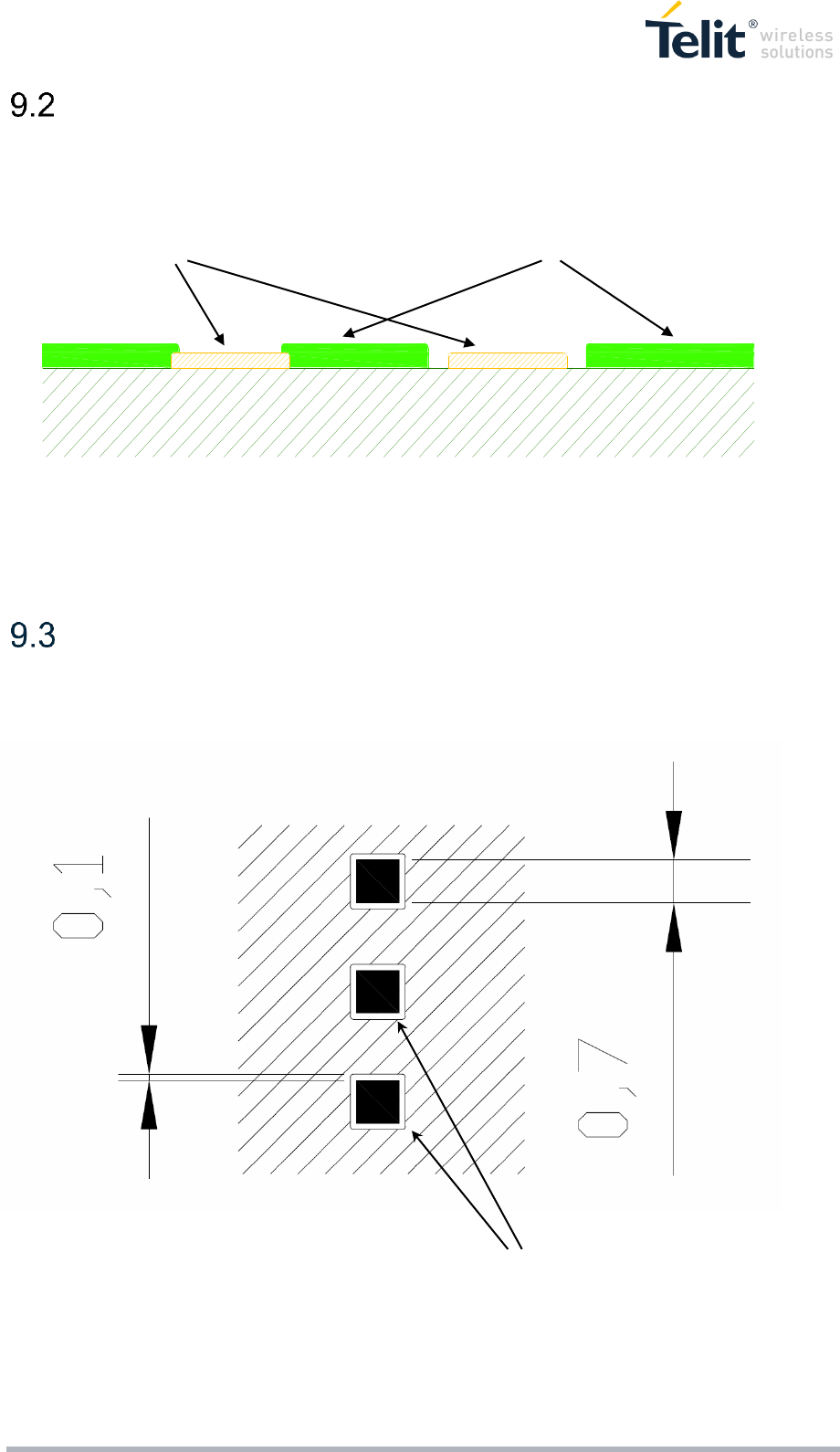
LE866 HARDWARE USER GUIDE 1vv0301210 Rev.0 – Preliminary • 2015-09-02 55 of 68
Reproduction forbidden without Telit Communications PLC written authorization – All Rights Reserved
PCB pad design
Non solder mask defined (NSMD) type is recommended for the solder pads on the PCB.
PCB pad dimensions
The recommendation for the PCB pads dimensions are described in the following image (dimensions in
mm)
Solder resist openings
PCB
Copper Pad
Solder Mask
SMD
(Solder Mask Defined)
NSMD
(Non Solder Mask Defined)
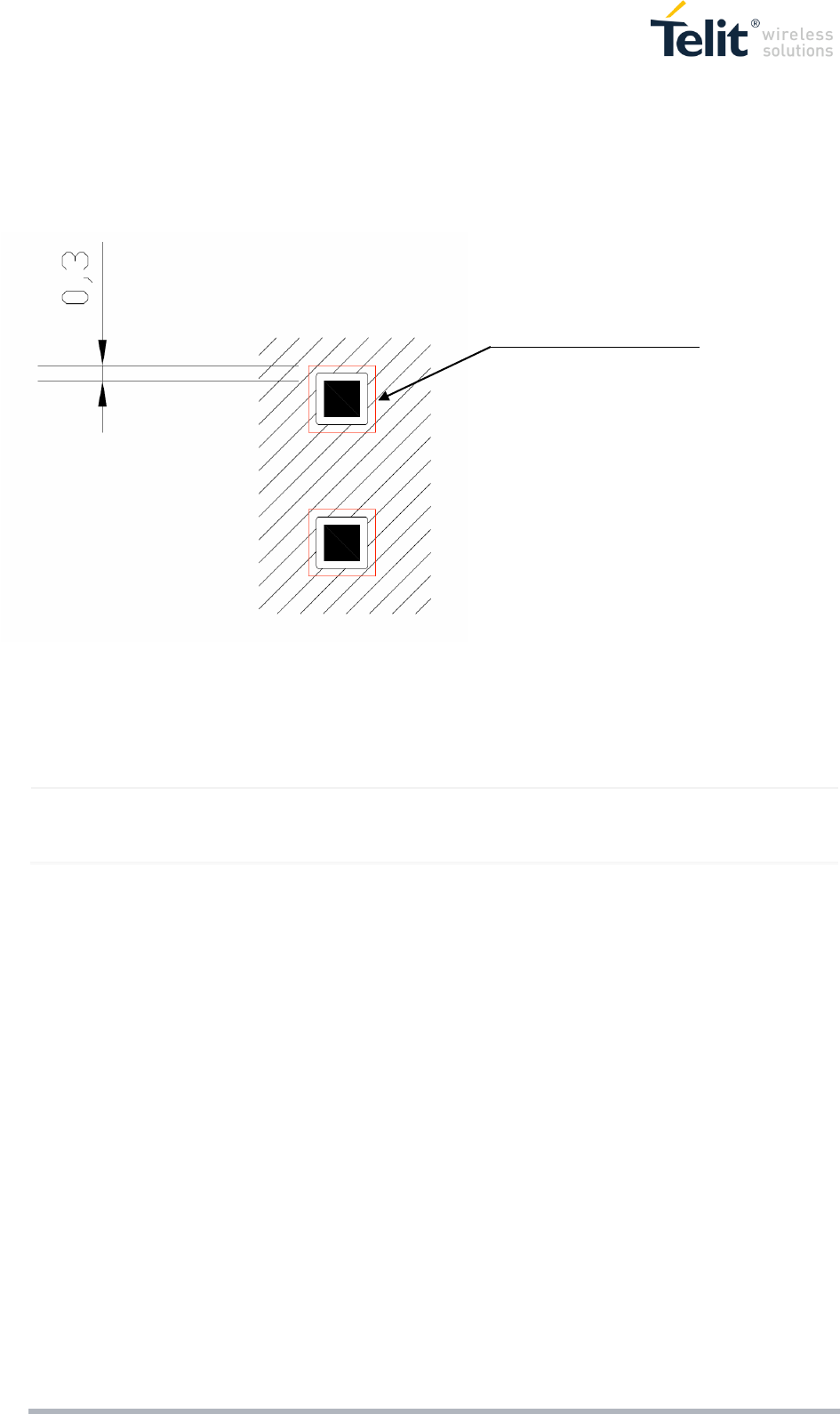
LE866 HARDWARE USER GUIDE 1vv0301210 Rev.0 – Preliminary • 2015-09-02 56 of 68
Reproduction forbidden without Telit Communications PLC written authorization – All Rights Reserved
It is not recommended to place via or micro-via not covered by solder resist in an area of 0,3 mm around
the pads unless it carries the same signal of the pad itself
(see following figure).
Holes in pad are allowed only for blind holes and not for through holes.
Recommendations for PCB pad surfaces:
Finish
Layer Thickness (um)
Properties
Electro-less Ni / Immersion Au
3 –7 / 0.05 – 0.15
good solder ability protection,
high shear force values
The PCB must be able to resist the higher temperatures which are occurring at the lead-free process.
This issue should be discussed with the PCB-supplier. Generally, the wettability of tin-lead solder paste
on the described surface plating is better compared to lead-free solder paste.
It is not necessary to panel the application’s PCB, however in that case it is suggested to use milled
contours and predrilled board breakouts; scoring or v-cut solutions are not recommended.
Inhibit area for micro-via
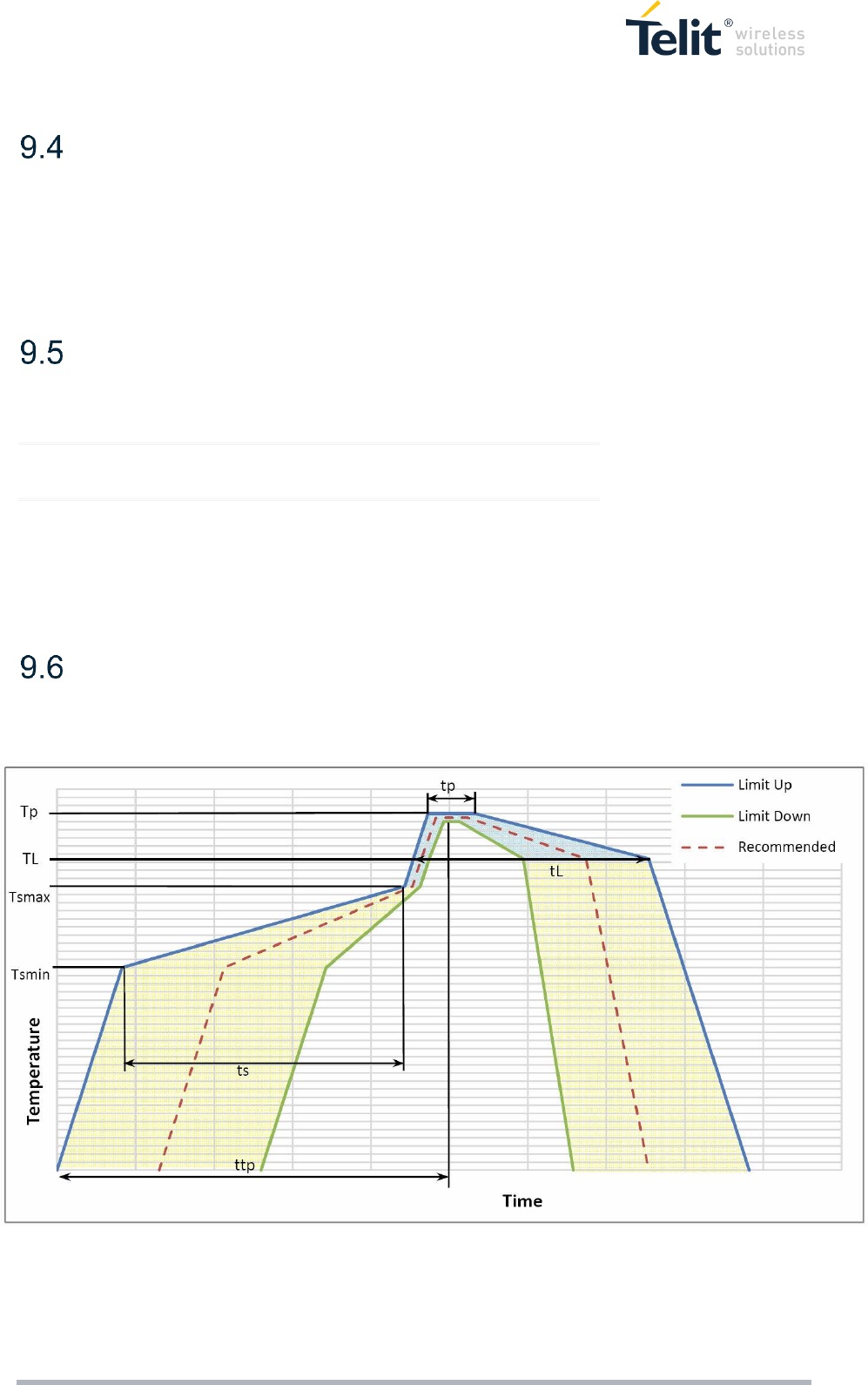
LE866 HARDWARE USER GUIDE 1vv0301210 Rev.0 – Preliminary • 2015-09-02 57 of 68
Reproduction forbidden without Telit Communications PLC written authorization – All Rights Reserved
Stencil
Stencil’s apertures layout can be the same of the recommended footprint (1:1), we suggest a thickness
of stencil foil ≥ 120 µm.
Solder paste
Item
Lead Free
Solder Paste
Sn/Ag/Cu
We recommend using only “no clean” solder paste in order to avoid the cleaning of the modules after
assembly.
Solder reflow
Recommended solder reflow profile:
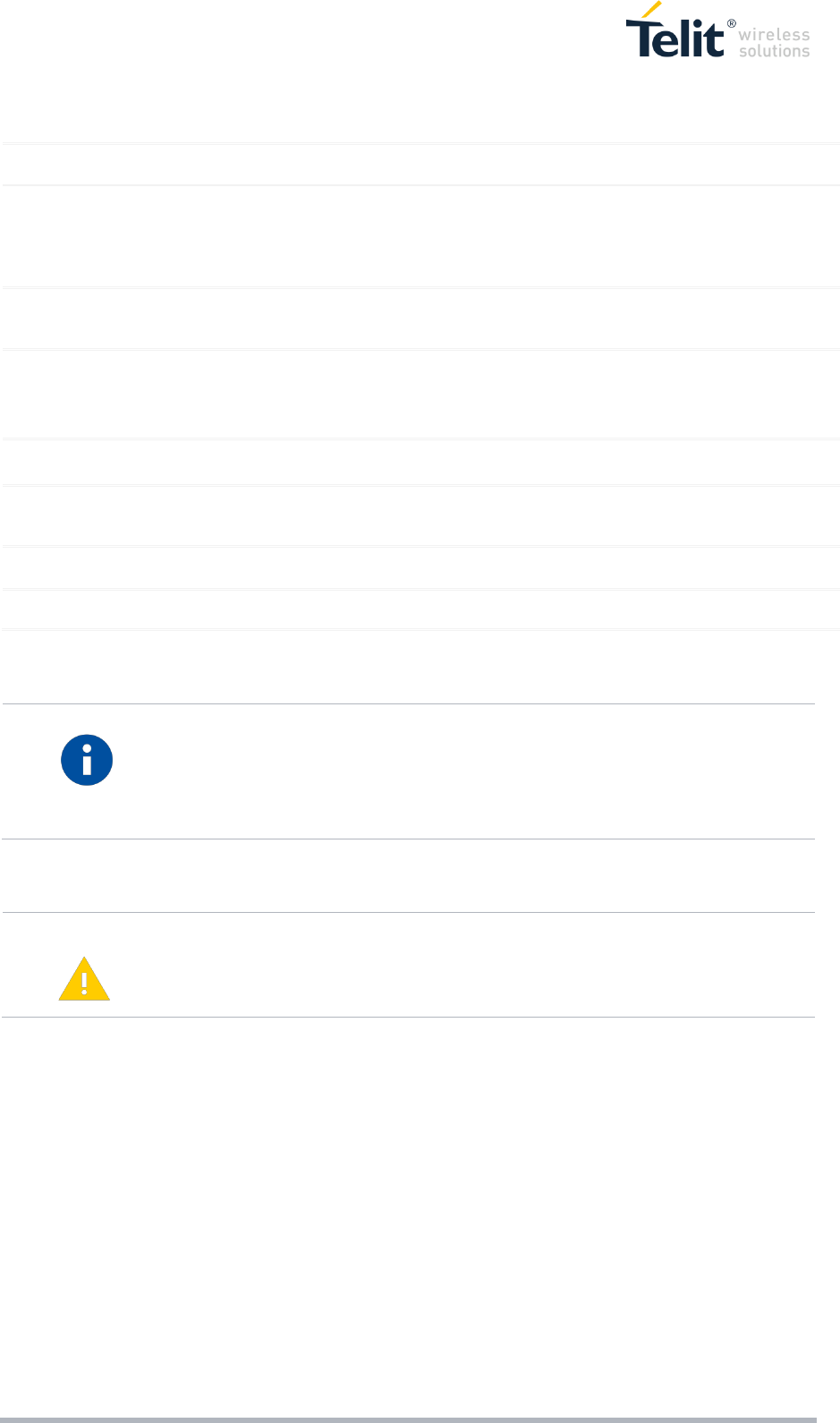
LE866 HARDWARE USER GUIDE 1vv0301210 Rev.0 – Preliminary • 2015-09-02 58 of 68
Reproduction forbidden without Telit Communications PLC written authorization – All Rights Reserved
Profile Feature
Pb-Free Assembly
Average ramp-up rate (TL to TP)
3°C/second max
Preheat
– Temperature Min (Tsmin)
– Temperature Max (Tsmax)
– Time (min to max) (ts)
150°C
200°C
60-180 seconds
Tsmax to TL
– Ramp-up Rate
3°C/second max
Time maintained above:
– Temperature (TL)
– Time (tL)
217°C
60-150 seconds
Peak Temperature (Tp)
245 +0/-5°C
Time within 5°C of actual Peak
Temperature (tp)
10-30 seconds
Ramp-down Rate
6°C/second max.
Time 25°C to Peak Temperature
8 minutes max.
NOTE:
All temperatures refer to topside of the package, measured on the package body
surface
WARNING:
THE LE866 MODULE WITHSTANDS ONE REFLOW PROCESS ONLY.
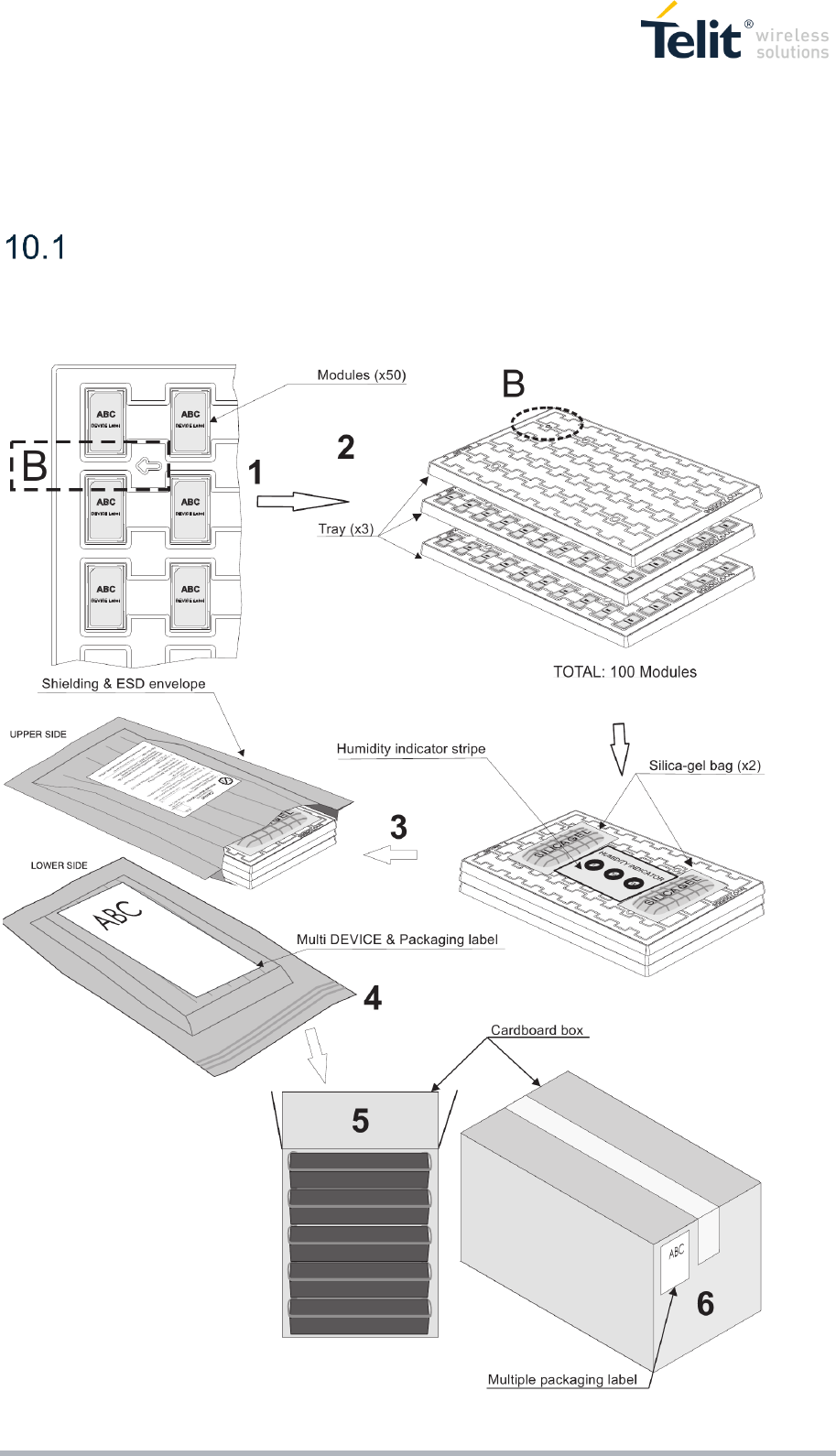
LE866 HARDWARE USER GUIDE 1vv0301210 Rev.0 – Preliminary • 2015-09-02 59 of 68
Reproduction forbidden without Telit Communications PLC written authorization – All Rights Reserved
10 PACKAGING
Tray
The LE866 modules are packaged on trays of 20 pieces each. These trays can be used in SMT
processes for pick & place handling.
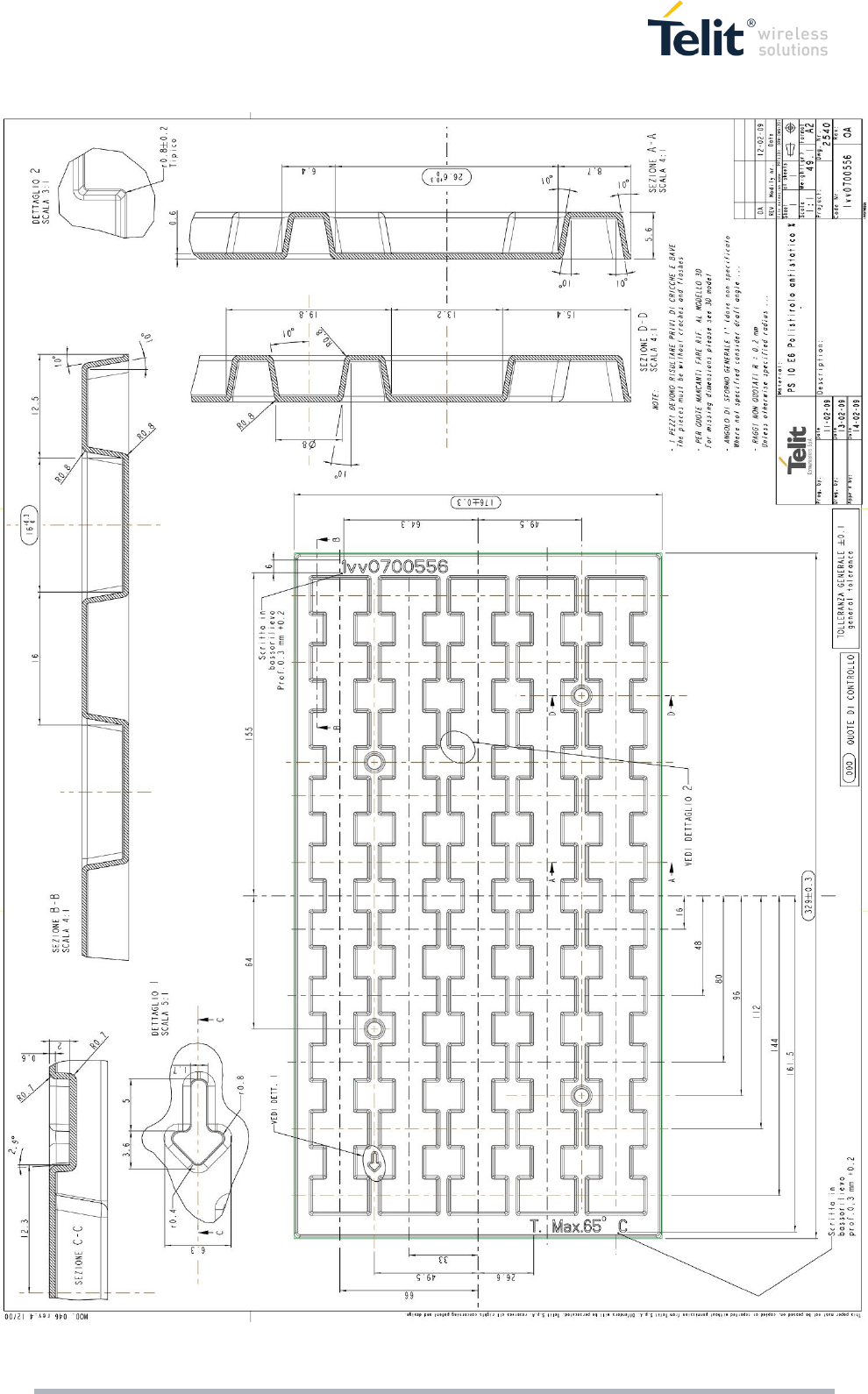
LE866 HARDWARE USER GUIDE 1vv0301210 Rev.0 – Preliminary • 2015-09-02 60 of 68
Reproduction forbidden without Telit Communications PLC written authorization – All Rights Reserved

LE866 HARDWARE USER GUIDE 1vv0301210 Rev.0 – Preliminary • 2015-09-02 61 of 68
Reproduction forbidden without Telit Communications PLC written authorization – All Rights Reserved
Moisture sensitivity
The LE866 is a Moisture Sensitive Device level 3, in according with standard IPC/JEDEC J-STD-020,
take care all the relatives requirements for using this kind of components.
Moreover, the customer has to take care of the following conditions:
a) Calculated shelf life in sealed bag: 12 months at <40°C and <90% relative humidity (RH).
b) Environmental condition during the production: 30°C / 60% RH according to IPC/JEDEC J-STD-033A
paragraph 5.
c) The maximum time between the opening of the sealed bag and the reflow process must be 168 hours
if condition b) “IPC/JEDEC J-STD-033A paragraph 5.2” is respected
d) Baking is required if conditions b) or c) are not respected
e) Baking is required if the humidity indicator inside the bag indicates 10% RH
or more

LE866 HARDWARE USER GUIDE 1vv0301210 Rev.0 – Preliminary • 2015-09-02 62 of 68
Reproduction forbidden without Telit Communications PLC written authorization – All Rights Reserved
11 SAFETY
RECOMMANDATIONS
READ CAREFULLY
Be sure the use of this product is allowed in the country and in the environment required. The use of
this product may be dangerous and has to be avoided in the following areas:
Where it can interfere with other electronic devices in environments such as hospitals, airports, aircrafts,
etc
Where there is risk of explosion such as gasoline stations, oil refineries, etc
It is responsibility of the user to enforce the country regulation and the specific environment regulation.
Do not disassemble the product; any mark of tampering will compromise the warranty validity.
We recommend following the instructions of the hardware user guides for a correct wiring of the product.
The product has to be supplied with a stabilized voltage source and the wiring has to be conforming to
the security and fire prevention regulations.
The product has to be handled with care, avoiding any contact with the pins because electrostatic
discharges may damage the product itself. Same cautions have to be taken for the SIM, checking
carefully the instruction for its use. Do not insert or remove the SIM when the product is in power saving
mode.
The system integrator is responsible of the functioning of the final product; therefore, care has to be
taken to the external components of the module, as well as of any project or installation issue, because
the risk of disturbing the LTE network or external devices or having impact on the security. Should there
be any doubt, please refer to the technical documentation and the regulations in force.
Every module has to be equipped with a proper antenna with specific characteristics. The antenna has
to be installed with care in order to avoid any interference with other electronic devices and has to
guarantee a minimum distance from the body (20 cm). In case of this requirement cannot be satisfied,
the system integrator has to assess the final product against the SAR regulation.
The European Community provides some Directives for the electronic equipments introduced on the
market. All the relevant information’s are available on the European Community website:
http://europa.eu.int/comm/enterprise/rtte/dir99-5.htm
The text of the Directive 99/05 regarding telecommunication equipments is available, while the
applicable Directives (Low Voltage and EMC) are available at:
http://europa.eu.int/comm/enterprise/electr_equipment/index_en.htm

LE866 HARDWARE USER GUIDE 1vv0301210 Rev.0 – Preliminary • 2015-09-02 63 of 68
Reproduction forbidden without Telit Communications PLC written authorization – All Rights Reserved
12 FCC/IC REGULATORY
NOTICES
Modification statement
Telit has not approved any changes or modifications to this device by the user. Any changes or
modifications could void the user’s authority to operate the equipment.
Telit n’approuve aucune modification apportée à l’appareil par l’utilisateur, quelle qu’en soit la nature.
Tout changement ou modification peuvent annuler le droit d’utilisation de l’appareil par l’utilisateur.
Interference statement
This device complies with Part 15 of the FCC Rules and Industry Canada licence-exempt RSS
standard(s). Operation is subject to the following two conditions: (1) this device may not cause
interference, and (2) this device must accept any interference, including interference that may cause
undesired operation of the device.
Le présent appareil est conforme aux CNR d'Industrie Canada applicables aux appareils radio exempts
de licence. L'exploitation est autorisée aux deux conditions suivantes : (1) l'appareil ne doit pas produire
de brouillage, et (2) l'utilisateur de l'appareil doit accepter tout brouillage radioélectrique subi, même si
le brouillage est susceptible d'en compromettre le fonctionnement.
Wireless notice
This equipment complies with FCC and IC radiation exposure limits set forth for an uncontrolled
environment. The antenna should be installed and operated with minimum distance of 20 cm between
the radiator and your body. Antenna gain must be below:
Frequency Band
Gain
Band 4 (1700 MHz)
TBD
Band 13 (700 MHz)
TBD
This transmitter must not be co-located or operating in conjunction with any other antenna or transmitter.

LE866 HARDWARE USER GUIDE 1vv0301210 Rev.0 – Preliminary • 2015-09-02 64 of 68
Reproduction forbidden without Telit Communications PLC written authorization – All Rights Reserved
Cet appareil est conforme aux limites d'exposition aux rayonnements de la IC pour un environnement
non contrôlé. L'antenne doit être installé de façon à garder une distance minimale de 20 centimètres
entre la source de rayonnements et votre corps. Gain de l'antenne doit être ci-dessous:
Bande de fréquence
Gain
Band 4 (1700 MHz)
TBD
Band 13 (700 MHz)
TBD
L'émetteur ne doit pas être colocalisé ni fonctionner conjointement avec à autre antenne ou autre
émetteur.
FCC Class B digital device notice
This equipment has been tested and found to comply with the limits for a Class B digital device, pursuant
to part 15 of the FCC Rules. These limits are designed to provide reasonable protection against harmful
interference in a residential installation. This equipment generates, uses and can radiate radio frequency
energy and, if not installed and used in accordance with the instructions, may cause harmful interference
to radio communications. However, there is no guarantee that interference will not occur in a particular
installation. If this equipment does cause harmful interference to radio or television reception, which can
be determined by turning the equipment off and on, the user is encouraged to try to correct the
interference by one or more of the following measures:
Reorient or relocate the receiving antenna.
Increase the separation between the equipment and receiver.
Connect the equipment into an outlet on a circuit different from that to which the receiver is connected.
Consult the dealer or an experienced radio/TV technician for help.
Labelling Requirements for the Host device
The host device shall be properly labelled to identify the modules within the host device. The certification
label of the module shall be clearly visible at all times when installed in the host device, otherwise the
host device must be labelled to display the FCC ID and IC of the module, preceded by the words
"Contains transmitter module", or the word "Contains", or similar wording expressing the same meaning,
as follows:
Contains FCC ID: RI7LE866SV1
Contains IC: 5131A-LE866SV1

LE866 HARDWARE USER GUIDE 1vv0301210 Rev.0 – Preliminary • 2015-09-02 65 of 68
Reproduction forbidden without Telit Communications PLC written authorization – All Rights Reserved
L'appareil hôte doit être étiqueté comme il faut pour permettre l'identification des modules qui s'y
trouvent. L'étiquette de certification du module donné doit être posée sur l'appareil hôte à un endroit
bien en vue en tout temps. En l'absence d'étiquette, l'appareil hôte doit porter une étiquette donnant le
FCC ID et le IC du module, précédé des mots « Contient un module d'émission », du mot « Contient »
ou d'une formulation similaire exprimant le même sens, comme suit :
Contains FCC ID: RI7LE866SV1
Contains IC: 5131A-LE866SV1
CAN ICES-3 (B) / NMB-3 (B)
This Class B digital apparatus complies with Canadian ICES-003.
Cet appareil numérique de classe B est conforme à la norme canadienne ICES-003.

LE866 HARDWARE USER GUIDE 1vv0301210 Rev.0 – Preliminary • 2015-09-02 66 of 68
Reproduction forbidden without Telit Communications PLC written authorization – All Rights Reserved
13 DOCUMENT HISTORY
Revisions
Revision
Date
Changes
0
2015-03-27
Preliminary Version
1
2015-09-02
Updated chapters 3.1, 3.1.1
